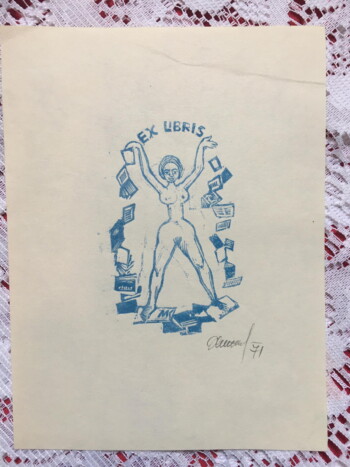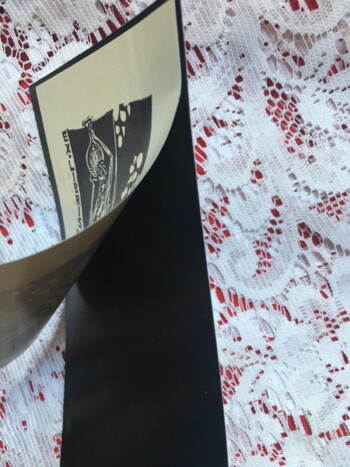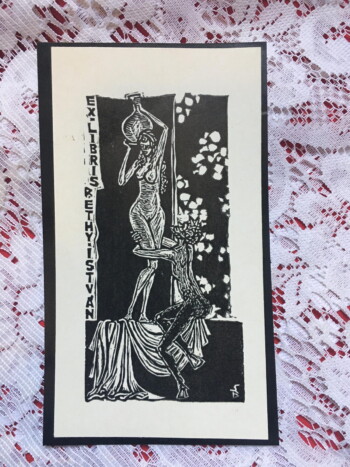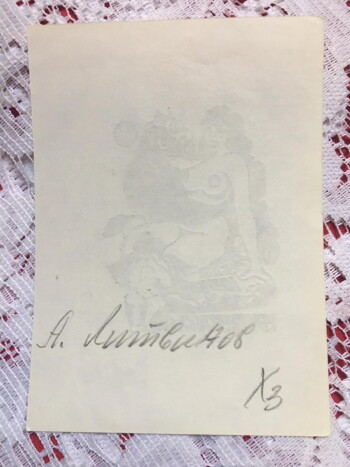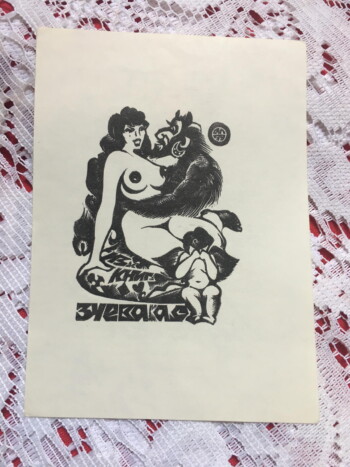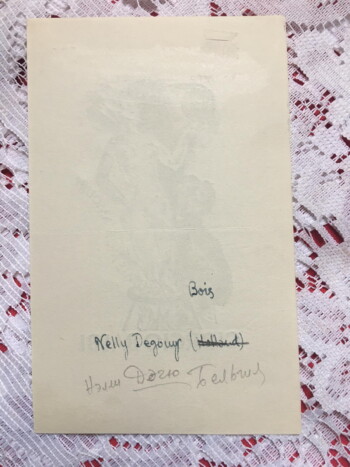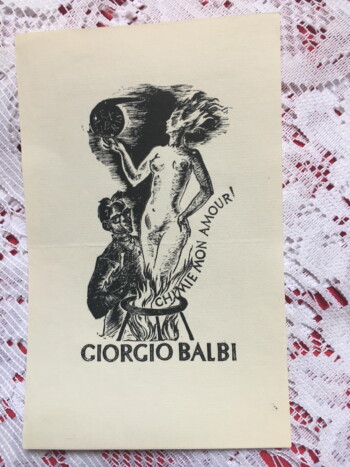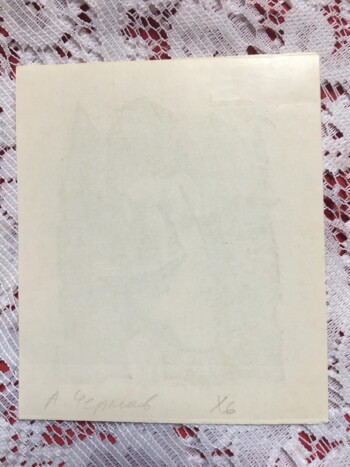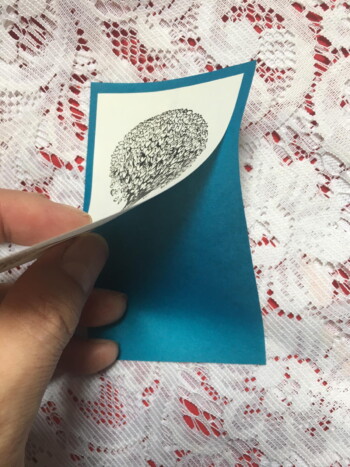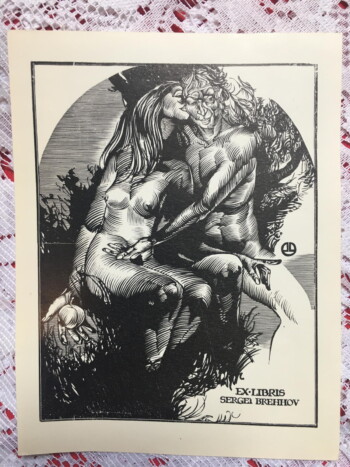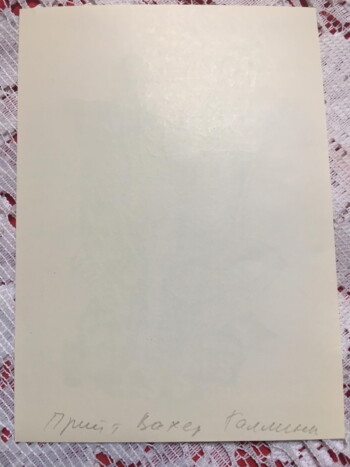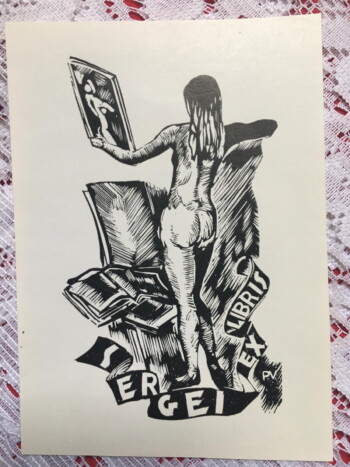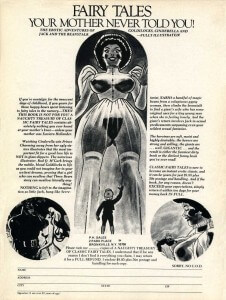-
Out of stock

 2.25" x 2.75" Shackle Antique hand-forged iron shackles from a farm in Bulgaria. They have been cleaned up and seasoned much like you'd season your cast iron skillet (repeatedly coated with oil and baked). No key is needed as they lock using a puzzle design.
2.25" x 2.75" Shackle Antique hand-forged iron shackles from a farm in Bulgaria. They have been cleaned up and seasoned much like you'd season your cast iron skillet (repeatedly coated with oil and baked). No key is needed as they lock using a puzzle design. -
 Memoirs of Fanny Hill, John Cleland (Privately Printed, The Kamashastra Society, 1907 [likely pirated copy of the Paris Kamashastra edition, likely clandestinely printed in the US, c. 1920-30s]) 8.75" X 5.75", 287pp, hardbound no DJ, top edge dyed blue, fair condition, binding good, boards are loose but holding. Written while the author was in debtor's prison in London and first published in 1748, Fanny Hill is considered the first original English prose pornography, and the first pornography to use the form of the novel. One of the most prosecuted and banned books in history, it has become a synonym for obscenity. The title page is printed in black with green decorations. The contents mirror the Carrington versions of the book, reformatted and lacking the plates. The title is in black (not black and green as other Kamashastra editions) This leads me to believe that it is a likely US pirate of the Kamashastra (which is, itself a pirate of the Carrington version).
Memoirs of Fanny Hill, John Cleland (Privately Printed, The Kamashastra Society, 1907 [likely pirated copy of the Paris Kamashastra edition, likely clandestinely printed in the US, c. 1920-30s]) 8.75" X 5.75", 287pp, hardbound no DJ, top edge dyed blue, fair condition, binding good, boards are loose but holding. Written while the author was in debtor's prison in London and first published in 1748, Fanny Hill is considered the first original English prose pornography, and the first pornography to use the form of the novel. One of the most prosecuted and banned books in history, it has become a synonym for obscenity. The title page is printed in black with green decorations. The contents mirror the Carrington versions of the book, reformatted and lacking the plates. The title is in black (not black and green as other Kamashastra editions) This leads me to believe that it is a likely US pirate of the Kamashastra (which is, itself a pirate of the Carrington version). -
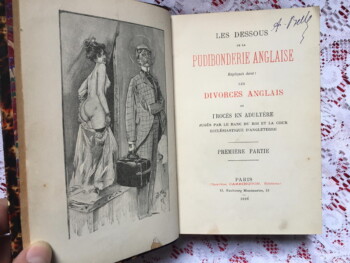
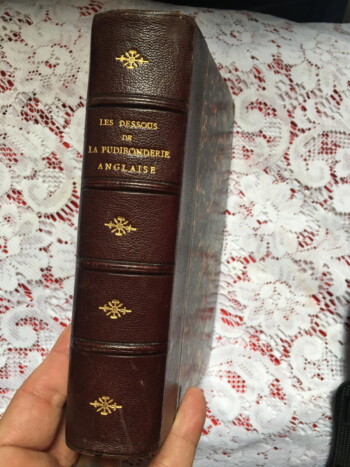 Les dessous de la pudibonderie anglaise expliqués dans les divorces anglais, ou procès en adultère jugés par le banc du Roi et la Cour Ecclésiastique d'Angleterre [trans. The Basics of English Prudishness Explained in English Divorces, or Adultery Trial Judged by the King's Bench and the Ecclesiastical Court of England], anonymous [most like Carrington himself as editor/compiler], illustrations Jacques Wely (Charles Carrington, Paris, 1898, first edition) 7.5"x5", 2 volumes in one, xxiv-108, xxx-287-xii, quarter morocco over marbled boards, 4 raised bands, gilt titles and decoration on spine, marbled endpapers, great condition, previous owners name on title page, some bumping to corners. According to the British Library this is a compilation of entries from "Trials for Adultry" [Trials for Adultery: or, the History of Divorces. Being Select Trials at Doctors Commons, for Adultery, Cruelty, Fornication, Impotence, &c. From the Year 1760, to the present Time. Including the whole of the Evidence on each Cause. Together with The Letters, &c. that have been intercepted between the amorous Parties… Taken in Short-Hand , by a Civilian. London: Printed for S. Bladon, 1779-1780] which, as the full title suggests, is considered one of the Earliest of "The Genre of Pornographic Trial Reports". Also present are excerpts from some English plays. According to Yale, this compillation also "Contains case histories from: Crim. con. biography attributed to Francis Plowden." London, 1798. Criminal conversation, commonly known as crim. con., is a tort arising from adultery, abolished in almost all jurisdictions. (Conversation is an old expression for sexual intercourse that is obsolete except as part of this term.) As far as we can tell, this is a book compiled and edited by Carrington. Carrington himself was an Englishman, a Londoner who was married to a woman from France. He published this book a few years after the couple left London and moved to Paris, presumably so he would have more freedom to publish books that London would have no doubt considered pornography. This book is a case study of the prudishness of the English and it uses salacious material taken from various sources listed above to prove the point.
Les dessous de la pudibonderie anglaise expliqués dans les divorces anglais, ou procès en adultère jugés par le banc du Roi et la Cour Ecclésiastique d'Angleterre [trans. The Basics of English Prudishness Explained in English Divorces, or Adultery Trial Judged by the King's Bench and the Ecclesiastical Court of England], anonymous [most like Carrington himself as editor/compiler], illustrations Jacques Wely (Charles Carrington, Paris, 1898, first edition) 7.5"x5", 2 volumes in one, xxiv-108, xxx-287-xii, quarter morocco over marbled boards, 4 raised bands, gilt titles and decoration on spine, marbled endpapers, great condition, previous owners name on title page, some bumping to corners. According to the British Library this is a compilation of entries from "Trials for Adultry" [Trials for Adultery: or, the History of Divorces. Being Select Trials at Doctors Commons, for Adultery, Cruelty, Fornication, Impotence, &c. From the Year 1760, to the present Time. Including the whole of the Evidence on each Cause. Together with The Letters, &c. that have been intercepted between the amorous Parties… Taken in Short-Hand , by a Civilian. London: Printed for S. Bladon, 1779-1780] which, as the full title suggests, is considered one of the Earliest of "The Genre of Pornographic Trial Reports". Also present are excerpts from some English plays. According to Yale, this compillation also "Contains case histories from: Crim. con. biography attributed to Francis Plowden." London, 1798. Criminal conversation, commonly known as crim. con., is a tort arising from adultery, abolished in almost all jurisdictions. (Conversation is an old expression for sexual intercourse that is obsolete except as part of this term.) As far as we can tell, this is a book compiled and edited by Carrington. Carrington himself was an Englishman, a Londoner who was married to a woman from France. He published this book a few years after the couple left London and moved to Paris, presumably so he would have more freedom to publish books that London would have no doubt considered pornography. This book is a case study of the prudishness of the English and it uses salacious material taken from various sources listed above to prove the point. -
 Die Abenteuer des Chevalier Faublas | Erzählt von Louvet de Couvray [[The adventures of the Chevalier Faublas | Told by Louvet de Couvray], etchings by Karl Walser (Georg Müller, Munich, 1910, #1411/1500) 8.25"x5.5", 4 volumes, x+216pp, 279pp, 295pp, 344pp, half calf over decorated silk (from a drawing by Karl Walser), black title and vol. label with gilt lettering and decorations on spine, 4 etched title vignettes and 12 toned etchings by Karl Walser on 12 panels with green tissue guard, ribbons present in all volumes, good+ condition. Karl Walser (1877-1943) was a Swiss painter, set designer and illustrator. His artwork, although very popular during his lifetime, has mostly been forgotten by the art world, unlike his brother, author Robert Walser, who was never able to support himself through writing which gained notoriety after his death. Jean-Baptiste Louvet de Couvrai (1760 - 1797) was born in Paris as the son of a stationer, he became a bookseller's clerk, and first attracted attention with the first part of his novel "Les Amours du chevalier de Faublas" (5 parts) in 1787; it was followed in 1788 by "Six semaines de la vie du chevalier de Faublas" (8 parts) and in 1790 by "La Fin des amours du chevalier de Faublas" (6 parts). The heroine, Lodoiska, was modeled on the wife of a jeweler in the Palais Royal, with whom he had an affair. She divorced her husband in 1792 and married Louvet in 1793. This is considered a so-called "libertine" novel. It dwells mainly on the sexual escapades of its hero, a sort of amiable young libertine, and on the corrupted morals of eighteenth-century France. At the start of this novel the young Chevalier de Faublas attends a party dressed as a woman and is knowingly seduced by the lady of the house ('. I receive with equal astonishment and pleasure a charming lesson, which I repeated more than once .') Oxford Comp. to French Literature says it is "typical of many frivolous, licentious novels of its time, and still mentioned. Faublas, the amiable hero, is the victim of his own charms. His amorous adventures, recounted with a certain lively force, begin with his entry into society at the age of sixteen. He loves several women by the way and three in particular. A jealous husband and a despairing suicide reduce the three to one. The novel ends on a moral note: Faublas , who had happened to settle down with his remaining love, is haunted by the avenging phantoms of the other two and goes mad."
Die Abenteuer des Chevalier Faublas | Erzählt von Louvet de Couvray [[The adventures of the Chevalier Faublas | Told by Louvet de Couvray], etchings by Karl Walser (Georg Müller, Munich, 1910, #1411/1500) 8.25"x5.5", 4 volumes, x+216pp, 279pp, 295pp, 344pp, half calf over decorated silk (from a drawing by Karl Walser), black title and vol. label with gilt lettering and decorations on spine, 4 etched title vignettes and 12 toned etchings by Karl Walser on 12 panels with green tissue guard, ribbons present in all volumes, good+ condition. Karl Walser (1877-1943) was a Swiss painter, set designer and illustrator. His artwork, although very popular during his lifetime, has mostly been forgotten by the art world, unlike his brother, author Robert Walser, who was never able to support himself through writing which gained notoriety after his death. Jean-Baptiste Louvet de Couvrai (1760 - 1797) was born in Paris as the son of a stationer, he became a bookseller's clerk, and first attracted attention with the first part of his novel "Les Amours du chevalier de Faublas" (5 parts) in 1787; it was followed in 1788 by "Six semaines de la vie du chevalier de Faublas" (8 parts) and in 1790 by "La Fin des amours du chevalier de Faublas" (6 parts). The heroine, Lodoiska, was modeled on the wife of a jeweler in the Palais Royal, with whom he had an affair. She divorced her husband in 1792 and married Louvet in 1793. This is considered a so-called "libertine" novel. It dwells mainly on the sexual escapades of its hero, a sort of amiable young libertine, and on the corrupted morals of eighteenth-century France. At the start of this novel the young Chevalier de Faublas attends a party dressed as a woman and is knowingly seduced by the lady of the house ('. I receive with equal astonishment and pleasure a charming lesson, which I repeated more than once .') Oxford Comp. to French Literature says it is "typical of many frivolous, licentious novels of its time, and still mentioned. Faublas, the amiable hero, is the victim of his own charms. His amorous adventures, recounted with a certain lively force, begin with his entry into society at the age of sixteen. He loves several women by the way and three in particular. A jealous husband and a despairing suicide reduce the three to one. The novel ends on a moral note: Faublas , who had happened to settle down with his remaining love, is haunted by the avenging phantoms of the other two and goes mad." -
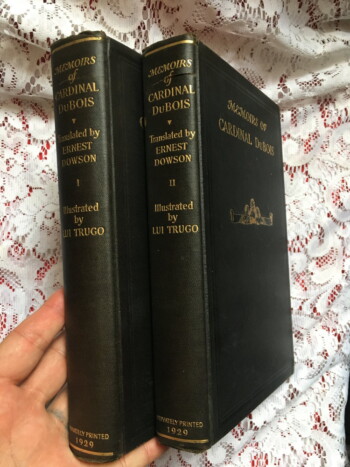
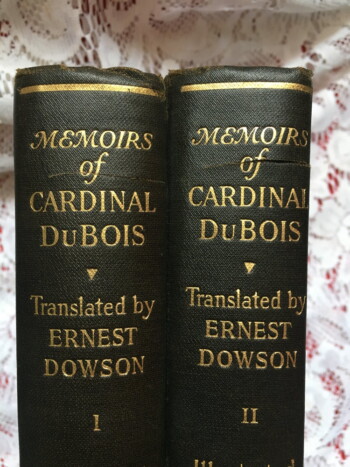 Memoirs of Cardinal Dubois | A complete unabridged translation from the French by Ernest Dowson | Embellished with photogravure portraits of Cardinal Dubois and the Duc d'Orleans, together with twelve full page drawings by Lui Trugo (Privately Printed for Subscribers [Art Studio Press], New York, 1929, #264/1500) 9.75"x6.5", 2 volumes on hand laid paper, xvi-376pp, viii-349pp, black cloth with gilt titles and decorations, top-edge inked, others deckled, good condition bumped corners and a few scuff marks. Two different ex libris Alan K Dolliver bookplates inside front covers of both books. According to the publisher, the original manuscript which was written entirely in Dubois hand was stolen by his secretary Lavergne after his death in 1723. It was later discovered of its literary value that Lavergne attempted to sell the manuscript. He was found and arrested. They later fell into the hands of Comte de Maurepas, then upon his death they were passed on to an anonymous writer named Mercier (possibly M. Paul Laroix) whose family had it published in 1829. The manuscript then became lost. In 1899 and English version of the book translated by Ernest Christopher Dowson, was published by the notorious pornographer, Leonard Smithers & Co. This is, presumably a reprinting of that translation. Guillaume Dubois (1656-1723), a son of a country doctor, rose from humble beginnings to positions of power and high honor in government and in the Catholic Church. He is best known for negotiating the Triple Alliance of 1717 between France, the Dutch Republic and Great Britain against their mutual enemy, Spain. Considered one of the four great French Cardinal-Ministers (Richelieu, Mazarin, Dubois, and Fleury). His ecclesiastical career left a great deal to be desired. Although there is no proof of the prevalent assertion that he got secretly married, his licentiousness, and notorious impiety, even at the time of his death, make it evident that he pursued and used ecclesiastical dignities principally to enhance his political position and prestige. Eventually in 1721, Du Bois was created cardinal. He had the reputation of a libertine and adventurer and made plenty of enemies. One of his rivals was charged at creating his portrait, the Duc de Saint-Simon, who was said to have placed a painting of Dubois in his lavatory. Saint-Simon had this to say about the Cardinal: "He was a little, pitiful, wizened, herring-gutted man, in a flaxen wig, with a weasel's face, brightened by some intellect. All the vices - perfidy, avarice, debauchery, ambition, flattery - fought within him for the mastery. He was so consummate a liar that, when taken in the fact, he could brazenly deny it. Even his wit and knowledge of the world were spoiled, and his affected gaiety was touched with sadness, by the odour of falsehood which escaped through every pore of his body." This famous picture is certainly biased. Dubois was unscrupulous, but so were his contemporaries, and whatever vices he had, he forged a European peace that, with the exception of small, restrained military expeditions against the Austrian Habsburgs, would last for a quarter of a century.
Memoirs of Cardinal Dubois | A complete unabridged translation from the French by Ernest Dowson | Embellished with photogravure portraits of Cardinal Dubois and the Duc d'Orleans, together with twelve full page drawings by Lui Trugo (Privately Printed for Subscribers [Art Studio Press], New York, 1929, #264/1500) 9.75"x6.5", 2 volumes on hand laid paper, xvi-376pp, viii-349pp, black cloth with gilt titles and decorations, top-edge inked, others deckled, good condition bumped corners and a few scuff marks. Two different ex libris Alan K Dolliver bookplates inside front covers of both books. According to the publisher, the original manuscript which was written entirely in Dubois hand was stolen by his secretary Lavergne after his death in 1723. It was later discovered of its literary value that Lavergne attempted to sell the manuscript. He was found and arrested. They later fell into the hands of Comte de Maurepas, then upon his death they were passed on to an anonymous writer named Mercier (possibly M. Paul Laroix) whose family had it published in 1829. The manuscript then became lost. In 1899 and English version of the book translated by Ernest Christopher Dowson, was published by the notorious pornographer, Leonard Smithers & Co. This is, presumably a reprinting of that translation. Guillaume Dubois (1656-1723), a son of a country doctor, rose from humble beginnings to positions of power and high honor in government and in the Catholic Church. He is best known for negotiating the Triple Alliance of 1717 between France, the Dutch Republic and Great Britain against their mutual enemy, Spain. Considered one of the four great French Cardinal-Ministers (Richelieu, Mazarin, Dubois, and Fleury). His ecclesiastical career left a great deal to be desired. Although there is no proof of the prevalent assertion that he got secretly married, his licentiousness, and notorious impiety, even at the time of his death, make it evident that he pursued and used ecclesiastical dignities principally to enhance his political position and prestige. Eventually in 1721, Du Bois was created cardinal. He had the reputation of a libertine and adventurer and made plenty of enemies. One of his rivals was charged at creating his portrait, the Duc de Saint-Simon, who was said to have placed a painting of Dubois in his lavatory. Saint-Simon had this to say about the Cardinal: "He was a little, pitiful, wizened, herring-gutted man, in a flaxen wig, with a weasel's face, brightened by some intellect. All the vices - perfidy, avarice, debauchery, ambition, flattery - fought within him for the mastery. He was so consummate a liar that, when taken in the fact, he could brazenly deny it. Even his wit and knowledge of the world were spoiled, and his affected gaiety was touched with sadness, by the odour of falsehood which escaped through every pore of his body." This famous picture is certainly biased. Dubois was unscrupulous, but so were his contemporaries, and whatever vices he had, he forged a European peace that, with the exception of small, restrained military expeditions against the Austrian Habsburgs, would last for a quarter of a century. -
 Etude Sur La Bestialite Au Point de Vue Historique, Medical et Juridique, G. Dubois-Desaulle (Charles Carrington, Paris, 1905, #437/500, printed Felix Guy et Cie, Aleçon) 10"x7.25", 2 volumes, xii+443pp, Holland paper , modern binding half-calf over red boards, gilt title and decorations on spine, original paper covers bound inside, fore and bottom edges deckled, some pages uncut, very good condition for age, clean. Study of bestiality from the historical, medical and legal point of view. A very nice copy of a VERY rare book.
Etude Sur La Bestialite Au Point de Vue Historique, Medical et Juridique, G. Dubois-Desaulle (Charles Carrington, Paris, 1905, #437/500, printed Felix Guy et Cie, Aleçon) 10"x7.25", 2 volumes, xii+443pp, Holland paper , modern binding half-calf over red boards, gilt title and decorations on spine, original paper covers bound inside, fore and bottom edges deckled, some pages uncut, very good condition for age, clean. Study of bestiality from the historical, medical and legal point of view. A very nice copy of a VERY rare book. -
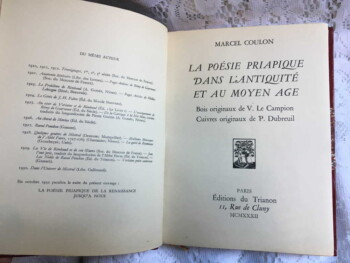
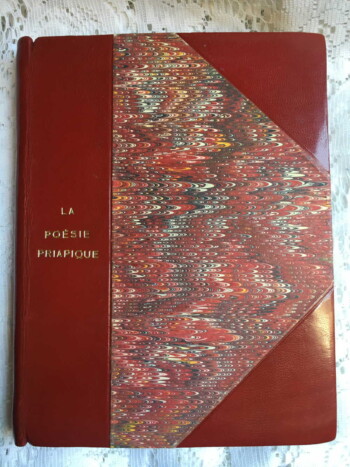 La poésie priapique dans l'antiquité et au moyen age [Priapic poetry in antiquity and the middle ages], ed. Marcel Coulon, 1 original wood engraving by V. Le Campion, 2 original brass engravings by P. Dubreuil (Éditions du Trianon, Paris, 1932, printed by Les Presses de Massoul, #119 of 750) 7.75"x6.25", 166pp+index, 3/4 bound red calf over marbled boards, gilt title on cover and spine, original french wraps bound in, marbled end papers, near fine condition, ribbon intact, pages clean. A history of priapic literature covering folklore, poetry, Priapus, mythology, homosexuality in the ancient world.
La poésie priapique dans l'antiquité et au moyen age [Priapic poetry in antiquity and the middle ages], ed. Marcel Coulon, 1 original wood engraving by V. Le Campion, 2 original brass engravings by P. Dubreuil (Éditions du Trianon, Paris, 1932, printed by Les Presses de Massoul, #119 of 750) 7.75"x6.25", 166pp+index, 3/4 bound red calf over marbled boards, gilt title on cover and spine, original french wraps bound in, marbled end papers, near fine condition, ribbon intact, pages clean. A history of priapic literature covering folklore, poetry, Priapus, mythology, homosexuality in the ancient world. -
Out of stock
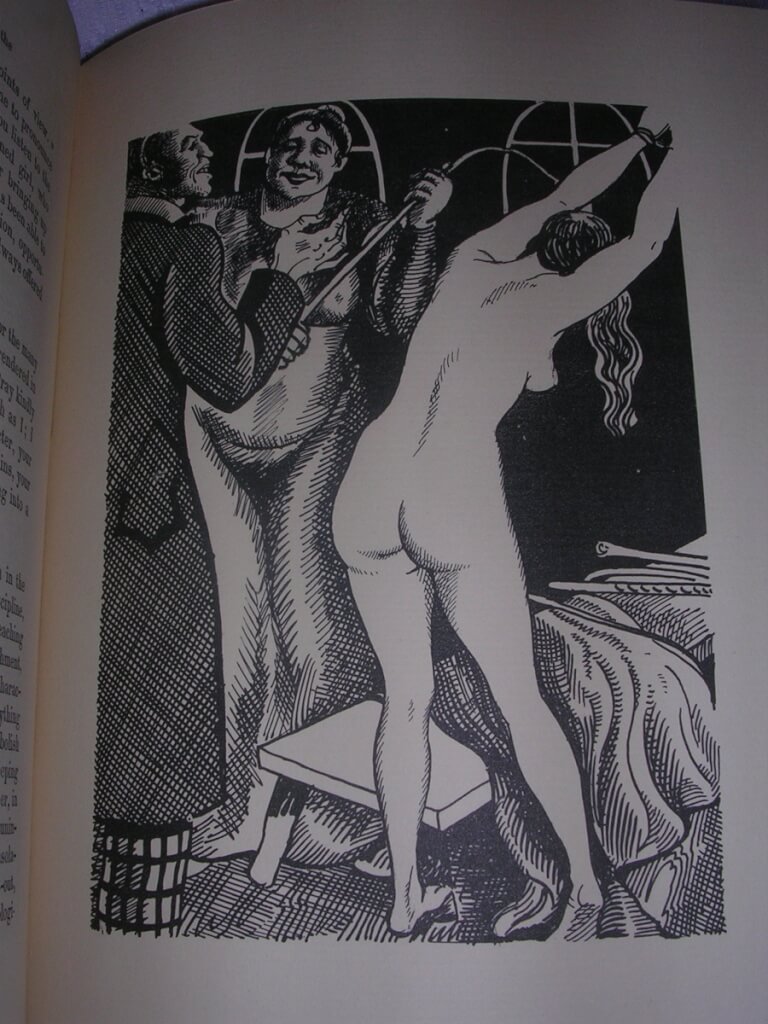 Nell in Bridewell (Lenchen im Zuchthause): Description of the System of Corporal Punishment (Flagellation) in the Female Prisons of South Germany up to the year 1848; a contribution to the history of manners., W. Reinhard, trans. W.C. Costello Ph. D. and A. R. Allinson M. A. (Psych Press [New York], 1932) 9 5/8" X 6 1/2", 326pp, hardbound, black cloth spine over orange cloth boards, gilt lettering and bands on spine, fore and bottom edge deckle, just good condition, soiling and rubbing on front cover, interior clean, some pages unopened, ex libris Joe H. and Bertha M. Shryock Although the title suggests that this is a "study", it goes beyond the facts and delves into the minds of those who are doing the punishing and those who are being humiliated and punished. Publishers of these "flagellation novels" would often lesson their liability by representing their books as academic studies. Often they would go unnoticed by the larger community unaware of the erotic nature of such a book to a certain segment of the public. In this book, Nell describes in graphic terms the merciless floggings she witnessed of girls and young women, as well as of boys and men and confesses to disturbingly confusing emotions that such sights occasioned in her. She recalls the lustful expressions on the faces of the onlookers, records the fervent words of gratitude to the skillful flogger from the lips of grand ladies who "were only too delighted to see such girls whipped", and tells of the evidently sensual appetites such cruelties incited in the torturers. This edition is a facsimile reprint of Carrington's 1900 translation. Added to it are very nice illustrations [woodcuts?] by an unknown artist.
Nell in Bridewell (Lenchen im Zuchthause): Description of the System of Corporal Punishment (Flagellation) in the Female Prisons of South Germany up to the year 1848; a contribution to the history of manners., W. Reinhard, trans. W.C. Costello Ph. D. and A. R. Allinson M. A. (Psych Press [New York], 1932) 9 5/8" X 6 1/2", 326pp, hardbound, black cloth spine over orange cloth boards, gilt lettering and bands on spine, fore and bottom edge deckle, just good condition, soiling and rubbing on front cover, interior clean, some pages unopened, ex libris Joe H. and Bertha M. Shryock Although the title suggests that this is a "study", it goes beyond the facts and delves into the minds of those who are doing the punishing and those who are being humiliated and punished. Publishers of these "flagellation novels" would often lesson their liability by representing their books as academic studies. Often they would go unnoticed by the larger community unaware of the erotic nature of such a book to a certain segment of the public. In this book, Nell describes in graphic terms the merciless floggings she witnessed of girls and young women, as well as of boys and men and confesses to disturbingly confusing emotions that such sights occasioned in her. She recalls the lustful expressions on the faces of the onlookers, records the fervent words of gratitude to the skillful flogger from the lips of grand ladies who "were only too delighted to see such girls whipped", and tells of the evidently sensual appetites such cruelties incited in the torturers. This edition is a facsimile reprint of Carrington's 1900 translation. Added to it are very nice illustrations [woodcuts?] by an unknown artist. -
 The Lysistrata of Aristophanes | Wholly translated into English and illustrated with eight full-page drawings by Aubrey Beardsley with a preface on Aristophanic Comedy and its reflection in the art of the Illustrator by George Frederic Lees, Aristophanes, illus. by Aubrey Beardsley, forward by George Frederic Lees (Privately Printed in Paris, 1931, #352/525) 11.25" X 9.25", 61pp, loosely bound with loose cover, with original slip-case, printed on hand-made Van Gelder paper, 8 illustrations printed on mould-made Annoy Paper, interior pages clean and in fine condition, slip-case is in poor condition, some soiling on the cover. Aristophanes was the greatest writer of ancient Athenian “old comedy,” known for its satires of contemporary life and for its broad, often obscene humor. Lysistrata was first produced in 411 BC, when the Peloponnesian War had been devastating Greece for 20 years. Most people know the plot: Lysistrata assembles women from all of Greece, and they agree that they will not have sex until the men make peace. Aubrey Beardsley was the greatest and the most controversial Art Nouveau illustrator in England, famous for his illustrations of Mallory’s Morte d’Arthur, Oscar Wilde’s Salome, Pope’s The Rape of the Lock, and for several magazines. Because he was associated with Oscar Wilde, Beardsley lost his job as art editor of a magazine named The Yellow Book in 1895, soon after Wilde was arrested for homosexuality. He was approached by Leonard Smithers, a publisher of erotic books, who asked him to illustrate Lysistrata. His illustrations are very much in the spirit of Aristophanes, as funny as they are obscene. Beardsley converted to Catholicism in 1897, and soon after, he asked Smithers to “destroy all copies of Lysistrata” with its “obscene drawings,” but Smithers refused. Beardsley died of tuberculosis in 1898, at the age of 26. Smithers initially published Lysistrata in a limited edition of one hundred copies. It was occasionally reprinted in very small runs, usually clandestinely, often poorly, but copies have long been scarce and expensive. I have only found this copy a few places outside of museums and libraries. This is a rare fine reproduction of the original drawings on quality paper. I do not have information about the actual publisher.
The Lysistrata of Aristophanes | Wholly translated into English and illustrated with eight full-page drawings by Aubrey Beardsley with a preface on Aristophanic Comedy and its reflection in the art of the Illustrator by George Frederic Lees, Aristophanes, illus. by Aubrey Beardsley, forward by George Frederic Lees (Privately Printed in Paris, 1931, #352/525) 11.25" X 9.25", 61pp, loosely bound with loose cover, with original slip-case, printed on hand-made Van Gelder paper, 8 illustrations printed on mould-made Annoy Paper, interior pages clean and in fine condition, slip-case is in poor condition, some soiling on the cover. Aristophanes was the greatest writer of ancient Athenian “old comedy,” known for its satires of contemporary life and for its broad, often obscene humor. Lysistrata was first produced in 411 BC, when the Peloponnesian War had been devastating Greece for 20 years. Most people know the plot: Lysistrata assembles women from all of Greece, and they agree that they will not have sex until the men make peace. Aubrey Beardsley was the greatest and the most controversial Art Nouveau illustrator in England, famous for his illustrations of Mallory’s Morte d’Arthur, Oscar Wilde’s Salome, Pope’s The Rape of the Lock, and for several magazines. Because he was associated with Oscar Wilde, Beardsley lost his job as art editor of a magazine named The Yellow Book in 1895, soon after Wilde was arrested for homosexuality. He was approached by Leonard Smithers, a publisher of erotic books, who asked him to illustrate Lysistrata. His illustrations are very much in the spirit of Aristophanes, as funny as they are obscene. Beardsley converted to Catholicism in 1897, and soon after, he asked Smithers to “destroy all copies of Lysistrata” with its “obscene drawings,” but Smithers refused. Beardsley died of tuberculosis in 1898, at the age of 26. Smithers initially published Lysistrata in a limited edition of one hundred copies. It was occasionally reprinted in very small runs, usually clandestinely, often poorly, but copies have long been scarce and expensive. I have only found this copy a few places outside of museums and libraries. This is a rare fine reproduction of the original drawings on quality paper. I do not have information about the actual publisher. -
 Die Weiberherrschaft in der Geschichte der Menschheit [The Rule of Women in the History of Mankind], Eduard Fuchs, Alfred Kind (Albert Langen, München, 1913) 8.75″ X 11″, complete set, 2 volumes plus supplementary volume, x+1-348pp, 349-711pp, ix+319pp, decorated green cloth boards, decorated cloth endpapers, binding loose by design and very much intact on all volumes (binding is often a problem with this edition), Vol. 1&2 contain 665 illustrations and 90 tipped in illustrations. The supplemental volume contains 317 illustrations and 34 tipped in illustrations. Minor bumping on covers, in excellent condition for age. Compiling 665+317 reproductions of drawings, prints and paintings from the collection of Eduard Fuchs, this edition shows how the image of female domination and male submission was widespread in Europe from the Renaissance to the early 20th century. Edward Fuchs (1870-1940). Fuchs' father was a shopkeeper. Early in his life, the younger Fuchs developed socialist and Marxist political convictions. In 1886, he joined the outlawed political party Sozialistische Arbeiterpartei (the precursor of the modern SPD, Sozialdemokratische Partei Deutschlands). Fuchs received a doctor of law degree and practiced as an attorney. In 1892, he became editor-in-chief of the satiric weekly Süddeutscher Postillon and later co-editor of the Leipziger Volkszeitung. His inflammatory articles in newspapers—one accusing the Kaiser of being a mass murderer—resulted in periodic jail sentences. During his periods of confinement, Fuchs wrote various social histories utilizing images as one of his primary sources. The first of these was his Karikatur der europäischen Völker (Caricatures of European Peoples), 1902. He moved to Berlin that same year where he edited the socialist newspaper Vorwärts. The following year he began his magnum opus, an examination of moral practice, Sittengeschichte, eventually running to six volumes by 1912. While engaged in this series, he followed up his interest in caricatures with one devoted to the representation of women, Die Frau in der Karikatur, 1905 (3 vols). Another book documenting the stereotypical representations of Jews appeared in 1912. Fuchs traveled with the artist Max Slevogt to Egypt in 1914, shortly before the outbreak of World War I. He was a pacifist during the War. Lenin's government put him in charge of prisoner exchange with Germany after the war; he was among the leaders of the German Comintern in Berlin in 1919. His interest in societal concerns in caricature led to a research interest in Daumier. Beginning in 1920, Fuchs published a catalogue raisonné on the artist in three volumes. He resigned from the party in 1929, following the expulsion of several stalwarts. At Hitler's ascension to power in Germany in 1933, Fuchs moved to France.
Die Weiberherrschaft in der Geschichte der Menschheit [The Rule of Women in the History of Mankind], Eduard Fuchs, Alfred Kind (Albert Langen, München, 1913) 8.75″ X 11″, complete set, 2 volumes plus supplementary volume, x+1-348pp, 349-711pp, ix+319pp, decorated green cloth boards, decorated cloth endpapers, binding loose by design and very much intact on all volumes (binding is often a problem with this edition), Vol. 1&2 contain 665 illustrations and 90 tipped in illustrations. The supplemental volume contains 317 illustrations and 34 tipped in illustrations. Minor bumping on covers, in excellent condition for age. Compiling 665+317 reproductions of drawings, prints and paintings from the collection of Eduard Fuchs, this edition shows how the image of female domination and male submission was widespread in Europe from the Renaissance to the early 20th century. Edward Fuchs (1870-1940). Fuchs' father was a shopkeeper. Early in his life, the younger Fuchs developed socialist and Marxist political convictions. In 1886, he joined the outlawed political party Sozialistische Arbeiterpartei (the precursor of the modern SPD, Sozialdemokratische Partei Deutschlands). Fuchs received a doctor of law degree and practiced as an attorney. In 1892, he became editor-in-chief of the satiric weekly Süddeutscher Postillon and later co-editor of the Leipziger Volkszeitung. His inflammatory articles in newspapers—one accusing the Kaiser of being a mass murderer—resulted in periodic jail sentences. During his periods of confinement, Fuchs wrote various social histories utilizing images as one of his primary sources. The first of these was his Karikatur der europäischen Völker (Caricatures of European Peoples), 1902. He moved to Berlin that same year where he edited the socialist newspaper Vorwärts. The following year he began his magnum opus, an examination of moral practice, Sittengeschichte, eventually running to six volumes by 1912. While engaged in this series, he followed up his interest in caricatures with one devoted to the representation of women, Die Frau in der Karikatur, 1905 (3 vols). Another book documenting the stereotypical representations of Jews appeared in 1912. Fuchs traveled with the artist Max Slevogt to Egypt in 1914, shortly before the outbreak of World War I. He was a pacifist during the War. Lenin's government put him in charge of prisoner exchange with Germany after the war; he was among the leaders of the German Comintern in Berlin in 1919. His interest in societal concerns in caricature led to a research interest in Daumier. Beginning in 1920, Fuchs published a catalogue raisonné on the artist in three volumes. He resigned from the party in 1929, following the expulsion of several stalwarts. At Hitler's ascension to power in Germany in 1933, Fuchs moved to France. -
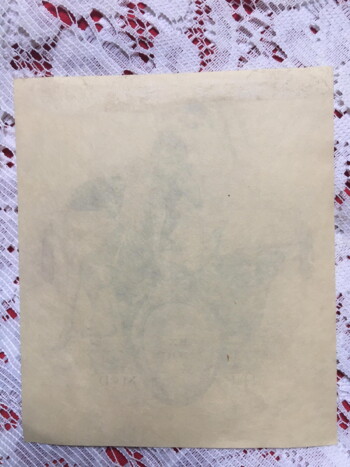
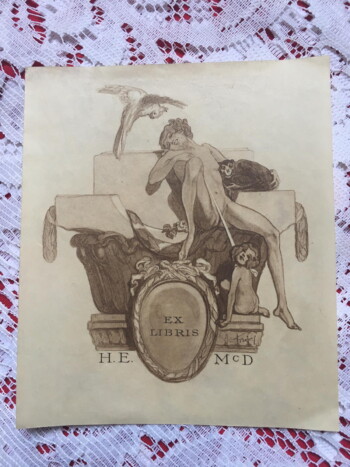 Ex Libris H.E. McD, by Franz von Bayros 4 x 4.5" brown/black ink, previously pasted as evident by top part of back naked girl, animals, and child, presumably Ex libris for Horace E. McDonald Franz von Bayros (1866 – 1924) was an Austrian commercial artist, illustrator, and painter, now he is best known for his erotic work. He belonged to the Decadent movement in art, often utilizing erotic themes and phantasmagoric imagery. At the age 17, Bayros passed the entrance exam for the Vienna Academy with Eduard von Engerth. Bayros mixed in elegant society and soon belonged to the circle of friends of Johann Straub, whose step daughter Alice he married on 1896. The next year, Bayros moved to Munich. In 1904, Bayros gave his first exhibition in Munich, which was a great success. From 1904 until 1908, Bayros traveled to Paris and Italy for his studies. Typically, for an artist dealing with such imagery, von Bayros produced work under several pseudonyms, most notably Choisy Le Conin, and was hounded by authorities for much of his life for his “indecent” art often very imaginative, and including such taboo subjects as sadomasochism and bestiality. He became equally well-known for his masterly drawn figures of elegant modestly nude and non-nude women.
Ex Libris H.E. McD, by Franz von Bayros 4 x 4.5" brown/black ink, previously pasted as evident by top part of back naked girl, animals, and child, presumably Ex libris for Horace E. McDonald Franz von Bayros (1866 – 1924) was an Austrian commercial artist, illustrator, and painter, now he is best known for his erotic work. He belonged to the Decadent movement in art, often utilizing erotic themes and phantasmagoric imagery. At the age 17, Bayros passed the entrance exam for the Vienna Academy with Eduard von Engerth. Bayros mixed in elegant society and soon belonged to the circle of friends of Johann Straub, whose step daughter Alice he married on 1896. The next year, Bayros moved to Munich. In 1904, Bayros gave his first exhibition in Munich, which was a great success. From 1904 until 1908, Bayros traveled to Paris and Italy for his studies. Typically, for an artist dealing with such imagery, von Bayros produced work under several pseudonyms, most notably Choisy Le Conin, and was hounded by authorities for much of his life for his “indecent” art often very imaginative, and including such taboo subjects as sadomasochism and bestiality. He became equally well-known for his masterly drawn figures of elegant modestly nude and non-nude women. -

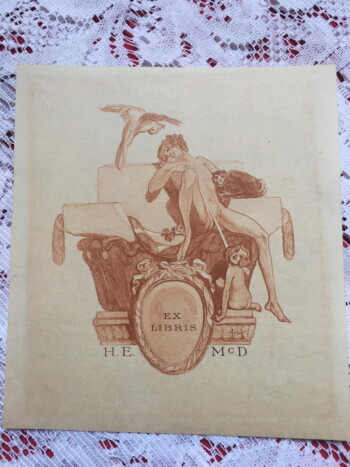 Ex Libris H.E. McD, by Franz von Bayros 4 x 4.5" red ink, previously pasted as evident by top part of back naked girl, animals, and child, presumably Ex libris for Horace E. McDonald Franz von Bayros (1866 – 1924) was an Austrian commercial artist, illustrator, and painter, now he is best known for his erotic work. He belonged to the Decadent movement in art, often utilizing erotic themes and phantasmagoric imagery. At the age 17, Bayros passed the entrance exam for the Vienna Academy with Eduard von Engerth. Bayros mixed in elegant society and soon belonged to the circle of friends of Johann Straub, whose step daughter Alice he married on 1896. The next year, Bayros moved to Munich. In 1904, Bayros gave his first exhibition in Munich, which was a great success. From 1904 until 1908, Bayros traveled to Paris and Italy for his studies. Typically, for an artist dealing with such imagery, von Bayros produced work under several pseudonyms, most notably Choisy Le Conin, and was hounded by authorities for much of his life for his “indecent” art often very imaginative, and including such taboo subjects as sadomasochism and bestiality. He became equally well-known for his masterly drawn figures of elegant modestly nude and non-nude women.
Ex Libris H.E. McD, by Franz von Bayros 4 x 4.5" red ink, previously pasted as evident by top part of back naked girl, animals, and child, presumably Ex libris for Horace E. McDonald Franz von Bayros (1866 – 1924) was an Austrian commercial artist, illustrator, and painter, now he is best known for his erotic work. He belonged to the Decadent movement in art, often utilizing erotic themes and phantasmagoric imagery. At the age 17, Bayros passed the entrance exam for the Vienna Academy with Eduard von Engerth. Bayros mixed in elegant society and soon belonged to the circle of friends of Johann Straub, whose step daughter Alice he married on 1896. The next year, Bayros moved to Munich. In 1904, Bayros gave his first exhibition in Munich, which was a great success. From 1904 until 1908, Bayros traveled to Paris and Italy for his studies. Typically, for an artist dealing with such imagery, von Bayros produced work under several pseudonyms, most notably Choisy Le Conin, and was hounded by authorities for much of his life for his “indecent” art often very imaginative, and including such taboo subjects as sadomasochism and bestiality. He became equally well-known for his masterly drawn figures of elegant modestly nude and non-nude women. -
Out of stock

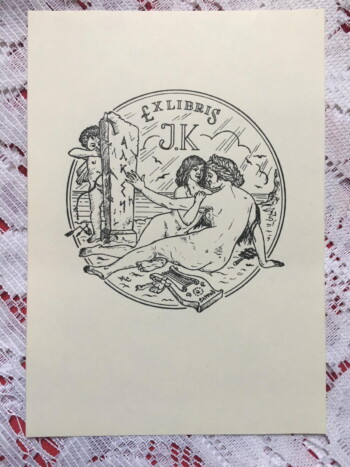 Ex Libris J.K 3.5 x 5", unknown origin, purchased from a collection in Italy naked women, a lyre labeled "Sappho", cupid behind pillar. Artist name written on back in pencil ("cangoo"?).
Ex Libris J.K 3.5 x 5", unknown origin, purchased from a collection in Italy naked women, a lyre labeled "Sappho", cupid behind pillar. Artist name written on back in pencil ("cangoo"?). -
Out of stock

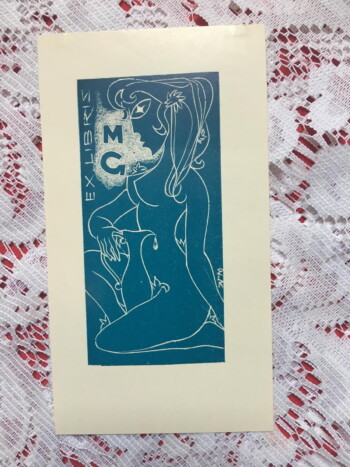 Ex Libris MG 2.75 x 5", unknown origin naked women with pitcher
Ex Libris MG 2.75 x 5", unknown origin naked women with pitcher -
Out of stock
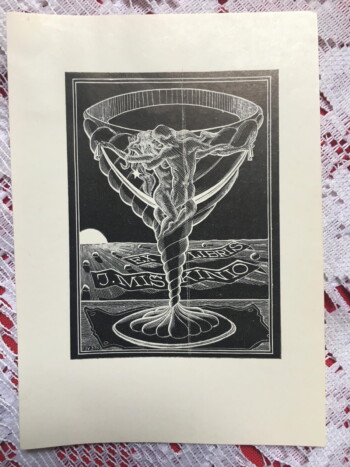 Ex libris J. Mikino 3 x 4", black ink on paper two lovers intertwined as a wine glass
Ex libris J. Mikino 3 x 4", black ink on paper two lovers intertwined as a wine glass -

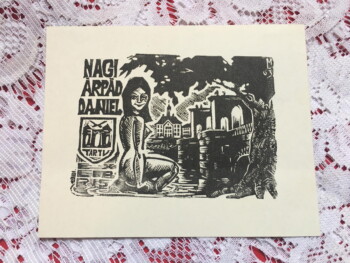 Ex Libris Nagi Arpad Daniel - Tartu 3.5 x 4.75", signed on the back, presumably by and for the Estonian artist, Arpad Daniel Nagy, Tartu is a city in Estonia nude woman sitting on rock in the water, behind her a bridge. Arpad Daniel Nagy was a creative visual artist. Arpad Daniel Nagy was born in 1922 and died in 1985. Arpad Daniel Nagy was largely inspired by the 1930s growing up. The period of the 1930s is characterised by the conflict between a number of political ideologies, including Marxist Socialism, Capitalist Democracy, and the Totalitarianism of both Communism and Fascism. Artistic output in the United States was heavily impacted at the time by the Great Depression, and a number of artists took to focusing on ideas of humility and the ordinary man. For the first time in US history, artists began to explore into political subjects and attempted to use their art to impact society. Themes such as poverty, lack of affordable housing, anti-lynching, anti-fascism, and workers' strikes were prevalent in many artists’ work. In the Soviet Union, Stalin’s government required urgent funds to implement the rapid industrialisation demanded by the first Five Year Plan. It initiated a secret plan to sell off treasures from the State Hermitage Museum in Leningrad (St. Petersburg), including a primary list of two hundred and fifty rare paintings by the Old Masters, many which found their way to the collection of Andrew Mellon via the New York based art dealing company, Knoedler. Surrealism continued to dominate in Europe, and had influence on an international scale. Artists such as Frida Kahlo and Diego Riviera in Mexico, worked to incorporate the ideas posed by Surrealism into their radical political ideologies, developing a new kind of magic realism. The decade took a ominous turn with the birth of National Socialism in Germany, followed by Adolf Hitler’s rise to power in 1933. By the end of the 1930s, the Second World War had begun; which preoccupied both artists and the global population.
Ex Libris Nagi Arpad Daniel - Tartu 3.5 x 4.75", signed on the back, presumably by and for the Estonian artist, Arpad Daniel Nagy, Tartu is a city in Estonia nude woman sitting on rock in the water, behind her a bridge. Arpad Daniel Nagy was a creative visual artist. Arpad Daniel Nagy was born in 1922 and died in 1985. Arpad Daniel Nagy was largely inspired by the 1930s growing up. The period of the 1930s is characterised by the conflict between a number of political ideologies, including Marxist Socialism, Capitalist Democracy, and the Totalitarianism of both Communism and Fascism. Artistic output in the United States was heavily impacted at the time by the Great Depression, and a number of artists took to focusing on ideas of humility and the ordinary man. For the first time in US history, artists began to explore into political subjects and attempted to use their art to impact society. Themes such as poverty, lack of affordable housing, anti-lynching, anti-fascism, and workers' strikes were prevalent in many artists’ work. In the Soviet Union, Stalin’s government required urgent funds to implement the rapid industrialisation demanded by the first Five Year Plan. It initiated a secret plan to sell off treasures from the State Hermitage Museum in Leningrad (St. Petersburg), including a primary list of two hundred and fifty rare paintings by the Old Masters, many which found their way to the collection of Andrew Mellon via the New York based art dealing company, Knoedler. Surrealism continued to dominate in Europe, and had influence on an international scale. Artists such as Frida Kahlo and Diego Riviera in Mexico, worked to incorporate the ideas posed by Surrealism into their radical political ideologies, developing a new kind of magic realism. The decade took a ominous turn with the birth of National Socialism in Germany, followed by Adolf Hitler’s rise to power in 1933. By the end of the 1930s, the Second World War had begun; which preoccupied both artists and the global population. -

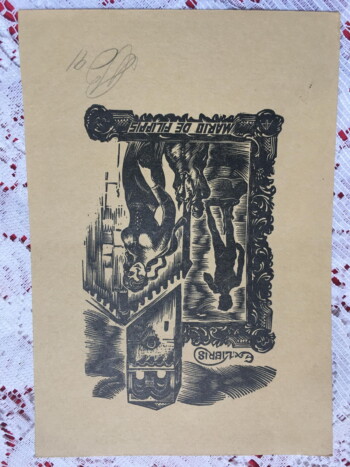 Ex Libris Mario de Filippis (signed) 5 x 4", signed on the front and back in pencil, presumably by artist Woman, man on horseback in front of Italian architecture and a silhouette of Michelangelo's David One of the most important (and largest) collections of ex libris in the world belongs to Mario De Filippis, the owner of Buca di San Francesco restaurant in Arezzo Italy. He has over 130,000 ex libris in his collection, approximately 13,000 are personal ex libris plates he's commissioned from artists all over the world using a multitude of printing techniques. His website describes Mario as "a passionate lover of small graphics".
Ex Libris Mario de Filippis (signed) 5 x 4", signed on the front and back in pencil, presumably by artist Woman, man on horseback in front of Italian architecture and a silhouette of Michelangelo's David One of the most important (and largest) collections of ex libris in the world belongs to Mario De Filippis, the owner of Buca di San Francesco restaurant in Arezzo Italy. He has over 130,000 ex libris in his collection, approximately 13,000 are personal ex libris plates he's commissioned from artists all over the world using a multitude of printing techniques. His website describes Mario as "a passionate lover of small graphics". -
 The Rahnghild Edition of: Venus in Furs, Leopold von Sacher-Masoch, illustrated by Rahnghild [Susan Inez Aguerra?] (William Faro, Inc [Samuel Roth, New York], 1932) 6.5"x9.25", 240pp, brown cloth boards with pasted title on spine, some soiling on front paste-down but overall a clean copy, beautiful art-deco illustrations throughout. Venus in Furs (German: Venus im Pelz) is a novella by Leopold Ritter von Sacher-Masoch (1836-1895), an Austrian writer and journalist. It is now his best known work and because of its themes the term masochism is derived from his name, coined by the Austrian psychiatrist, Krafft-Ebing. The novel was to be part of an epic series that Sacher-Masoch envisioned called Legacy of Cain. Venus in Furs was part of Love, the first volume of the series. It was published in 1870. The novel draws themes, like female dominance and sadomasochism, and character inspiration heavily from Sacher-Masoch’s own life. Wanda von Dunajew, the novel’s central female character, was modelled after his mistress Baroness Fanny Pistor. In December 1869 the two signed a contract making him her slave for a period of 6 months. In 1873, after the publication of Venus in Furs, Sacher-Masoch married Aurora von Rümelin who he pressured to continue the lifestyle he wrote about in his book. After 10 years they divorced. Rümelin, using the pseudonym of the books title character, “Wanda von Dunajew”, wrote Meine Lebensbeichte (My Life Confession) published in 1906. It detailed Sacher-Masoch’s private life and her relationship with him. During his lifetime, Sacher-Masoch was well known as a man of letters, a utopian thinker who espoused socialist and humanist ideals in his fiction and non-fiction. Most of his works remain untranslated into English. Until recently, his novel Venus in Furs was his only book commonly available in English. Samuel Roth (1893-1974) was an infamous American publisher and writer. He had a bookstore, Poetry Shop in the West Village section of Greenwich Villiage. He was the plaintiff in Roth v. United States (1957), which was a key Supreme Court ruling on freedom of sexual expression. He was also repeatedly convicted for publishing and distributing obscene material.
The Rahnghild Edition of: Venus in Furs, Leopold von Sacher-Masoch, illustrated by Rahnghild [Susan Inez Aguerra?] (William Faro, Inc [Samuel Roth, New York], 1932) 6.5"x9.25", 240pp, brown cloth boards with pasted title on spine, some soiling on front paste-down but overall a clean copy, beautiful art-deco illustrations throughout. Venus in Furs (German: Venus im Pelz) is a novella by Leopold Ritter von Sacher-Masoch (1836-1895), an Austrian writer and journalist. It is now his best known work and because of its themes the term masochism is derived from his name, coined by the Austrian psychiatrist, Krafft-Ebing. The novel was to be part of an epic series that Sacher-Masoch envisioned called Legacy of Cain. Venus in Furs was part of Love, the first volume of the series. It was published in 1870. The novel draws themes, like female dominance and sadomasochism, and character inspiration heavily from Sacher-Masoch’s own life. Wanda von Dunajew, the novel’s central female character, was modelled after his mistress Baroness Fanny Pistor. In December 1869 the two signed a contract making him her slave for a period of 6 months. In 1873, after the publication of Venus in Furs, Sacher-Masoch married Aurora von Rümelin who he pressured to continue the lifestyle he wrote about in his book. After 10 years they divorced. Rümelin, using the pseudonym of the books title character, “Wanda von Dunajew”, wrote Meine Lebensbeichte (My Life Confession) published in 1906. It detailed Sacher-Masoch’s private life and her relationship with him. During his lifetime, Sacher-Masoch was well known as a man of letters, a utopian thinker who espoused socialist and humanist ideals in his fiction and non-fiction. Most of his works remain untranslated into English. Until recently, his novel Venus in Furs was his only book commonly available in English. Samuel Roth (1893-1974) was an infamous American publisher and writer. He had a bookstore, Poetry Shop in the West Village section of Greenwich Villiage. He was the plaintiff in Roth v. United States (1957), which was a key Supreme Court ruling on freedom of sexual expression. He was also repeatedly convicted for publishing and distributing obscene material. -
 The Golden Ass of Apuleius, Lucius Apuleius Madaurensis (124-170 AD), trans. & intro Francis D. Byrne (The Imperial Press[Charles Carrington?], London, n.d. [1904?], #257/650) 7.75" X 5.75", xlix+388pp., 1/4 maroon morrocco over marbled boards with gilt titles and 4 raised bands on spine, top edge gilt The Metamorphoses of Apuleius, which St. Augustine referred to as “The Golden Ass”, is the only Ancient Roman novel in Latin to survive in its entirety. The plot Lucius and his curiosity and insatiable desire to see and practice magic. While trying to perform a spell to transform into a bird, he is accidentally transformed into an ass. This leads to a long journey, literal and metaphorical, filled with in-set tales. He finally finds salvation through the intervention of the goddess Isis, whose cult he joins. The date of the original work is uncertain. Scholars are not sure if he wrote it in his youth or at the end of his life. He adapted the story from a Greek story written by Lucius of Patrae, however his original Greek text has long been lost.
The Golden Ass of Apuleius, Lucius Apuleius Madaurensis (124-170 AD), trans. & intro Francis D. Byrne (The Imperial Press[Charles Carrington?], London, n.d. [1904?], #257/650) 7.75" X 5.75", xlix+388pp., 1/4 maroon morrocco over marbled boards with gilt titles and 4 raised bands on spine, top edge gilt The Metamorphoses of Apuleius, which St. Augustine referred to as “The Golden Ass”, is the only Ancient Roman novel in Latin to survive in its entirety. The plot Lucius and his curiosity and insatiable desire to see and practice magic. While trying to perform a spell to transform into a bird, he is accidentally transformed into an ass. This leads to a long journey, literal and metaphorical, filled with in-set tales. He finally finds salvation through the intervention of the goddess Isis, whose cult he joins. The date of the original work is uncertain. Scholars are not sure if he wrote it in his youth or at the end of his life. He adapted the story from a Greek story written by Lucius of Patrae, however his original Greek text has long been lost. -

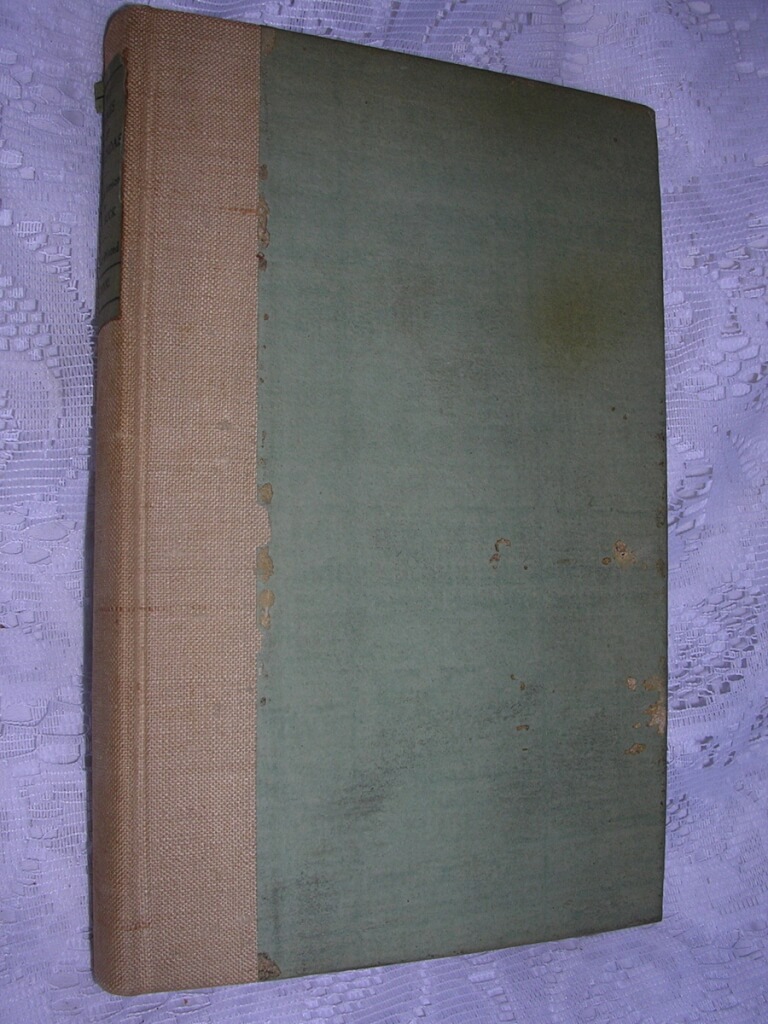 The Mimes of Herondas, trans. M. S. Buck (Privately Printed for Subscribers, New York, 1921, #919/975) 7" X 4 5/8", 119pp, hardbound no DJ, paper boards with beige cloth spine, top edge gilt, others deckle, good condition, lightly soiled Herodas was a Greek poet and the author of short humorous dramatic scenes in verse, written under the Alexandrian empire in the 3rd century BC. Mimes were scenes in popular life in South Italy and Sicily, written in the language of the people, vigorous with racy proverbs such as we get in other reflections of that region. The Mimes of Herodas have been known to us only since the discovery and publication of the "Kenyon", M. S. Buck, by the British Museum in 1891 (from a parchment containing 7 legible mimes half of the 8th and a fragment of the 9th).
The Mimes of Herondas, trans. M. S. Buck (Privately Printed for Subscribers, New York, 1921, #919/975) 7" X 4 5/8", 119pp, hardbound no DJ, paper boards with beige cloth spine, top edge gilt, others deckle, good condition, lightly soiled Herodas was a Greek poet and the author of short humorous dramatic scenes in verse, written under the Alexandrian empire in the 3rd century BC. Mimes were scenes in popular life in South Italy and Sicily, written in the language of the people, vigorous with racy proverbs such as we get in other reflections of that region. The Mimes of Herodas have been known to us only since the discovery and publication of the "Kenyon", M. S. Buck, by the British Museum in 1891 (from a parchment containing 7 legible mimes half of the 8th and a fragment of the 9th). -
 Sappho: memoir, text, selected renderings, and a literal translation by Henry Thorton Wharton, Sappho, trans. Henry Thornton Wharton, M.A. Oxon. (John Lane [Bodley Head], London, A.C. McClurg & Co, Chicago, 1895 (third edition)) 7.25″ X 4.75″, xx 217pp + 16pp publisher’s list, hardbound, the third edition (this being the first to have its boards decorated by Aubrey Beardsley) green cloth boards with gilt decorations and titles on spine, bottom of the spine states “The Bodley Head and Chicago” reflecting the two publishing houses, top edge gilt, others deckled. Good condition for age, short tear on spine, binding and hinges good, newspaper article attached to back page “A Newly-Found Poem by Sappho” Sappho was a Greek lyric poet, born on the island of Lesbos. The Alexandrians included her in the list of nine lyric poets. Her birth was sometime between 630 and 612 BC, and it is said that she died around 570 BC, but little is known for certain about her life. The bulk of her poetry, which was well-known and greatly admired through much of antiquity, has been lost. But, her immense reputation has endured through surviving fragments. Sappho's poetry centers on passion and love for various people and both sexes. The word lesbian derives from the name of the island of her birth, Lesbos, while her name is also the origin of the word sapphic; neither word was applied to female homosexuality until the 19th century, after this translation by Wharton, the first English translation to acknowledge it. Originally John Lane and Elkin Mathews — The Bodley Head was a partnership set up in 1887 by John Lane (1854–1925) and Elkin Mathews (1851–1921), to trade in antiquarian books in London. It took its name from a bust of Sir Thomas Bodley, the eponymist of the Bodleian Library in Oxford, above the shop door. Lane and Mathews began in 1894 to publish works of ‘stylish decadence’, including the notorious literary periodical The Yellow Book. A. C. McClurg was a Chicago, Illinois based publisher made famous by their original publishing of the Tarzan of the Apes novels and other stories of Edgar Rice Burroughs.
Sappho: memoir, text, selected renderings, and a literal translation by Henry Thorton Wharton, Sappho, trans. Henry Thornton Wharton, M.A. Oxon. (John Lane [Bodley Head], London, A.C. McClurg & Co, Chicago, 1895 (third edition)) 7.25″ X 4.75″, xx 217pp + 16pp publisher’s list, hardbound, the third edition (this being the first to have its boards decorated by Aubrey Beardsley) green cloth boards with gilt decorations and titles on spine, bottom of the spine states “The Bodley Head and Chicago” reflecting the two publishing houses, top edge gilt, others deckled. Good condition for age, short tear on spine, binding and hinges good, newspaper article attached to back page “A Newly-Found Poem by Sappho” Sappho was a Greek lyric poet, born on the island of Lesbos. The Alexandrians included her in the list of nine lyric poets. Her birth was sometime between 630 and 612 BC, and it is said that she died around 570 BC, but little is known for certain about her life. The bulk of her poetry, which was well-known and greatly admired through much of antiquity, has been lost. But, her immense reputation has endured through surviving fragments. Sappho's poetry centers on passion and love for various people and both sexes. The word lesbian derives from the name of the island of her birth, Lesbos, while her name is also the origin of the word sapphic; neither word was applied to female homosexuality until the 19th century, after this translation by Wharton, the first English translation to acknowledge it. Originally John Lane and Elkin Mathews — The Bodley Head was a partnership set up in 1887 by John Lane (1854–1925) and Elkin Mathews (1851–1921), to trade in antiquarian books in London. It took its name from a bust of Sir Thomas Bodley, the eponymist of the Bodleian Library in Oxford, above the shop door. Lane and Mathews began in 1894 to publish works of ‘stylish decadence’, including the notorious literary periodical The Yellow Book. A. C. McClurg was a Chicago, Illinois based publisher made famous by their original publishing of the Tarzan of the Apes novels and other stories of Edgar Rice Burroughs. -
 The Dialogues of Luisa Sigea, Nicolas Chorier, translation by Isadore Liseux (Isadore Liseux, Paris, 1890, first edition, first English translation, printed by Ch. Unsinger) 8.75" X 5.75", 3 books bound in one, xx+87pp, 132pp, 98+2pp, 3/4 crimson morocco over red boards, 5 raised bands, gilt decorations and titles on spine, marbled endpapers, top edge gilt, others deckled. Excellent condition for age, very minor bumping on corners and top and bottom of spine. In six dialogues (I. The skirmish; II. Tribadicon; III. Fabric; IV. The duel; V. Pleasures; VI. Frolics and sports) Tullia, who is 26, initiates her 15 year old cousin, Ottavia, in the art of sexual pleasure. The first four dialogues, which are fairly short, focus on tribadism and defloration. The longer fifth and six dialogues introduce flagellation, contractual submission, group sex, and anal sex. Like many sexual fictions, The Dialogues of Luisa Sigea (originally written in latin "Aloisiae Sigeae Satyra Sotadica de arcanis Amoris et Veneris") attempts to conceal the identity of its author: it purports to be based on a Latin manuscript translation of a work written originally in Spanish in the sixteenth century by an erudite young woman, Luisa Sigea of Toledo and translated into latin by Jean Meursius of Holland. In fact, it was written c. 1660, in latin, by a Frenchman, Nicolas Chorier (1612-1692), a lawyer who wrote works on various historical and philosophical subjects. The first first French translation, L’Academie des dames, was issued in the 1680. This 1890 edition was for the first time translated into English by Isidore Liseux and issued as a 3 volume set. (1. I-IV, 2. V, 3. VI). Isidore Liseux (1835-1894) was a French bibliophile and publisher of erotica and curiosa. His publications were mostly rare texts of 16th to 18th century authors, hard to find and little known books which were usually translated and annotated by his friend and associate Alcide Bonneau or by Liseux himself. Liseux and Bonneau, both ex-priests, knew each other since seminary. His books were published in small numbers, on high quality paper, and with excellent typography. His usual printers were Claude Motteroz, Antoine Bécus, and later Charles Unsinger. Liseux's books were published openly as the climate was more permissive in Paris at the time. His books were so well regarded that pirates of his books and even unrelated books bearing his imprint with a false date were published clandestinely into the 20th century. French poet, Guillaume Apollinaire wrote: "The publications of Liseux are more and more sought after because they are correct, beautiful and rare." (Le flaneur des deux rives, 1918).
The Dialogues of Luisa Sigea, Nicolas Chorier, translation by Isadore Liseux (Isadore Liseux, Paris, 1890, first edition, first English translation, printed by Ch. Unsinger) 8.75" X 5.75", 3 books bound in one, xx+87pp, 132pp, 98+2pp, 3/4 crimson morocco over red boards, 5 raised bands, gilt decorations and titles on spine, marbled endpapers, top edge gilt, others deckled. Excellent condition for age, very minor bumping on corners and top and bottom of spine. In six dialogues (I. The skirmish; II. Tribadicon; III. Fabric; IV. The duel; V. Pleasures; VI. Frolics and sports) Tullia, who is 26, initiates her 15 year old cousin, Ottavia, in the art of sexual pleasure. The first four dialogues, which are fairly short, focus on tribadism and defloration. The longer fifth and six dialogues introduce flagellation, contractual submission, group sex, and anal sex. Like many sexual fictions, The Dialogues of Luisa Sigea (originally written in latin "Aloisiae Sigeae Satyra Sotadica de arcanis Amoris et Veneris") attempts to conceal the identity of its author: it purports to be based on a Latin manuscript translation of a work written originally in Spanish in the sixteenth century by an erudite young woman, Luisa Sigea of Toledo and translated into latin by Jean Meursius of Holland. In fact, it was written c. 1660, in latin, by a Frenchman, Nicolas Chorier (1612-1692), a lawyer who wrote works on various historical and philosophical subjects. The first first French translation, L’Academie des dames, was issued in the 1680. This 1890 edition was for the first time translated into English by Isidore Liseux and issued as a 3 volume set. (1. I-IV, 2. V, 3. VI). Isidore Liseux (1835-1894) was a French bibliophile and publisher of erotica and curiosa. His publications were mostly rare texts of 16th to 18th century authors, hard to find and little known books which were usually translated and annotated by his friend and associate Alcide Bonneau or by Liseux himself. Liseux and Bonneau, both ex-priests, knew each other since seminary. His books were published in small numbers, on high quality paper, and with excellent typography. His usual printers were Claude Motteroz, Antoine Bécus, and later Charles Unsinger. Liseux's books were published openly as the climate was more permissive in Paris at the time. His books were so well regarded that pirates of his books and even unrelated books bearing his imprint with a false date were published clandestinely into the 20th century. French poet, Guillaume Apollinaire wrote: "The publications of Liseux are more and more sought after because they are correct, beautiful and rare." (Le flaneur des deux rives, 1918). -
 The Dialogues of Luisa Sigea, Nicolas Chorier, translation by Isadore Liseux (Isadore Liseux, Paris, 1890, first edition, first English translation, printed by Ch. Unsinger) 8.75" X 5.75", 2nd and 3rd books of a 3 vol set, 132pp, 98+2pp, 3/4 crimson morocco over red boards, gilt decorations and titles on spine, top edge gilt, others deckled. Excellent condition for age, very minor bumping on corners and top and bottom of spine. In six dialogues (I. The skirmish; II. Tribadicon; III. Fabric; IV. The duel; V. Pleasures; VI. Frolics and sports) Tullia, who is 26, initiates her 15 year old cousin, Ottavia, in the art of sexual pleasure. The first four dialogues (not present), are fairly short, focus on tribadism and defloration. The longer fifth and six dialogues introduce flagellation, contractual submission, group sex, and anal sex. Like many sexual fictions, The Dialogues of Luisa Sigea (originally written in latin "Aloisiae Sigeae Satyra Sotadica de arcanis Amoris et Veneris") attempts to conceal the identity of its author: it purports to be based on a Latin manuscript translation of a work written originally in Spanish in the sixteenth century by an erudite young woman, Luisa Sigea of Toledo and translated into latin by Jean Meursius of Holland. In fact, it was written c. 1660, in latin, by a Frenchman, Nicolas Chorier (1612-1692), a lawyer who wrote works on various historical and philosophical subjects. The first first French translation, L’Academie des dames, was issued in the 1680. This 1890 edition was for the first time translated into English by Isidore Liseux and issued as a 3 volume set. (1. I-IV, 2. V, 3. VI). Vol 1 is missing from this set. Isidore Liseux (1835-1894) was a French bibliophile and publisher of erotica and curiosa. His publications were mostly rare texts of 16th to 18th century authors, hard to find and little known books which were usually translated and annotated by his friend and associate Alcide Bonneau or by Liseux himself. Liseux and Bonneau, both ex-priests, knew each other since seminary. His books were published in small numbers, on high quality paper, and with excellent typography. His usual printers were Claude Motteroz, Antoine Bécus, and later Charles Unsinger. Liseux's books were published openly as the climate was more permissive in Paris at the time. His books were so well regarded that pirates of his books and even unrelated books bearing his imprint with a false date were published clandestinely into the 20th century. French poet, Guillaume Apollinaire wrote: "The publications of Liseux are more and more sought after because they are correct, beautiful and rare." (Le flaneur des deux rives, 1918).
The Dialogues of Luisa Sigea, Nicolas Chorier, translation by Isadore Liseux (Isadore Liseux, Paris, 1890, first edition, first English translation, printed by Ch. Unsinger) 8.75" X 5.75", 2nd and 3rd books of a 3 vol set, 132pp, 98+2pp, 3/4 crimson morocco over red boards, gilt decorations and titles on spine, top edge gilt, others deckled. Excellent condition for age, very minor bumping on corners and top and bottom of spine. In six dialogues (I. The skirmish; II. Tribadicon; III. Fabric; IV. The duel; V. Pleasures; VI. Frolics and sports) Tullia, who is 26, initiates her 15 year old cousin, Ottavia, in the art of sexual pleasure. The first four dialogues (not present), are fairly short, focus on tribadism and defloration. The longer fifth and six dialogues introduce flagellation, contractual submission, group sex, and anal sex. Like many sexual fictions, The Dialogues of Luisa Sigea (originally written in latin "Aloisiae Sigeae Satyra Sotadica de arcanis Amoris et Veneris") attempts to conceal the identity of its author: it purports to be based on a Latin manuscript translation of a work written originally in Spanish in the sixteenth century by an erudite young woman, Luisa Sigea of Toledo and translated into latin by Jean Meursius of Holland. In fact, it was written c. 1660, in latin, by a Frenchman, Nicolas Chorier (1612-1692), a lawyer who wrote works on various historical and philosophical subjects. The first first French translation, L’Academie des dames, was issued in the 1680. This 1890 edition was for the first time translated into English by Isidore Liseux and issued as a 3 volume set. (1. I-IV, 2. V, 3. VI). Vol 1 is missing from this set. Isidore Liseux (1835-1894) was a French bibliophile and publisher of erotica and curiosa. His publications were mostly rare texts of 16th to 18th century authors, hard to find and little known books which were usually translated and annotated by his friend and associate Alcide Bonneau or by Liseux himself. Liseux and Bonneau, both ex-priests, knew each other since seminary. His books were published in small numbers, on high quality paper, and with excellent typography. His usual printers were Claude Motteroz, Antoine Bécus, and later Charles Unsinger. Liseux's books were published openly as the climate was more permissive in Paris at the time. His books were so well regarded that pirates of his books and even unrelated books bearing his imprint with a false date were published clandestinely into the 20th century. French poet, Guillaume Apollinaire wrote: "The publications of Liseux are more and more sought after because they are correct, beautiful and rare." (Le flaneur des deux rives, 1918). -
 The Ragionamenti or dialogues of the devine Pietro Aretino, Pietro Aretino, trans. Isidore Liseux (Isidore Liseux, Paris, 1889) 8" X 6", 3 volumes, xxxv+83+89pp, 100+134pp, 129+138pp, half-bound brown morocco over marbled boards, gilt titles on spines, top-edge gilt, other edges deckled, each book has the ex-libris of Boies Penrose II Pietro Aretino (1492-1556) was one of the most important figures in Italian Renaissance literature, and certainly the most controversial. Condemned by some as a pornographer, his infamy was due largely to his use of explicit sexuality and the vulgar tongue of ordinary speech in much of his work. Dialogues center around a conversation between two rather frank, experienced, and sharp-tongued women on the topic of women’s occupations. We learn that at the time there were only three: wife, whore, or nun. Their discussion is a rollicking account of the advantages, perils, and pleasures each profession offers. Not only was Dialogues the first erotic book in the Christian world to be written in the common vernacular, it was but one of the few to describe the obscenity of commercial love, and is thus a cornerstone of both Italian literature and Counter-Renaissance vigour. First dialog: The Life of Nuns Second dialog: The Life of Married Women Third dialog: The Life of Courtesans Fourth dialog: The Education of Pippa Fifth dialog: The Wiles of Men Sixth dialog: The Bawd’s Trade Isidore Liseux (1835-1894) was a French bibliophile and publisher of erotica and curiosa. His publications were mostly rare texts of 16th to 18th century authors, hard to find and little known books which were usually translated and annotated by his friend and associate Alcide Bonneau or by Liseux himself. Liseux and Bonneau, both ex-priests, knew each other since seminary. His books were published in small numbers, on high quality paper, and with excellent typography. His usual printers were Claude Motteroz, Antoine Bécus, and later Charles Unsinger. Liseux’s books were published openly as the climate was more permissive in Paris at the time. His books were so well regarded that pirates of his books and even unrelated books bearing his imprint with a false date were published clandestinely into the 20th century. French poet, Guillaume Apollinaire wrote: “The publications of Liseux are more and more sought after because they are correct, beautiful and rare.” (Le flaneur des deux rives, 1918). Time Magazine, Monday, May 11, 1936 Youngish Pennsylvanians whose Progressive fathers frightened them with the name of BOIES PENROSE a quarter century ago could look forward last week to bemusing their own children with that great name some day. In Philadelphia Boies Penrose II, nephew of Pennsylvania's longtime (1897-1921) Senator and Republican boss, received a Republican nomination to Congress in last week's primary. A rich and cultured Harvard man like his late uncle, 34-year-old Boies II has hitherto devoted himself to scholarship and society, is the owner of a notable collection of etchings, engravings, manuscripts and rare books. When he decided few months ago to make a career for himself in politics, leaders of Philadelphia's Republican machine warmly welcomed a young man with so potent a name, so fat a pocketbook. Candidate Penrose, who owns a 125-acre estate on the Main Line at swank Devon where he takes his own and neighbors' small children for rides on his mile-long miniature railroad, promptly established a residence in Philadelphia by renting an apartment, the address of which he is constantly forgetting.— "My platform," he announced in fastidious Bostonese, "will be the Horse & Buggy, or Save the Constitution." In the Republican split of 1912 Boies Penrose temporarily lost his State leadership to the Bull Moose faction, which included an ardent Young Roosevelt worshipper named Gifford Pinchot. While one set of Philadelphia voters was lifting the name of Penrose up last week, another group was setting the name of Pinchot down. In a district inhabited largely by factory workers whose cause she has championed many a time on the picket line, red-haired Mrs. Gifford Pinchot made her third race for a Republican nomination to the House, suffered her third defeat.
The Ragionamenti or dialogues of the devine Pietro Aretino, Pietro Aretino, trans. Isidore Liseux (Isidore Liseux, Paris, 1889) 8" X 6", 3 volumes, xxxv+83+89pp, 100+134pp, 129+138pp, half-bound brown morocco over marbled boards, gilt titles on spines, top-edge gilt, other edges deckled, each book has the ex-libris of Boies Penrose II Pietro Aretino (1492-1556) was one of the most important figures in Italian Renaissance literature, and certainly the most controversial. Condemned by some as a pornographer, his infamy was due largely to his use of explicit sexuality and the vulgar tongue of ordinary speech in much of his work. Dialogues center around a conversation between two rather frank, experienced, and sharp-tongued women on the topic of women’s occupations. We learn that at the time there were only three: wife, whore, or nun. Their discussion is a rollicking account of the advantages, perils, and pleasures each profession offers. Not only was Dialogues the first erotic book in the Christian world to be written in the common vernacular, it was but one of the few to describe the obscenity of commercial love, and is thus a cornerstone of both Italian literature and Counter-Renaissance vigour. First dialog: The Life of Nuns Second dialog: The Life of Married Women Third dialog: The Life of Courtesans Fourth dialog: The Education of Pippa Fifth dialog: The Wiles of Men Sixth dialog: The Bawd’s Trade Isidore Liseux (1835-1894) was a French bibliophile and publisher of erotica and curiosa. His publications were mostly rare texts of 16th to 18th century authors, hard to find and little known books which were usually translated and annotated by his friend and associate Alcide Bonneau or by Liseux himself. Liseux and Bonneau, both ex-priests, knew each other since seminary. His books were published in small numbers, on high quality paper, and with excellent typography. His usual printers were Claude Motteroz, Antoine Bécus, and later Charles Unsinger. Liseux’s books were published openly as the climate was more permissive in Paris at the time. His books were so well regarded that pirates of his books and even unrelated books bearing his imprint with a false date were published clandestinely into the 20th century. French poet, Guillaume Apollinaire wrote: “The publications of Liseux are more and more sought after because they are correct, beautiful and rare.” (Le flaneur des deux rives, 1918). Time Magazine, Monday, May 11, 1936 Youngish Pennsylvanians whose Progressive fathers frightened them with the name of BOIES PENROSE a quarter century ago could look forward last week to bemusing their own children with that great name some day. In Philadelphia Boies Penrose II, nephew of Pennsylvania's longtime (1897-1921) Senator and Republican boss, received a Republican nomination to Congress in last week's primary. A rich and cultured Harvard man like his late uncle, 34-year-old Boies II has hitherto devoted himself to scholarship and society, is the owner of a notable collection of etchings, engravings, manuscripts and rare books. When he decided few months ago to make a career for himself in politics, leaders of Philadelphia's Republican machine warmly welcomed a young man with so potent a name, so fat a pocketbook. Candidate Penrose, who owns a 125-acre estate on the Main Line at swank Devon where he takes his own and neighbors' small children for rides on his mile-long miniature railroad, promptly established a residence in Philadelphia by renting an apartment, the address of which he is constantly forgetting.— "My platform," he announced in fastidious Bostonese, "will be the Horse & Buggy, or Save the Constitution." In the Republican split of 1912 Boies Penrose temporarily lost his State leadership to the Bull Moose faction, which included an ardent Young Roosevelt worshipper named Gifford Pinchot. While one set of Philadelphia voters was lifting the name of Penrose up last week, another group was setting the name of Pinchot down. In a district inhabited largely by factory workers whose cause she has championed many a time on the picket line, red-haired Mrs. Gifford Pinchot made her third race for a Republican nomination to the House, suffered her third defeat. -
 The Ragionamenti or dialogues of the devine Pietro Aretino, Pietro Aretino, trans. Isidore Liseux (Isidore Liseux, Paris, 1889) 8.25" X 6", 6 volumes, xxxv+83pp, 89pp, 100pp, 134pp, 129pp, 138pp, original publishers paper wraps in just good condition with chipping at the top and bottom of the spine on some volumes, internal pages in mint condition, protective cover with green boards in fair condition, some joints loose and cloth peeling away, edges deckled, ex-libris of E. M. Schnadig Pietro Aretino (1492-1556) was one of the most important figures in Italian Renaissance literature, and certainly the most controversial. Condemned by some as a pornographer, his infamy was due largely to his use of explicit sexuality and the vulgar tongue of ordinary speech in much of his work. Dialogues center around a conversation between two rather frank, experienced, and sharp-tongued women on the topic of women’s occupations. We learn that at the time there were only three: wife, whore, or nun. Their discussion is a rollicking account of the advantages, perils, and pleasures each profession offers. Not only was Dialogues the first erotic book in the Christian world to be written in the common vernacular, it was but one of the few to describe the obscenity of commercial love, and is thus a cornerstone of both Italian literature and Counter-Renaissance vigour. First dialog: The Life of Nuns Second dialog: The Life of Married Women Third dialog: The Life of Courtesans Fourth dialog: The Education of Pippa Fifth dialog: The Wiles of Men Sixth dialog: The Bawd’s Trade Isidore Liseux (1835-1894) was a French bibliophile and publisher of erotica and curiosa. His publications were mostly rare texts of 16th to 18th century authors, hard to find and little known books which were usually translated and annotated by his friend and associate Alcide Bonneau or by Liseux himself. Liseux and Bonneau, both ex-priests, knew each other since seminary. His books were published in small numbers, on high quality paper, and with excellent typography. His usual printers were Claude Motteroz, Antoine Bécus, and later Charles Unsinger. Liseux’s books were published openly as the climate was more permissive in Paris at the time. His books were so well regarded that pirates of his books and even unrelated books bearing his imprint with a false date were published clandestinely into the 20th century. French poet, Guillaume Apollinaire wrote: “The publications of Liseux are more and more sought after because they are correct, beautiful and rare.” (Le flaneur des deux rives, 1918).
The Ragionamenti or dialogues of the devine Pietro Aretino, Pietro Aretino, trans. Isidore Liseux (Isidore Liseux, Paris, 1889) 8.25" X 6", 6 volumes, xxxv+83pp, 89pp, 100pp, 134pp, 129pp, 138pp, original publishers paper wraps in just good condition with chipping at the top and bottom of the spine on some volumes, internal pages in mint condition, protective cover with green boards in fair condition, some joints loose and cloth peeling away, edges deckled, ex-libris of E. M. Schnadig Pietro Aretino (1492-1556) was one of the most important figures in Italian Renaissance literature, and certainly the most controversial. Condemned by some as a pornographer, his infamy was due largely to his use of explicit sexuality and the vulgar tongue of ordinary speech in much of his work. Dialogues center around a conversation between two rather frank, experienced, and sharp-tongued women on the topic of women’s occupations. We learn that at the time there were only three: wife, whore, or nun. Their discussion is a rollicking account of the advantages, perils, and pleasures each profession offers. Not only was Dialogues the first erotic book in the Christian world to be written in the common vernacular, it was but one of the few to describe the obscenity of commercial love, and is thus a cornerstone of both Italian literature and Counter-Renaissance vigour. First dialog: The Life of Nuns Second dialog: The Life of Married Women Third dialog: The Life of Courtesans Fourth dialog: The Education of Pippa Fifth dialog: The Wiles of Men Sixth dialog: The Bawd’s Trade Isidore Liseux (1835-1894) was a French bibliophile and publisher of erotica and curiosa. His publications were mostly rare texts of 16th to 18th century authors, hard to find and little known books which were usually translated and annotated by his friend and associate Alcide Bonneau or by Liseux himself. Liseux and Bonneau, both ex-priests, knew each other since seminary. His books were published in small numbers, on high quality paper, and with excellent typography. His usual printers were Claude Motteroz, Antoine Bécus, and later Charles Unsinger. Liseux’s books were published openly as the climate was more permissive in Paris at the time. His books were so well regarded that pirates of his books and even unrelated books bearing his imprint with a false date were published clandestinely into the 20th century. French poet, Guillaume Apollinaire wrote: “The publications of Liseux are more and more sought after because they are correct, beautiful and rare.” (Le flaneur des deux rives, 1918). -
 Les métamorphoses ou l’asne d’or de Luce Apulée philosophe platonique, Lucius Apuleius Madaurensis (124-170 AD), trans. Jules De Montlyald, preface by Jules de Marthold, illust. [21 etchings] Martin van Maele (Charles Carrington, Librairie-Éditeur, 1905, Paris, #115/750) 6.25" X 9.25", xlviii+328pp, beautifully bound in three-quarter morocco over marbled boards with gilt titles and decorations on the spine, top-edge gilt, others uncut, fine condition overall, 21 full-page tipped-in B/W engravings with tissue guards and numerous in-text illustrations by Martin van Meale, red ribbon intact. The Metamorphoses of Apuleius, which St. Augustine referred to as “The Golden Ass”, is the only Ancient Roman novel in Latin to survive in its entirety. The plot Lucius and his curiosity and insatiable desire to see and practice magic. While trying to perform a spell to transform into a bird, he is accidentally transformed into an ass. This leads to a long journey, literal and metaphorical, filled with in-set tales. He finally finds salvation through the intervention of the goddess Isis, whose cult he joins. The date of the original work is uncertain. Scholars are not sure if he wrote it in his youth or at the end of his life. He adapted the story from a Greek story written by Lucius of Patrae, however his original Greek text has long been lost. Maurice François Alfred Martin van Miële (1863-5 – 1926), better known by his pseudonym Martin van Maële, was a French illustrator of early 20th century literature. Though he gained notoriety with his illustration for H. G. Wells in Les Premiers Hommes dans la Lune, and he worked as an illustrator for the Félix Juven’s French translations of the Sherlock Holmes series, he is now most widely renowned and mostly remembered for his erotic illustrations.
Les métamorphoses ou l’asne d’or de Luce Apulée philosophe platonique, Lucius Apuleius Madaurensis (124-170 AD), trans. Jules De Montlyald, preface by Jules de Marthold, illust. [21 etchings] Martin van Maele (Charles Carrington, Librairie-Éditeur, 1905, Paris, #115/750) 6.25" X 9.25", xlviii+328pp, beautifully bound in three-quarter morocco over marbled boards with gilt titles and decorations on the spine, top-edge gilt, others uncut, fine condition overall, 21 full-page tipped-in B/W engravings with tissue guards and numerous in-text illustrations by Martin van Meale, red ribbon intact. The Metamorphoses of Apuleius, which St. Augustine referred to as “The Golden Ass”, is the only Ancient Roman novel in Latin to survive in its entirety. The plot Lucius and his curiosity and insatiable desire to see and practice magic. While trying to perform a spell to transform into a bird, he is accidentally transformed into an ass. This leads to a long journey, literal and metaphorical, filled with in-set tales. He finally finds salvation through the intervention of the goddess Isis, whose cult he joins. The date of the original work is uncertain. Scholars are not sure if he wrote it in his youth or at the end of his life. He adapted the story from a Greek story written by Lucius of Patrae, however his original Greek text has long been lost. Maurice François Alfred Martin van Miële (1863-5 – 1926), better known by his pseudonym Martin van Maële, was a French illustrator of early 20th century literature. Though he gained notoriety with his illustration for H. G. Wells in Les Premiers Hommes dans la Lune, and he worked as an illustrator for the Félix Juven’s French translations of the Sherlock Holmes series, he is now most widely renowned and mostly remembered for his erotic illustrations. -
 The Golden Ass of Apuleius, a new translation with introduction and notes by Francis D. Byrne, Lucius Apuleius Madaurensis (124-170 AD), trans. Francis D Byrne, illust. [20 etchings] Martin van Maele (Classical Translation Union, Privately Issued for the Subscribers [Charles Carrington], 1904, Paris, #304/750) 6" X 8", xlix+588pp, blue boards with gilt decorations and titles, top-edge gilt, others deckled, some light foxing in the first few pages, advertisements on last few pages (all Carrington works). The Metamorphoses of Apuleius, which St. Augustine referred to as “The Golden Ass”, is the only Ancient Roman novel in Latin to survive in its entirety. The plot Lucius and his curiosity and insatiable desire to see and practice magic. While trying to perform a spell to transform into a bird, he is accidentally transformed into an ass. This leads to a long journey, literal and metaphorical, filled with in-set tales. He finally finds salvation through the intervention of the goddess Isis, whose cult he joins. The date of the original work is uncertain. Scholars are not sure if he wrote it in his youth or at the end of his life. He adapted the story from a Greek story written by Lucius of Patrae, however his original Greek text has long been lost. Maurice François Alfred Martin van Miële (1863-5 – 1926), better known by his pseudonym Martin van Maële, was a French illustrator of early 20th century literature. Though he gained notoriety with his illustration for H. G. Wells in Les Premiers Hommes dans la Lune, and he worked as an illustrator for the Félix Juven’s French translations of the Sherlock Holmes series, he is now most widely renowned and mostly remembered for his erotic illustrations.
The Golden Ass of Apuleius, a new translation with introduction and notes by Francis D. Byrne, Lucius Apuleius Madaurensis (124-170 AD), trans. Francis D Byrne, illust. [20 etchings] Martin van Maele (Classical Translation Union, Privately Issued for the Subscribers [Charles Carrington], 1904, Paris, #304/750) 6" X 8", xlix+588pp, blue boards with gilt decorations and titles, top-edge gilt, others deckled, some light foxing in the first few pages, advertisements on last few pages (all Carrington works). The Metamorphoses of Apuleius, which St. Augustine referred to as “The Golden Ass”, is the only Ancient Roman novel in Latin to survive in its entirety. The plot Lucius and his curiosity and insatiable desire to see and practice magic. While trying to perform a spell to transform into a bird, he is accidentally transformed into an ass. This leads to a long journey, literal and metaphorical, filled with in-set tales. He finally finds salvation through the intervention of the goddess Isis, whose cult he joins. The date of the original work is uncertain. Scholars are not sure if he wrote it in his youth or at the end of his life. He adapted the story from a Greek story written by Lucius of Patrae, however his original Greek text has long been lost. Maurice François Alfred Martin van Miële (1863-5 – 1926), better known by his pseudonym Martin van Maële, was a French illustrator of early 20th century literature. Though he gained notoriety with his illustration for H. G. Wells in Les Premiers Hommes dans la Lune, and he worked as an illustrator for the Félix Juven’s French translations of the Sherlock Holmes series, he is now most widely renowned and mostly remembered for his erotic illustrations. -
 Memoirs of Cardinal Dubois | translated from the French by Ernest Dowson | with photogravure portraits of Cardinal Dubois and the Duc d'Orleans (Leonard Smithers and Co, London, 1899, First Edition thus, first English translation) 9.75"x6.5", 2 volumes, xvi-282pp, viii-268pp, blue boards with gilt decoration and titles on spine, deckled edges, good condition, bumping to corners, bookplates for Reginald Dalton Pontifex in both volumes. According to the publisher, the original manuscript which was written entirely in Dubois hand was stolen by his secretary Lavergne after his death in 1723. It was later discovered of its literary value that Lavergne attempted to sell the manuscript. He was found and arrested. They later fell into the hands of Comte de Maurepas, then upon his death they were passed on to an anonymous writer named Mercier (possibly M. Paul Laroix) whose family had it published in 1829. The manuscript then became lost. In 1899 and English version of the book translated by Ernest Christopher Dowson, was published by the notorious pornographer, Leonard Smithers & Co. This is, presumably a reprinting of that translation. Guillaume Dubois (1656-1723), a son of a country doctor, rose from humble beginnings to positions of power and high honor in government and in the Catholic Church. He is best known for negotiating the Triple Alliance of 1717 between France, the Dutch Republic and Great Britain against their mutual enemy, Spain. Considered one of the four great French Cardinal-Ministers (Richelieu, Mazarin, Dubois, and Fleury). His ecclesiastical career left a great deal to be desired. Although there is no proof of the prevalent assertion that he got secretly married, his licentiousness, and notorious impiety, even at the time of his death, make it evident that he pursued and used ecclesiastical dignities principally to enhance his political position and prestige. Eventually in 1721, Du Bois was created cardinal. He had the reputation of a libertine and adventurer and made plenty of enemies. One of his rivals was charged at creating his portrait, the Duc de Saint-Simon, who was said to have placed a painting of Dubois in his lavatory. Saint-Simon had this to say about the Cardinal: "He was a little, pitiful, wizened, herring-gutted man, in a flaxen wig, with a weasel's face, brightened by some intellect. All the vices - perfidy, avarice, debauchery, ambition, flattery - fought within him for the mastery. He was so consummate a liar that, when taken in the fact, he could brazenly deny it. Even his wit and knowledge of the world were spoiled, and his affected gaiety was touched with sadness, by the odour of falsehood which escaped through every pore of his body." This famous picture is certainly biased. Dubois was unscrupulous, but so were his contemporaries, and whatever vices he had, he forged a European peace that, with the exception of small, restrained military expeditions against the Austrian Habsburgs, would last for a quarter of a century. Leonard Smithers (1861-1907), a solicitor born in Sheffield, was one of the most notable publishers of erotica of his day. He was said to be a brilliant but shady character who operated on the fringes of the rare book trade, issuing small, clandestine editions of risqué books with the boast: 'I will publish the things the others are afraid to touch'. He was notorious for posting a slogan at his bookshop in Bond Street reading "Smut is cheap today". He developed a friendship with Sir Richard Francis Burton and published Burton's famous translation of the Book of One Thousand and One Nights in 1885. He also worked with, among others, Aubrey Beardsley, Aleister Crowley, and Oscar Wilde. With Beardsley and Arthur Symons, he founded The Savoy, a periodical which ran for eight issues in 1896. Smithers famously partnered with Harry Nichols to publish a series of pornographic books under the Erotika Biblion Society imprint. When Beardsley, on his death bed, converted to Catholicism and asked Smithers to “destroy all copies of Lysistrata and bad drawings...by all that is holy all obscene drawings.", Smithers, famously and thankfully ignored him and continued to publish his works until his death in 1907. It was Smithers who published Oscar Wilde's The Ballad of Reading Gaol, a long poem commemorating the harsh rhythms of prison life in 1898. Smithers went bankrupt in 1900 and died impoverished in 1907 from cirrhosis of the liver. Up until his death he continued to sell reproductions (and forgeries) of Beardsley's work as well as reproductions of the Beardsley's letter asking him to destroy his drawings. Reginald Dalton Pontifex (1857–1951) was born in France, attended Magdalen College at Oxford from 1876–80, getting a Fourth in Law in 1880 and a Third in his BCL in 1882. He later practiced as a barrister. At the time of his death it was said he had quite the book collection containing, several of antiquarian interest. He bequethed his book collection to his alma mater. Most of his books were printed in the early nineteenth century and many of them extensively illustrated. He died in Bournemouth, Hampshire, England in 1951.
Memoirs of Cardinal Dubois | translated from the French by Ernest Dowson | with photogravure portraits of Cardinal Dubois and the Duc d'Orleans (Leonard Smithers and Co, London, 1899, First Edition thus, first English translation) 9.75"x6.5", 2 volumes, xvi-282pp, viii-268pp, blue boards with gilt decoration and titles on spine, deckled edges, good condition, bumping to corners, bookplates for Reginald Dalton Pontifex in both volumes. According to the publisher, the original manuscript which was written entirely in Dubois hand was stolen by his secretary Lavergne after his death in 1723. It was later discovered of its literary value that Lavergne attempted to sell the manuscript. He was found and arrested. They later fell into the hands of Comte de Maurepas, then upon his death they were passed on to an anonymous writer named Mercier (possibly M. Paul Laroix) whose family had it published in 1829. The manuscript then became lost. In 1899 and English version of the book translated by Ernest Christopher Dowson, was published by the notorious pornographer, Leonard Smithers & Co. This is, presumably a reprinting of that translation. Guillaume Dubois (1656-1723), a son of a country doctor, rose from humble beginnings to positions of power and high honor in government and in the Catholic Church. He is best known for negotiating the Triple Alliance of 1717 between France, the Dutch Republic and Great Britain against their mutual enemy, Spain. Considered one of the four great French Cardinal-Ministers (Richelieu, Mazarin, Dubois, and Fleury). His ecclesiastical career left a great deal to be desired. Although there is no proof of the prevalent assertion that he got secretly married, his licentiousness, and notorious impiety, even at the time of his death, make it evident that he pursued and used ecclesiastical dignities principally to enhance his political position and prestige. Eventually in 1721, Du Bois was created cardinal. He had the reputation of a libertine and adventurer and made plenty of enemies. One of his rivals was charged at creating his portrait, the Duc de Saint-Simon, who was said to have placed a painting of Dubois in his lavatory. Saint-Simon had this to say about the Cardinal: "He was a little, pitiful, wizened, herring-gutted man, in a flaxen wig, with a weasel's face, brightened by some intellect. All the vices - perfidy, avarice, debauchery, ambition, flattery - fought within him for the mastery. He was so consummate a liar that, when taken in the fact, he could brazenly deny it. Even his wit and knowledge of the world were spoiled, and his affected gaiety was touched with sadness, by the odour of falsehood which escaped through every pore of his body." This famous picture is certainly biased. Dubois was unscrupulous, but so were his contemporaries, and whatever vices he had, he forged a European peace that, with the exception of small, restrained military expeditions against the Austrian Habsburgs, would last for a quarter of a century. Leonard Smithers (1861-1907), a solicitor born in Sheffield, was one of the most notable publishers of erotica of his day. He was said to be a brilliant but shady character who operated on the fringes of the rare book trade, issuing small, clandestine editions of risqué books with the boast: 'I will publish the things the others are afraid to touch'. He was notorious for posting a slogan at his bookshop in Bond Street reading "Smut is cheap today". He developed a friendship with Sir Richard Francis Burton and published Burton's famous translation of the Book of One Thousand and One Nights in 1885. He also worked with, among others, Aubrey Beardsley, Aleister Crowley, and Oscar Wilde. With Beardsley and Arthur Symons, he founded The Savoy, a periodical which ran for eight issues in 1896. Smithers famously partnered with Harry Nichols to publish a series of pornographic books under the Erotika Biblion Society imprint. When Beardsley, on his death bed, converted to Catholicism and asked Smithers to “destroy all copies of Lysistrata and bad drawings...by all that is holy all obscene drawings.", Smithers, famously and thankfully ignored him and continued to publish his works until his death in 1907. It was Smithers who published Oscar Wilde's The Ballad of Reading Gaol, a long poem commemorating the harsh rhythms of prison life in 1898. Smithers went bankrupt in 1900 and died impoverished in 1907 from cirrhosis of the liver. Up until his death he continued to sell reproductions (and forgeries) of Beardsley's work as well as reproductions of the Beardsley's letter asking him to destroy his drawings. Reginald Dalton Pontifex (1857–1951) was born in France, attended Magdalen College at Oxford from 1876–80, getting a Fourth in Law in 1880 and a Third in his BCL in 1882. He later practiced as a barrister. At the time of his death it was said he had quite the book collection containing, several of antiquarian interest. He bequethed his book collection to his alma mater. Most of his books were printed in the early nineteenth century and many of them extensively illustrated. He died in Bournemouth, Hampshire, England in 1951. -
Out of stock
 Memoirs of Cardinal Dubois | translated from the French by Ernest Dowson | with photogravure portraits of Cardinal Dubois and the Duc d'Orleans (Leonard Smithers and Co, London, 1899, First Edition thus, first English translation) 9.75"x6.5", 2 volumes, xvi-282pp, viii-268pp, blue boards with gilt decoration and titles on spine, deckled edges, good condition, bumping to corners, bookplates for Reginald Dalton Pontifex in both volumes. According to the publisher, the original manuscript which was written entirely in Dubois hand was stolen by his secretary Lavergne after his death in 1723. It was later discovered of its literary value that Lavergne attempted to sell the manuscript. He was found and arrested. They later fell into the hands of Comte de Maurepas, then upon his death they were passed on to an anonymous writer named Mercier (possibly M. Paul Laroix) whose family had it published in 1829. The manuscript then became lost. In 1899 and English version of the book translated by Ernest Christopher Dowson, was published by the notorious pornographer, Leonard Smithers & Co. This is, presumably a reprinting of that translation. Guillaume Dubois (1656-1723), a son of a country doctor, rose from humble beginnings to positions of power and high honor in government and in the Catholic Church. He is best known for negotiating the Triple Alliance of 1717 between France, the Dutch Republic and Great Britain against their mutual enemy, Spain. Considered one of the four great French Cardinal-Ministers (Richelieu, Mazarin, Dubois, and Fleury). His ecclesiastical career left a great deal to be desired. Although there is no proof of the prevalent assertion that he got secretly married, his licentiousness, and notorious impiety, even at the time of his death, make it evident that he pursued and used ecclesiastical dignities principally to enhance his political position and prestige. Eventually in 1721, Du Bois was created cardinal. He had the reputation of a libertine and adventurer and made plenty of enemies. One of his rivals was charged at creating his portrait, the Duc de Saint-Simon, who was said to have placed a painting of Dubois in his lavatory. Saint-Simon had this to say about the Cardinal: "He was a little, pitiful, wizened, herring-gutted man, in a flaxen wig, with a weasel's face, brightened by some intellect. All the vices - perfidy, avarice, debauchery, ambition, flattery - fought within him for the mastery. He was so consummate a liar that, when taken in the fact, he could brazenly deny it. Even his wit and knowledge of the world were spoiled, and his affected gaiety was touched with sadness, by the odour of falsehood which escaped through every pore of his body." This famous picture is certainly biased. Dubois was unscrupulous, but so were his contemporaries, and whatever vices he had, he forged a European peace that, with the exception of small, restrained military expeditions against the Austrian Habsburgs, would last for a quarter of a century. Leonard Smithers (1861-1907), a solicitor born in Sheffield, was one of the most notable publishers of erotica of his day. He was said to be a brilliant but shady character who operated on the fringes of the rare book trade, issuing small, clandestine editions of risqué books with the boast: 'I will publish the things the others are afraid to touch'. He was notorious for posting a slogan at his bookshop in Bond Street reading "Smut is cheap today". He developed a friendship with Sir Richard Francis Burton and published Burton's famous translation of the Book of One Thousand and One Nights in 1885. He also worked with, among others, Aubrey Beardsley, Aleister Crowley, and Oscar Wilde. With Beardsley and Arthur Symons, he founded The Savoy, a periodical which ran for eight issues in 1896. Smithers famously partnered with Harry Nichols to publish a series of pornographic books under the Erotika Biblion Society imprint. When Beardsley, on his death bed, converted to Catholicism and asked Smithers to “destroy all copies of Lysistrata and bad drawings...by all that is holy all obscene drawings.", Smithers, famously and thankfully ignored him and continued to publish his works until his death in 1907. It was Smithers who published Oscar Wilde's The Ballad of Reading Gaol, a long poem commemorating the harsh rhythms of prison life in 1898. Smithers went bankrupt in 1900 and died impoverished in 1907 from cirrhosis of the liver. Up until his death he continued to sell reproductions (and forgeries) of Beardsley's work as well as reproductions of the Beardsley's letter asking him to destroy his drawings. Reginald Dalton Pontifex (1857–1951) was born in France, attended Magdalen College at Oxford from 1876–80, getting a Fourth in Law in 1880 and a Third in his BCL in 1882. He later practiced as a barrister. At the time of his death it was said he had quite the book collection containing, several of antiquarian interest. He bequethed his book collection to his alma mater. Most of his books were printed in the early nineteenth century and many of them extensively illustrated. He died in Bournemouth, Hampshire, England in 1951.
Memoirs of Cardinal Dubois | translated from the French by Ernest Dowson | with photogravure portraits of Cardinal Dubois and the Duc d'Orleans (Leonard Smithers and Co, London, 1899, First Edition thus, first English translation) 9.75"x6.5", 2 volumes, xvi-282pp, viii-268pp, blue boards with gilt decoration and titles on spine, deckled edges, good condition, bumping to corners, bookplates for Reginald Dalton Pontifex in both volumes. According to the publisher, the original manuscript which was written entirely in Dubois hand was stolen by his secretary Lavergne after his death in 1723. It was later discovered of its literary value that Lavergne attempted to sell the manuscript. He was found and arrested. They later fell into the hands of Comte de Maurepas, then upon his death they were passed on to an anonymous writer named Mercier (possibly M. Paul Laroix) whose family had it published in 1829. The manuscript then became lost. In 1899 and English version of the book translated by Ernest Christopher Dowson, was published by the notorious pornographer, Leonard Smithers & Co. This is, presumably a reprinting of that translation. Guillaume Dubois (1656-1723), a son of a country doctor, rose from humble beginnings to positions of power and high honor in government and in the Catholic Church. He is best known for negotiating the Triple Alliance of 1717 between France, the Dutch Republic and Great Britain against their mutual enemy, Spain. Considered one of the four great French Cardinal-Ministers (Richelieu, Mazarin, Dubois, and Fleury). His ecclesiastical career left a great deal to be desired. Although there is no proof of the prevalent assertion that he got secretly married, his licentiousness, and notorious impiety, even at the time of his death, make it evident that he pursued and used ecclesiastical dignities principally to enhance his political position and prestige. Eventually in 1721, Du Bois was created cardinal. He had the reputation of a libertine and adventurer and made plenty of enemies. One of his rivals was charged at creating his portrait, the Duc de Saint-Simon, who was said to have placed a painting of Dubois in his lavatory. Saint-Simon had this to say about the Cardinal: "He was a little, pitiful, wizened, herring-gutted man, in a flaxen wig, with a weasel's face, brightened by some intellect. All the vices - perfidy, avarice, debauchery, ambition, flattery - fought within him for the mastery. He was so consummate a liar that, when taken in the fact, he could brazenly deny it. Even his wit and knowledge of the world were spoiled, and his affected gaiety was touched with sadness, by the odour of falsehood which escaped through every pore of his body." This famous picture is certainly biased. Dubois was unscrupulous, but so were his contemporaries, and whatever vices he had, he forged a European peace that, with the exception of small, restrained military expeditions against the Austrian Habsburgs, would last for a quarter of a century. Leonard Smithers (1861-1907), a solicitor born in Sheffield, was one of the most notable publishers of erotica of his day. He was said to be a brilliant but shady character who operated on the fringes of the rare book trade, issuing small, clandestine editions of risqué books with the boast: 'I will publish the things the others are afraid to touch'. He was notorious for posting a slogan at his bookshop in Bond Street reading "Smut is cheap today". He developed a friendship with Sir Richard Francis Burton and published Burton's famous translation of the Book of One Thousand and One Nights in 1885. He also worked with, among others, Aubrey Beardsley, Aleister Crowley, and Oscar Wilde. With Beardsley and Arthur Symons, he founded The Savoy, a periodical which ran for eight issues in 1896. Smithers famously partnered with Harry Nichols to publish a series of pornographic books under the Erotika Biblion Society imprint. When Beardsley, on his death bed, converted to Catholicism and asked Smithers to “destroy all copies of Lysistrata and bad drawings...by all that is holy all obscene drawings.", Smithers, famously and thankfully ignored him and continued to publish his works until his death in 1907. It was Smithers who published Oscar Wilde's The Ballad of Reading Gaol, a long poem commemorating the harsh rhythms of prison life in 1898. Smithers went bankrupt in 1900 and died impoverished in 1907 from cirrhosis of the liver. Up until his death he continued to sell reproductions (and forgeries) of Beardsley's work as well as reproductions of the Beardsley's letter asking him to destroy his drawings. Reginald Dalton Pontifex (1857–1951) was born in France, attended Magdalen College at Oxford from 1876–80, getting a Fourth in Law in 1880 and a Third in his BCL in 1882. He later practiced as a barrister. At the time of his death it was said he had quite the book collection containing, several of antiquarian interest. He bequethed his book collection to his alma mater. Most of his books were printed in the early nineteenth century and many of them extensively illustrated. He died in Bournemouth, Hampshire, England in 1951. -
 Memoirs of Cardinal Dubois | A complete unabridged translation from the French by Ernest Dowson | Embellished with photogravure portraits of Cardinal Dubois and the Duc d'Orleans, together with twelve full page drawings by Lui Trugo (Privately Printed for Subscribers [Art Studio Press], New York, 1929, #261/1500) 9.75"x6.5", 2 volumes on hand laid paper, xvi-376pp, viii-349pp, DJ over black cloth with gilt titles and decorations, top-edge inked, others deckled, good+ condition, few small tears to DJ, internally fine. According to the publisher, the original manuscript which was written entirely in Dubois hand was stolen by his secretary Lavergne after his death in 1723. It was later discovered of its literary value that Lavergne attempted to sell the manuscript. He was found and arrested. They later fell into the hands of Comte de Maurepas, then upon his death they were passed on to an anonymous writer named Mercier (possibly M. Paul Laroix) whose family had it published in 1829. The manuscript then became lost. In 1899 and English version of the book translated by Ernest Christopher Dowson, was published by the notorious pornographer, Leonard Smithers & Co. This is, presumably a reprinting of that translation. Guillaume Dubois (1656-1723), a son of a country doctor, rose from humble beginnings to positions of power and high honor in government and in the Catholic Church. He is best known for negotiating the Triple Alliance of 1717 between France, the Dutch Republic and Great Britain against their mutual enemy, Spain. Considered one of the four great French Cardinal-Ministers (Richelieu, Mazarin, Dubois, and Fleury). His ecclesiastical career left a great deal to be desired. Although there is no proof of the prevalent assertion that he got secretly married, his licentiousness, and notorious impiety, even at the time of his death, make it evident that he pursued and used ecclesiastical dignities principally to enhance his political position and prestige. Eventually in 1721, Du Bois was created cardinal. He had the reputation of a libertine and adventurer and made plenty of enemies. One of his rivals was charged at creating his portrait, the Duc de Saint-Simon, who was said to have placed a painting of Dubois in his lavatory. Saint-Simon had this to say about the Cardinal: "He was a little, pitiful, wizened, herring-gutted man, in a flaxen wig, with a weasel's face, brightened by some intellect. All the vices - perfidy, avarice, debauchery, ambition, flattery - fought within him for the mastery. He was so consummate a liar that, when taken in the fact, he could brazenly deny it. Even his wit and knowledge of the world were spoiled, and his affected gaiety was touched with sadness, by the odour of falsehood which escaped through every pore of his body." This famous picture is certainly biased. Dubois was unscrupulous, but so were his contemporaries, and whatever vices he had, he forged a European peace that, with the exception of small, restrained military expeditions against the Austrian Habsburgs, would last for a quarter of a century.
Memoirs of Cardinal Dubois | A complete unabridged translation from the French by Ernest Dowson | Embellished with photogravure portraits of Cardinal Dubois and the Duc d'Orleans, together with twelve full page drawings by Lui Trugo (Privately Printed for Subscribers [Art Studio Press], New York, 1929, #261/1500) 9.75"x6.5", 2 volumes on hand laid paper, xvi-376pp, viii-349pp, DJ over black cloth with gilt titles and decorations, top-edge inked, others deckled, good+ condition, few small tears to DJ, internally fine. According to the publisher, the original manuscript which was written entirely in Dubois hand was stolen by his secretary Lavergne after his death in 1723. It was later discovered of its literary value that Lavergne attempted to sell the manuscript. He was found and arrested. They later fell into the hands of Comte de Maurepas, then upon his death they were passed on to an anonymous writer named Mercier (possibly M. Paul Laroix) whose family had it published in 1829. The manuscript then became lost. In 1899 and English version of the book translated by Ernest Christopher Dowson, was published by the notorious pornographer, Leonard Smithers & Co. This is, presumably a reprinting of that translation. Guillaume Dubois (1656-1723), a son of a country doctor, rose from humble beginnings to positions of power and high honor in government and in the Catholic Church. He is best known for negotiating the Triple Alliance of 1717 between France, the Dutch Republic and Great Britain against their mutual enemy, Spain. Considered one of the four great French Cardinal-Ministers (Richelieu, Mazarin, Dubois, and Fleury). His ecclesiastical career left a great deal to be desired. Although there is no proof of the prevalent assertion that he got secretly married, his licentiousness, and notorious impiety, even at the time of his death, make it evident that he pursued and used ecclesiastical dignities principally to enhance his political position and prestige. Eventually in 1721, Du Bois was created cardinal. He had the reputation of a libertine and adventurer and made plenty of enemies. One of his rivals was charged at creating his portrait, the Duc de Saint-Simon, who was said to have placed a painting of Dubois in his lavatory. Saint-Simon had this to say about the Cardinal: "He was a little, pitiful, wizened, herring-gutted man, in a flaxen wig, with a weasel's face, brightened by some intellect. All the vices - perfidy, avarice, debauchery, ambition, flattery - fought within him for the mastery. He was so consummate a liar that, when taken in the fact, he could brazenly deny it. Even his wit and knowledge of the world were spoiled, and his affected gaiety was touched with sadness, by the odour of falsehood which escaped through every pore of his body." This famous picture is certainly biased. Dubois was unscrupulous, but so were his contemporaries, and whatever vices he had, he forged a European peace that, with the exception of small, restrained military expeditions against the Austrian Habsburgs, would last for a quarter of a century. -
 Ninety-Five Limericks | A Contribution to the Folk Lore of our Time | Collected and Edited by John Falmouth (The Limerick Press, Suffern, NY, 1932) 5"x7.25", unpaginated, protected DJ over tan cloth boards with red lettering and decorations, tears and soiling to DJ, some soiling on boards, interior good, previous owner added a limerick about a young man from Calcutta in the end pages. Mr. Falmouth has a 6 page forward where he discusses the phallic nature of the limerick (with diagrams). A fun little book even though the profanity is exed out.
Ninety-Five Limericks | A Contribution to the Folk Lore of our Time | Collected and Edited by John Falmouth (The Limerick Press, Suffern, NY, 1932) 5"x7.25", unpaginated, protected DJ over tan cloth boards with red lettering and decorations, tears and soiling to DJ, some soiling on boards, interior good, previous owner added a limerick about a young man from Calcutta in the end pages. Mr. Falmouth has a 6 page forward where he discusses the phallic nature of the limerick (with diagrams). A fun little book even though the profanity is exed out. -
 Mademoiselle De Maupin – Double Love, Theophile Gautier, illus. Clara Tice (Privately Printed for The Pierre Loüys Society, 1927 #67/1250) 6.5″x10″, 407pp., black spine over decorated boards, gilt titles and decorations on spine, binding loose but holding. In September 1833, Gautier was solicited to write a historical romance based on the life of French opera star Mlle. Maupin, who was a first-rate swordswoman and often went about disguised as a man. Originally, the story was to be about the historical La Maupin, who set fire to a convent for the love of another woman, but later retired to a convent herself, shortly before dying in her thirties. Gautier instead turned the plot into a simple love triangle between a man, d'Albert, and his mistress, Rosette, who both fall in love with Madelaine de Maupin, who is disguised as a man named Théodore. The message behind Gautier's version of the infamous legend is the fundamental pessimism about the human identity, and perhaps the entire Romantic age. The novel consists of seventeen chapters, most in the form of letters written by d'Albert or Madelaine. Most critics focus on the preface of the novel, which preached about art for art's sake through its dictum that "everything useful is ugly". Pierre Jules Théophile Gautier (1811 – 1872) was a French poet, dramatist, novelist, journalist, and art and literary critic. While an ardent defender of Romanticism, Gautier's work is difficult to classify and remains a point of reference for many subsequent literary traditions such as Parnassianism, Symbolism, Decadence and Modernism. He was widely esteemed by writers as disparate as Balzac, Baudelaire, the Goncourt brothers, Flaubert, Pound, Eliot, James, Proust and Wilde.
Mademoiselle De Maupin – Double Love, Theophile Gautier, illus. Clara Tice (Privately Printed for The Pierre Loüys Society, 1927 #67/1250) 6.5″x10″, 407pp., black spine over decorated boards, gilt titles and decorations on spine, binding loose but holding. In September 1833, Gautier was solicited to write a historical romance based on the life of French opera star Mlle. Maupin, who was a first-rate swordswoman and often went about disguised as a man. Originally, the story was to be about the historical La Maupin, who set fire to a convent for the love of another woman, but later retired to a convent herself, shortly before dying in her thirties. Gautier instead turned the plot into a simple love triangle between a man, d'Albert, and his mistress, Rosette, who both fall in love with Madelaine de Maupin, who is disguised as a man named Théodore. The message behind Gautier's version of the infamous legend is the fundamental pessimism about the human identity, and perhaps the entire Romantic age. The novel consists of seventeen chapters, most in the form of letters written by d'Albert or Madelaine. Most critics focus on the preface of the novel, which preached about art for art's sake through its dictum that "everything useful is ugly". Pierre Jules Théophile Gautier (1811 – 1872) was a French poet, dramatist, novelist, journalist, and art and literary critic. While an ardent defender of Romanticism, Gautier's work is difficult to classify and remains a point of reference for many subsequent literary traditions such as Parnassianism, Symbolism, Decadence and Modernism. He was widely esteemed by writers as disparate as Balzac, Baudelaire, the Goncourt brothers, Flaubert, Pound, Eliot, James, Proust and Wilde. -
 Les Confidences de Cherubin, G. Donville, illus. Herric [pseud. Chéri Herouard] np, nd, [a 2000 reprint of the 1939 edition] 8.5" x 6", 229pp, paperback, like new condition A classic spanking novel. The narrator, Pierre de Thiverny, tells us of his sexual exploits; from his introduction to the voyeuristic pleasures (his parents) and the discovery of the female buttocks (the young Monica on her swing) to various sexual practices including spanking with several companions. This nicely printed edition also has reproductions of the original Chéri Herouard (signed Herric) illustrations. Chéri Hérouard (1881 - 1961) was a French illustrator who was most famously known for his forty-five-year work for French society magazine, La Vie Parisienne. Under the pseudonym of Herric, he also created erotic and sadomasochistic illustrations for various books including the Kama Sutra.
Les Confidences de Cherubin, G. Donville, illus. Herric [pseud. Chéri Herouard] np, nd, [a 2000 reprint of the 1939 edition] 8.5" x 6", 229pp, paperback, like new condition A classic spanking novel. The narrator, Pierre de Thiverny, tells us of his sexual exploits; from his introduction to the voyeuristic pleasures (his parents) and the discovery of the female buttocks (the young Monica on her swing) to various sexual practices including spanking with several companions. This nicely printed edition also has reproductions of the original Chéri Herouard (signed Herric) illustrations. Chéri Hérouard (1881 - 1961) was a French illustrator who was most famously known for his forty-five-year work for French society magazine, La Vie Parisienne. Under the pseudonym of Herric, he also created erotic and sadomasochistic illustrations for various books including the Kama Sutra. -
 The Tales and Novels of Jean de La Fontaine | completely translated into English (Privately Printed, New York, 1929) 9.5"X6.25", xiii+250pp, x+329pp, hardbound with black boards and gilt titles on cover and spines, spine titles fading, top edge inked other edges deckled, good condition, illustrations throughout. Jean de La Fontaine (1621-1695) was a French fabulist and one of the most widely read French poets of the 17th century. After a long period of royal suspicion, he was admitted to the French Academy and his reputation in France has never faded since. Evidence of this is found in the many pictures and statues of the writer, as well as later depictions on medals, coins and postage stamps. The numerous works of La Fontaine fall into three traditional divisions: the Fables, the Tales and the miscellaneous (including dramatic) works. He is best known for the first of these, in which a tradition of fable collecting in French verse reaching back to the Middle Ages was brought to a peak. He published 245 fables, across twelve books between 1668 and 1694, exemplify the grace and wit of his age. Unlike many of his models, his fables function less as didactic tools and more as entertaining art. His beasts, humans, and plants are not merely moral-serving abstractions but rather lively actors in elegantly described escapades. Almost equally as popular in their time, his “tales”, Contes et nouvelles en vers (1665), is an anthology of various ribald short stories and novellas collected and versified from prose. They were particularly marked by their archly licentious tone. La Fontaine drew from several French and Italian works of the 15th and 16th centuries, among them The Decameron of Giovanni Boccaccio, Ludovico Ariosto’s Orlando Furioso, Antoine de la Sale’s collection Cent Nouvelles Nouvelles, and the work of Bonaventure des Périers.
The Tales and Novels of Jean de La Fontaine | completely translated into English (Privately Printed, New York, 1929) 9.5"X6.25", xiii+250pp, x+329pp, hardbound with black boards and gilt titles on cover and spines, spine titles fading, top edge inked other edges deckled, good condition, illustrations throughout. Jean de La Fontaine (1621-1695) was a French fabulist and one of the most widely read French poets of the 17th century. After a long period of royal suspicion, he was admitted to the French Academy and his reputation in France has never faded since. Evidence of this is found in the many pictures and statues of the writer, as well as later depictions on medals, coins and postage stamps. The numerous works of La Fontaine fall into three traditional divisions: the Fables, the Tales and the miscellaneous (including dramatic) works. He is best known for the first of these, in which a tradition of fable collecting in French verse reaching back to the Middle Ages was brought to a peak. He published 245 fables, across twelve books between 1668 and 1694, exemplify the grace and wit of his age. Unlike many of his models, his fables function less as didactic tools and more as entertaining art. His beasts, humans, and plants are not merely moral-serving abstractions but rather lively actors in elegantly described escapades. Almost equally as popular in their time, his “tales”, Contes et nouvelles en vers (1665), is an anthology of various ribald short stories and novellas collected and versified from prose. They were particularly marked by their archly licentious tone. La Fontaine drew from several French and Italian works of the 15th and 16th centuries, among them The Decameron of Giovanni Boccaccio, Ludovico Ariosto’s Orlando Furioso, Antoine de la Sale’s collection Cent Nouvelles Nouvelles, and the work of Bonaventure des Périers. -
 Sex Mythology | including an account of the | Masculine Cross, anonymous, Sha Rocco [Abisha S. Hudson] (Privately Printed, London, 1898, one of 200 copies unnumbered) 8.25" X 6", 64pp, quarter white cloth over grey boards, good condition, some bumping to corners, bookplate of Virginia & Edwin Irwin, bookseller stamp of George T. Juckes, London. An account of primitive symbolism and ancient phallic worship including Yoni, Shaga, Hebrew phallicism, Bacchic festivals, sexual rites, religious prostitution, and the mysteries of the ancient faiths. "The phallus and the sexual vocabulary of the Bible are explained within for the first time." The work is anonymous but much of the text comes from the writer of the preface, Sha Rocco, a pseudonym for Abisha S. Hudson. Abisha was born Abisha Shumway Hudson (1819-1905) was born in Oxford, Massachusetts one half of a pair of twins: his twin brother, Abijah T. Hudson, was never far from Abisha; the two trained as physicians together, lived together, and doctored together, in the midwest and on the west coast, even after they married. In April of 1855, Abisha radicalized, ordering a copy of Robert Taylor's infamous Diegesis from the bookstore of the Boston Investigator to hone his arguments as an anti-Christian free-thinker: the subtext for Sha Rocco's Masculine Cross. In 1874, The Masculine Cross and Ancient Sex Worship is published, by Asa K. Butts, a free-thought publisher in New York. Other published editions followed and he contributed to the present book published in London. Abisha was a public Spiritualist and the author of at least one other work "Tree and Serpent Worship" published around 1894, this time using his own name.
Sex Mythology | including an account of the | Masculine Cross, anonymous, Sha Rocco [Abisha S. Hudson] (Privately Printed, London, 1898, one of 200 copies unnumbered) 8.25" X 6", 64pp, quarter white cloth over grey boards, good condition, some bumping to corners, bookplate of Virginia & Edwin Irwin, bookseller stamp of George T. Juckes, London. An account of primitive symbolism and ancient phallic worship including Yoni, Shaga, Hebrew phallicism, Bacchic festivals, sexual rites, religious prostitution, and the mysteries of the ancient faiths. "The phallus and the sexual vocabulary of the Bible are explained within for the first time." The work is anonymous but much of the text comes from the writer of the preface, Sha Rocco, a pseudonym for Abisha S. Hudson. Abisha was born Abisha Shumway Hudson (1819-1905) was born in Oxford, Massachusetts one half of a pair of twins: his twin brother, Abijah T. Hudson, was never far from Abisha; the two trained as physicians together, lived together, and doctored together, in the midwest and on the west coast, even after they married. In April of 1855, Abisha radicalized, ordering a copy of Robert Taylor's infamous Diegesis from the bookstore of the Boston Investigator to hone his arguments as an anti-Christian free-thinker: the subtext for Sha Rocco's Masculine Cross. In 1874, The Masculine Cross and Ancient Sex Worship is published, by Asa K. Butts, a free-thought publisher in New York. Other published editions followed and he contributed to the present book published in London. Abisha was a public Spiritualist and the author of at least one other work "Tree and Serpent Worship" published around 1894, this time using his own name. -
 Le Hazard du coin du feu, dialogue moral [The Opportunities of the Fireside, a moral dialogue], Crébillon fils (a la Haye, 1763, first edition) 6.25" X 3.75", 260pp, full leather, 5 raised bands and gilt titles on spine and decorating pastedowns, gilt edges, good+ condition, minor bumping to corners, armorial bookplate of Francis John Hughes in front pastedown, Mr. Hughes wrote inside "from the collection of Wallace Stevens. Bought at auction this day 10 March 1959 - FJH" The entire book is a dialogue takes place at Célie's house in a small secluded boudoir and the subject is the deceptions and tricks of debauchery, described through stories, dialogues, and tales by the participants. Claude Prosper Jolyot de Crébillon (1707 – 1777), was a French novelist. He was called "Crébillon fils" to distinguish him from his father, a famous tragedian, Prosper Jolyot de Crébillon. He received a Jesuit education at the elite Lycée Louis-le-Grand. Early on he composed various light works, including plays for the Italian Theatre in Paris, and published a short tale called Le Sylphe in 1730. From 1729 to 1739 he participated in a series of dinners called "Le Caveau" (named after the cabaret where they were held) with other artists, including Alexis Piron, Charles Collé, and Charles Duclos. The publication of Tanzaï et Néadarné, histoire japonaise (1734), which contained thinly veiled attacks on the Papal bull Unigenitus, the cardinal de Rohan and others, landed him briefly in the prison at Vincennes. Publication of Le Sopha, conte moral, an erotic political satire, in 1742 forced him into exile from Paris for several months. Wallace Stevens (1879-1955) was an American modernist poet. He won the Pulitzer Prize for Poetry for his Collected Poems in 1955.
Le Hazard du coin du feu, dialogue moral [The Opportunities of the Fireside, a moral dialogue], Crébillon fils (a la Haye, 1763, first edition) 6.25" X 3.75", 260pp, full leather, 5 raised bands and gilt titles on spine and decorating pastedowns, gilt edges, good+ condition, minor bumping to corners, armorial bookplate of Francis John Hughes in front pastedown, Mr. Hughes wrote inside "from the collection of Wallace Stevens. Bought at auction this day 10 March 1959 - FJH" The entire book is a dialogue takes place at Célie's house in a small secluded boudoir and the subject is the deceptions and tricks of debauchery, described through stories, dialogues, and tales by the participants. Claude Prosper Jolyot de Crébillon (1707 – 1777), was a French novelist. He was called "Crébillon fils" to distinguish him from his father, a famous tragedian, Prosper Jolyot de Crébillon. He received a Jesuit education at the elite Lycée Louis-le-Grand. Early on he composed various light works, including plays for the Italian Theatre in Paris, and published a short tale called Le Sylphe in 1730. From 1729 to 1739 he participated in a series of dinners called "Le Caveau" (named after the cabaret where they were held) with other artists, including Alexis Piron, Charles Collé, and Charles Duclos. The publication of Tanzaï et Néadarné, histoire japonaise (1734), which contained thinly veiled attacks on the Papal bull Unigenitus, the cardinal de Rohan and others, landed him briefly in the prison at Vincennes. Publication of Le Sopha, conte moral, an erotic political satire, in 1742 forced him into exile from Paris for several months. Wallace Stevens (1879-1955) was an American modernist poet. He won the Pulitzer Prize for Poetry for his Collected Poems in 1955. -
 Napoleon et les Femmes | L 'amour, Frederick Masson, illus. A. Calbet (Librairie Borel, Paris, 1899 "Collection Nymphée") 7.5" X 3.75", 391pp.+, 3/4 blue leather over marbled blue silk-covered boards, 5 raised bands, top edge gilt, marbled end-papers, illustrations throughout This book focuses on the life of women under the Consulate and the Empire. It considers Napoleon’s conception of women, examining his contribution to the drafting of the Civil Code on the question of the place of women in society or the education of young girls. The memoirs and correspondence give an idea of how the women who lived through the Empire perceived this period of reforms, deprivation of freedoms, and also wars.
Napoleon et les Femmes | L 'amour, Frederick Masson, illus. A. Calbet (Librairie Borel, Paris, 1899 "Collection Nymphée") 7.5" X 3.75", 391pp.+, 3/4 blue leather over marbled blue silk-covered boards, 5 raised bands, top edge gilt, marbled end-papers, illustrations throughout This book focuses on the life of women under the Consulate and the Empire. It considers Napoleon’s conception of women, examining his contribution to the drafting of the Civil Code on the question of the place of women in society or the education of young girls. The memoirs and correspondence give an idea of how the women who lived through the Empire perceived this period of reforms, deprivation of freedoms, and also wars. -
 Private Hours of Napoleon Bonaparte | from his earliest years to the period of his marriage with the Arch-Duchess Maria Louisa | written by himself during his residence in the island of Elba, (Printed for Germain Mathiot, Paris, 1816, reverse title page says "London: Printed by Schulze and Dean") 7" X 5", 4 vols., 240pp 247pp 248pp 240pp, rebound in 1/2 brown calf over marbled boards, 5 raised bands and gilt titles on spine, blindstamp designs on leather, marbled edges, good+ condition, rare book This was not at all written by Napoleon but written anonymously. The story (unverified) is that it was commissioned by the publisher Henry Colburn (1784-1855) for British intelligence with the primarily erotic or otherwise scandalous content intended to discredit Napoleon's character while he was in exile in Elba. This is a very rare work. Only a few copies located worldwide. The only other one I've found in the US is in Harvard's library. This work was also published in French (with a London imprint).
Private Hours of Napoleon Bonaparte | from his earliest years to the period of his marriage with the Arch-Duchess Maria Louisa | written by himself during his residence in the island of Elba, (Printed for Germain Mathiot, Paris, 1816, reverse title page says "London: Printed by Schulze and Dean") 7" X 5", 4 vols., 240pp 247pp 248pp 240pp, rebound in 1/2 brown calf over marbled boards, 5 raised bands and gilt titles on spine, blindstamp designs on leather, marbled edges, good+ condition, rare book This was not at all written by Napoleon but written anonymously. The story (unverified) is that it was commissioned by the publisher Henry Colburn (1784-1855) for British intelligence with the primarily erotic or otherwise scandalous content intended to discredit Napoleon's character while he was in exile in Elba. This is a very rare work. Only a few copies located worldwide. The only other one I've found in the US is in Harvard's library. This work was also published in French (with a London imprint). -
 Julie, ou J'ai sauvé ma rose, Madame de C*** [Félicité Choiseul-Meuse] (J.-J. Gay, Bruxelles, 1882) 8" x 5.25", 2 vol. 169pp 188pp, full mottled calf, marbled endpapers. Gilt lettering and decorations on spine, 5 raised bands. 2 frontispiece engravings. just Fair condition, interior good, exterior in poor shape, Vol. 1 boards loose, Vol. 2 boards detached. Felicite de Choiseul-Meuse wrote approximately twenty-seven novels from 1797 to 1824. Writings are sometimes identified by pseudonyms and acronyms: LFDLC; Emilia P ***, Madame de C *** , etc.. Her 1807 novel "Julie, ou j'ai sauvé ma rose" [Julie, or I saved my rose] is widely considered the first erotic novel written by a woman. It is more appropriately translated as "how I kept my cherry" for it tells the tale of a young woman who lets her lovers fondle her all they want, but will not allow penetration until she finds the right man and marries him. The work was condemned as obscene and its destruction ordered by the Cour royale de Paris on August 5, 1828. Excerpt: "I tasted in his arms unspeakable pleasures. Deadened by pleasure, then revived by an even more delirious pleasure, I made the object of happiness almost as happy as I was myself; and yet, true to my system, I made sure that he did not harvest the rose."
Julie, ou J'ai sauvé ma rose, Madame de C*** [Félicité Choiseul-Meuse] (J.-J. Gay, Bruxelles, 1882) 8" x 5.25", 2 vol. 169pp 188pp, full mottled calf, marbled endpapers. Gilt lettering and decorations on spine, 5 raised bands. 2 frontispiece engravings. just Fair condition, interior good, exterior in poor shape, Vol. 1 boards loose, Vol. 2 boards detached. Felicite de Choiseul-Meuse wrote approximately twenty-seven novels from 1797 to 1824. Writings are sometimes identified by pseudonyms and acronyms: LFDLC; Emilia P ***, Madame de C *** , etc.. Her 1807 novel "Julie, ou j'ai sauvé ma rose" [Julie, or I saved my rose] is widely considered the first erotic novel written by a woman. It is more appropriately translated as "how I kept my cherry" for it tells the tale of a young woman who lets her lovers fondle her all they want, but will not allow penetration until she finds the right man and marries him. The work was condemned as obscene and its destruction ordered by the Cour royale de Paris on August 5, 1828. Excerpt: "I tasted in his arms unspeakable pleasures. Deadened by pleasure, then revived by an even more delirious pleasure, I made the object of happiness almost as happy as I was myself; and yet, true to my system, I made sure that he did not harvest the rose." -
 Musée Royal de Naples. Peintures, bronzes et statues érotiques du Cabinet Secret, avec leur explication par M. C. F., contenant soixante gravures. (Au cercle du livre précieux, Paris, 1959, #209/2500) 12.25" X 9.25", xxx-152pp, loosely contained by paper wraps in a blue slipcase, good condition, some fading, bumping and peeling to slipcase, interior pages are mint condition. This is a republishing of the 1836 portfolio of the "secret cabinet" erotic works of the Museum of Naples. It was published privately for circulation among member of "Au cercle du livre précieux" [circle of the precious book] to avoid prosecution for indecency. There are full-page descriptions of the works and then 60 illustrations on coral colored paper. The pages are unbound and contained in a slipcase.
Musée Royal de Naples. Peintures, bronzes et statues érotiques du Cabinet Secret, avec leur explication par M. C. F., contenant soixante gravures. (Au cercle du livre précieux, Paris, 1959, #209/2500) 12.25" X 9.25", xxx-152pp, loosely contained by paper wraps in a blue slipcase, good condition, some fading, bumping and peeling to slipcase, interior pages are mint condition. This is a republishing of the 1836 portfolio of the "secret cabinet" erotic works of the Museum of Naples. It was published privately for circulation among member of "Au cercle du livre précieux" [circle of the precious book] to avoid prosecution for indecency. There are full-page descriptions of the works and then 60 illustrations on coral colored paper. The pages are unbound and contained in a slipcase. -
 Female Masturbation, New Illustrated Edition, G. Lombard Kelly, M.D. (Banner Books, Inglewood, Calif., 1966) 8.75" X 5.25", 192pp, softcover, good+ condition "A complete reprinting of Dr. Kelly's monograph on the subject of female auto-eroticism, as well as articles on the same subject by other well-known doctors including Edwin Hirsch, Bernhard Bauer, A. von Schrench-Notzing, J. Richardson Parke and Albert Moll."
Female Masturbation, New Illustrated Edition, G. Lombard Kelly, M.D. (Banner Books, Inglewood, Calif., 1966) 8.75" X 5.25", 192pp, softcover, good+ condition "A complete reprinting of Dr. Kelly's monograph on the subject of female auto-eroticism, as well as articles on the same subject by other well-known doctors including Edwin Hirsch, Bernhard Bauer, A. von Schrench-Notzing, J. Richardson Parke and Albert Moll." -
 Julie, ou J'ai sauvé ma rose, Madame de C*** [Félicité Choiseul-Meuse] (Se trouve chez tous les Libraires Anglais, 1882) 8" x 5.25", 2 vol. bound together, 166pp 183pp, half calf on marbled boards, original wraps bound within, red label with gilt titles on spine, just good condition, boards intact, binding good, ribbon intact, major scuffing and bumping to the spine and rubbing to the boards. Felicite de Choiseul-Meuse wrote approximately twenty-seven novels from 1797 to 1824. Writings are sometimes identified by pseudonyms and acronyms: LFDLC; Emilia P ***, Madame de C *** , etc.. Her 1807 novel "Julie, ou j'ai sauvé ma rose" [Julie, or I saved my rose] is widely considered the first erotic novel written by a woman. It is more appropriately translated as "how I kept my cherry" for it tells the tale of a young woman who lets her lovers fondle her all they want, but will not allow penetration until she finds the right man and marries him. The work was condemned as obscene and its destruction ordered by the Cour royale de Paris on August 5, 1828. Excerpt: "I tasted in his arms unspeakable pleasures. Deadened by pleasure, then revived by an even more delirious pleasure, I made the object of happiness almost as happy as I was myself; and yet, true to my system, I made sure that he did not harvest the rose."
Julie, ou J'ai sauvé ma rose, Madame de C*** [Félicité Choiseul-Meuse] (Se trouve chez tous les Libraires Anglais, 1882) 8" x 5.25", 2 vol. bound together, 166pp 183pp, half calf on marbled boards, original wraps bound within, red label with gilt titles on spine, just good condition, boards intact, binding good, ribbon intact, major scuffing and bumping to the spine and rubbing to the boards. Felicite de Choiseul-Meuse wrote approximately twenty-seven novels from 1797 to 1824. Writings are sometimes identified by pseudonyms and acronyms: LFDLC; Emilia P ***, Madame de C *** , etc.. Her 1807 novel "Julie, ou j'ai sauvé ma rose" [Julie, or I saved my rose] is widely considered the first erotic novel written by a woman. It is more appropriately translated as "how I kept my cherry" for it tells the tale of a young woman who lets her lovers fondle her all they want, but will not allow penetration until she finds the right man and marries him. The work was condemned as obscene and its destruction ordered by the Cour royale de Paris on August 5, 1828. Excerpt: "I tasted in his arms unspeakable pleasures. Deadened by pleasure, then revived by an even more delirious pleasure, I made the object of happiness almost as happy as I was myself; and yet, true to my system, I made sure that he did not harvest the rose." -
 Your Sex Life | Before Marriage, Bob Hoffman (Strength & Health Publishing Co.,York, PA, 1939, first edition, third printing) 7.75" X 5.75", 206pp, hard bound blue cloth, just good condition, rubbing to boards, internal pages yellowing but good. Robert Collins Hoffman (1898 - 1985) was an American entrepreneur who rose to prominence as the owner of York Barbell. He founded magazines such as Muscular Development and Strength & Health, and was the manufacturer of a line of bodybuilding supplements. Hoffman promoted bodybuilders like John Grimek and Sigmund Klein, coached the American Olympic Weightlifting Team between 1936 and 1968, and was a founding member of the President's Council on Physical Fitness and Sports. This is a very rare copy of Hoffman book about premarital sex.
Your Sex Life | Before Marriage, Bob Hoffman (Strength & Health Publishing Co.,York, PA, 1939, first edition, third printing) 7.75" X 5.75", 206pp, hard bound blue cloth, just good condition, rubbing to boards, internal pages yellowing but good. Robert Collins Hoffman (1898 - 1985) was an American entrepreneur who rose to prominence as the owner of York Barbell. He founded magazines such as Muscular Development and Strength & Health, and was the manufacturer of a line of bodybuilding supplements. Hoffman promoted bodybuilders like John Grimek and Sigmund Klein, coached the American Olympic Weightlifting Team between 1936 and 1968, and was a founding member of the President's Council on Physical Fitness and Sports. This is a very rare copy of Hoffman book about premarital sex. -
 The Golden Ass of Apuleius, Lucius Apuleius Madaurensis (124-170 AD), trans. & intro Francis D. Byrne (The Imperial Press[Charles Carrington?], London, n.d. [1904?]) 8.25" X 6.25", xlix+588pp., hardbound, blue cloth boards with paper label on spine, top edge gilt, other edges deckled, just good condition, tearing to top of spine, no illustrations present. The Metamorphoses of Apuleius, which St. Augustine referred to as “The Golden Ass”, is the only Ancient Roman novel in Latin to survive in its entirety. The plot Lucius and his curiosity and insatiable desire to see and practice magic. While trying to perform a spell to transform into a bird, he is accidentally transformed into an ass. This leads to a long journey, literal and metaphorical, filled with in-set tales. He finally finds salvation through the intervention of the goddess Isis, whose cult he joins. The date of the original work is uncertain. Scholars are not sure if he wrote it in his youth or at the end of his life. He adapted the story from a Greek story written by Lucius of Patrae, however his original Greek text has long been lost.
The Golden Ass of Apuleius, Lucius Apuleius Madaurensis (124-170 AD), trans. & intro Francis D. Byrne (The Imperial Press[Charles Carrington?], London, n.d. [1904?]) 8.25" X 6.25", xlix+588pp., hardbound, blue cloth boards with paper label on spine, top edge gilt, other edges deckled, just good condition, tearing to top of spine, no illustrations present. The Metamorphoses of Apuleius, which St. Augustine referred to as “The Golden Ass”, is the only Ancient Roman novel in Latin to survive in its entirety. The plot Lucius and his curiosity and insatiable desire to see and practice magic. While trying to perform a spell to transform into a bird, he is accidentally transformed into an ass. This leads to a long journey, literal and metaphorical, filled with in-set tales. He finally finds salvation through the intervention of the goddess Isis, whose cult he joins. The date of the original work is uncertain. Scholars are not sure if he wrote it in his youth or at the end of his life. He adapted the story from a Greek story written by Lucius of Patrae, however his original Greek text has long been lost. -
 Aristophanes: Lysistrata, Aristophanes, illus. by Aubrey Beardsley (Beardsley Press, 1927, one of 750 unnumbered) 8.25″ x 11.5″, 99pp, quarter silver over black cloth, with silver and black patterned endpapers, black lettering to spine, good condition for age, bumping and scraping present, Beardsley’s prints are tipped in. Aristophanes was the greatest writer of ancient Athenian “old comedy,” known for its satires of contemporary life and for its broad, often obscene humor. Lysistrata was first produced in 411 BC, when the Peloponnesian War had been devastating Greece for 20 years. Most people know the plot: Lysistrata assembles women from all of Greece, and they agree that they will not have sex until the men make peace. Aubrey Beardsley was the greatest and the most controversial Art Nouveau illustrator in England, famous for his illustrations of Mallory’s Morte d’Arthur, Oscar Wilde’s Salome, Pope’s The Rape of the Lock, and for several magazines. Because he was associated with Oscar Wilde, Beardsley lost his job as art editor of a magazine named The Yellow Book in 1895, soon after Wilde was arrested for homosexuality. He was approached by Leonard Smithers, a publisher of erotic books, who asked him to illustrate Lysistrata. His illustrations are very much in the spirit of Aristophanes, as funny as they are obscene. Beardsley converted to Catholicism in 1897, and soon after, he asked Smithers to “destroy all copies of Lysistrata” with its “obscene drawings,” but Smithers refused. Beardsley died of tuberculosis in 1898, at the age of 26. Smithers initially published Lysistrata in a limited edition of one hundred copies. It was occasionally reprinted in very small runs, usually clandestinely, often poorly, but copies have long been scarce and expensive. Few copies of Beardsley’s Lysistrata printed before 1966 are currently in circulation. This copy is a rare limited edition printed by the Beardsley Press, London and even rarer with the binding intact.
Aristophanes: Lysistrata, Aristophanes, illus. by Aubrey Beardsley (Beardsley Press, 1927, one of 750 unnumbered) 8.25″ x 11.5″, 99pp, quarter silver over black cloth, with silver and black patterned endpapers, black lettering to spine, good condition for age, bumping and scraping present, Beardsley’s prints are tipped in. Aristophanes was the greatest writer of ancient Athenian “old comedy,” known for its satires of contemporary life and for its broad, often obscene humor. Lysistrata was first produced in 411 BC, when the Peloponnesian War had been devastating Greece for 20 years. Most people know the plot: Lysistrata assembles women from all of Greece, and they agree that they will not have sex until the men make peace. Aubrey Beardsley was the greatest and the most controversial Art Nouveau illustrator in England, famous for his illustrations of Mallory’s Morte d’Arthur, Oscar Wilde’s Salome, Pope’s The Rape of the Lock, and for several magazines. Because he was associated with Oscar Wilde, Beardsley lost his job as art editor of a magazine named The Yellow Book in 1895, soon after Wilde was arrested for homosexuality. He was approached by Leonard Smithers, a publisher of erotic books, who asked him to illustrate Lysistrata. His illustrations are very much in the spirit of Aristophanes, as funny as they are obscene. Beardsley converted to Catholicism in 1897, and soon after, he asked Smithers to “destroy all copies of Lysistrata” with its “obscene drawings,” but Smithers refused. Beardsley died of tuberculosis in 1898, at the age of 26. Smithers initially published Lysistrata in a limited edition of one hundred copies. It was occasionally reprinted in very small runs, usually clandestinely, often poorly, but copies have long been scarce and expensive. Few copies of Beardsley’s Lysistrata printed before 1966 are currently in circulation. This copy is a rare limited edition printed by the Beardsley Press, London and even rarer with the binding intact. -
 Manual of Classical Erotology (De figuris veneris), Fred. Chas. Forberg (stated Julian Smithson M. A., and friends, 1884 [later pirated edition]) 9.25"x6", hardcover 1/4 maroon over marbled boards, xiii-248pp, good condition This is a pirated edition (most likely 1920-30) of the first known English translation of this work. The original Julian Smithson edition was limited to 100 copies. De figuris Veneris (On the figures of Venus) was an anthology of ancient Greek and ancient Roman writings on erotic topics, discussed objectively and classified and grouped by subject matter. It was first published by the German classicist Friedrich Karl Forberg in 1824 in Latin and Greek as a commentary to Antonio Beccadelli's (1394-1471) Hermaphroditus (commonly referred to as Antonii Panormitae Hermaphroditus), an erotic poem sequence of 1425 in renaissance Latin, though it was later also published as a separate work. In 1899 Forberg's work was translated into English and published by Charles Carrington as De figuris Veneris, Manual of classical erotology, and again in 1907 by Charles Hirsch, and into French, German and Spanish. The French edition by Alcide Bonneau was titled Manuel d’érotologie classique. One French edition of 1906 was illustrated by Édouard-Henri Avril, which concludes with a list of 95 sexual positions. Most of the editions were restricted to high society or censored; one of the copies edited in France was immediately deposited on the secret shelves of the Bibliothèque nationale de France.
Manual of Classical Erotology (De figuris veneris), Fred. Chas. Forberg (stated Julian Smithson M. A., and friends, 1884 [later pirated edition]) 9.25"x6", hardcover 1/4 maroon over marbled boards, xiii-248pp, good condition This is a pirated edition (most likely 1920-30) of the first known English translation of this work. The original Julian Smithson edition was limited to 100 copies. De figuris Veneris (On the figures of Venus) was an anthology of ancient Greek and ancient Roman writings on erotic topics, discussed objectively and classified and grouped by subject matter. It was first published by the German classicist Friedrich Karl Forberg in 1824 in Latin and Greek as a commentary to Antonio Beccadelli's (1394-1471) Hermaphroditus (commonly referred to as Antonii Panormitae Hermaphroditus), an erotic poem sequence of 1425 in renaissance Latin, though it was later also published as a separate work. In 1899 Forberg's work was translated into English and published by Charles Carrington as De figuris Veneris, Manual of classical erotology, and again in 1907 by Charles Hirsch, and into French, German and Spanish. The French edition by Alcide Bonneau was titled Manuel d’érotologie classique. One French edition of 1906 was illustrated by Édouard-Henri Avril, which concludes with a list of 95 sexual positions. Most of the editions were restricted to high society or censored; one of the copies edited in France was immediately deposited on the secret shelves of the Bibliothèque nationale de France. -
 The Monk | A Romance, M.G. Lewis, etchings by R.C. Armour (Gibbings & Company, London, 1913) 8" X 5.5", 3 vol. xlvi+144pp, 192pp, 221pp, red cloth boards, gilt titles on spine fading, fore- and bottom-edge deckled, good condition. The Monk: A Romance is a Gothic novel by Matthew Gregory Lewis, published in 1796. A quickly written book from early in Lewis's career (in one letter he claimed to have written it in ten weeks, but other correspondence suggests that he had at least started it, or something similar, a couple of years earlier), it was published before he turned twenty. It is a prime example of the Gothic horror. Its convoluted and scandalous plot has made it one of the most important Gothic novels of its time, often imitated and adapted for the stage and the screen. Matthew Gregory Lewis (1775 - 1818) was an English novelist and dramatist, whose writings are often classified as "Gothic horror". He was frequently referred to as "Monk" Lewis, because of the success of his 1796 Gothic novel The Monk. He also worked as a diplomat, politician and an estate owner in Jamaica.
The Monk | A Romance, M.G. Lewis, etchings by R.C. Armour (Gibbings & Company, London, 1913) 8" X 5.5", 3 vol. xlvi+144pp, 192pp, 221pp, red cloth boards, gilt titles on spine fading, fore- and bottom-edge deckled, good condition. The Monk: A Romance is a Gothic novel by Matthew Gregory Lewis, published in 1796. A quickly written book from early in Lewis's career (in one letter he claimed to have written it in ten weeks, but other correspondence suggests that he had at least started it, or something similar, a couple of years earlier), it was published before he turned twenty. It is a prime example of the Gothic horror. Its convoluted and scandalous plot has made it one of the most important Gothic novels of its time, often imitated and adapted for the stage and the screen. Matthew Gregory Lewis (1775 - 1818) was an English novelist and dramatist, whose writings are often classified as "Gothic horror". He was frequently referred to as "Monk" Lewis, because of the success of his 1796 Gothic novel The Monk. He also worked as a diplomat, politician and an estate owner in Jamaica. -
 Blue Book Treasury of Classic Tails | Volume 1 | Goldilocks, "Translated from the Old Saxon and Illustrated by Sir Rod Q. M'Gurk, Knight of the Brush" (Classic Tails, Inc., 1972) 11" X 8.5", 32pp, soft covers, good condition, some minor bumping to corners & scuffing to covers, near fine internal pages. Blue Book Treasury of Classic Tails | Volume 2 | Jack and the Beanstalk, "Translated from the Old Saxon and Illustrated by Sir Rod Q. M'Gurk, Knight of the Brush" (Classic Tails, Inc., 1972) 11" X 8.5", 32pp, soft covers, just good condition, bumping to corners & scuffing/soiling to covers, near fine internal pages. Blue Book Treasury of Classic Tails | Volume 3 | Little Red Riding Hood, by Fud Dicksworth III (Classic Tails, Inc., 1972) 11" X 8.5", 32pp, soft covers, good+ condition, some bumping to corners, VERY rare. I've been able to find a few references to this book and very little about "Sir Rod Q. M'Gurk" or "Fud Dicksworth III". M'Gurk apparently also had his cartoons published in Swank magazine c. 1976-7. Eventually it came to the attention of some illustrators and (with help of former Disney animators) was made into a movie by Don Jurwich (not sure the connection between him and Sir Rod Q. M'Gurk, but I'd love to know if it was him).
Blue Book Treasury of Classic Tails | Volume 1 | Goldilocks, "Translated from the Old Saxon and Illustrated by Sir Rod Q. M'Gurk, Knight of the Brush" (Classic Tails, Inc., 1972) 11" X 8.5", 32pp, soft covers, good condition, some minor bumping to corners & scuffing to covers, near fine internal pages. Blue Book Treasury of Classic Tails | Volume 2 | Jack and the Beanstalk, "Translated from the Old Saxon and Illustrated by Sir Rod Q. M'Gurk, Knight of the Brush" (Classic Tails, Inc., 1972) 11" X 8.5", 32pp, soft covers, just good condition, bumping to corners & scuffing/soiling to covers, near fine internal pages. Blue Book Treasury of Classic Tails | Volume 3 | Little Red Riding Hood, by Fud Dicksworth III (Classic Tails, Inc., 1972) 11" X 8.5", 32pp, soft covers, good+ condition, some bumping to corners, VERY rare. I've been able to find a few references to this book and very little about "Sir Rod Q. M'Gurk" or "Fud Dicksworth III". M'Gurk apparently also had his cartoons published in Swank magazine c. 1976-7. Eventually it came to the attention of some illustrators and (with help of former Disney animators) was made into a movie by Don Jurwich (not sure the connection between him and Sir Rod Q. M'Gurk, but I'd love to know if it was him). -
 "A Defence of Women for their Inconstancy & their Paintings made by Jack Donne & printed now with five decorations by Norman Lindsay" (Fanfrolico Press, London, 1925, #161/370) 7.5" X 5.5", unpaginated [12], brown cloth boards with gilt titles on spine, very good condition for age, slight bumping to corners. Woman’s Constancy” is one of John Donne’s many metaphysical poems of the 16th century. He writes this poem to a woman who he is or was in a relationship with. Despite the title, he talks about how inconsistent the woman’s love is and presents it in a series of questions. The poem describes a situation where a man has been loved by a woman for an entire day. However, he wonders if she will declare her love for another man the day after. He thinks that the woman’s logic is that the oath of love ends when one partner dies, and that since sleep resembles death, it is okay for the oath of love to be broken. For the woman to be true to herself, she must admit her false statements of love. The author thinks that he is more intelligent than her and states that he will not argue with her about her reasons for leaving him. However, Donne states that the following day he may feel the same way that she does. John Donne (1572 - 1631) was an English poet, scholar, soldier and secretary born into a recusant family, who later became a cleric in the Church of England. Under royal patronage, he was made Dean of St Paul's Cathedral in London (1621–1631). He is considered the preeminent representative of the metaphysical poets. His poetical works are noted for their metaphorical and sensual style and include sonnets, love poems, religious poems, Latin translations, epigrams, elegies, songs and satires. He is also known for his sermons. Donne's style is characterized by abrupt openings and various paradoxes, ironies and dislocations. These features, along with his frequent dramatic or everyday speech rhythms, his tense syntax and his tough eloquence, were both a reaction against the smoothness of conventional Elizabethan poetry and an adaptation into English of European baroque and mannerist techniques. His early career was marked by poetry that bore immense knowledge of English society. Another important theme in Donne's poetry is the idea of true religion, something that he spent much time considering and about which he often theorized. He wrote secular poems as well as erotic and love poems. He is particularly famous for his mastery of metaphysical conceits. Despite his great education and poetic talents, Donne lived in poverty for several years, relying heavily on wealthy friends. He spent much of the money he inherited during and after his education on womanising, literature, pastimes and travel. In 1601, Donne secretly married Anne More, with whom he had twelve children. In 1615 he was ordained Anglican deacon and then priest, although he did not want to take holy orders and only did so because the king ordered it. He also served as a member of Parliament in 1601 and in 1614. Fanfrolico Press, Australia’s first ‘private press’ in the arts-and-craft tradition, was founded by Jack Lindsay, P. R. Stephensen and John Kirtley, originally in North Sydney in 1923. The press specialized in printings artful, limited editions of classics and forgotten works that were suited to the extravagant style of artist like his father, artist, sculptor and author Norman Lindsay who illustrated many of their books. Fanfrolico was scornful of modernism and with its florid style determinedly backward-looking. They did surprisingly well, despite the lack of business expertise of their young, ambitious "bohemian" owners, eking out a living despite the risky move to London in 1926 and upheavals in ownership that saw the departure in 1927 of Kirtley, and then Stephenson in 1929. Sometime in 1930 they published their last book. Norman Alfred William Lindsay (1879-1969) was an Australian artist, etcher, sculptor, writer, editorial cartoonist, scale modeller, and an accomplished amateur boxer. Lindsay is widely regarded as one of Australia's greatest artists, producing a vast body of work in different media, including pen drawing, etching, watercolour, oil and sculptures in concrete and bronze. His frank and sumptuous nudes were highly controversial. In 1940, his wife took sixteen crates of paintings, drawings and etchings to the U.S. to protect them from the war. Unfortunately, they were discovered when the train they were on caught fire. The pieces were impounded and subsequently burned as pornography by American officials.
"A Defence of Women for their Inconstancy & their Paintings made by Jack Donne & printed now with five decorations by Norman Lindsay" (Fanfrolico Press, London, 1925, #161/370) 7.5" X 5.5", unpaginated [12], brown cloth boards with gilt titles on spine, very good condition for age, slight bumping to corners. Woman’s Constancy” is one of John Donne’s many metaphysical poems of the 16th century. He writes this poem to a woman who he is or was in a relationship with. Despite the title, he talks about how inconsistent the woman’s love is and presents it in a series of questions. The poem describes a situation where a man has been loved by a woman for an entire day. However, he wonders if she will declare her love for another man the day after. He thinks that the woman’s logic is that the oath of love ends when one partner dies, and that since sleep resembles death, it is okay for the oath of love to be broken. For the woman to be true to herself, she must admit her false statements of love. The author thinks that he is more intelligent than her and states that he will not argue with her about her reasons for leaving him. However, Donne states that the following day he may feel the same way that she does. John Donne (1572 - 1631) was an English poet, scholar, soldier and secretary born into a recusant family, who later became a cleric in the Church of England. Under royal patronage, he was made Dean of St Paul's Cathedral in London (1621–1631). He is considered the preeminent representative of the metaphysical poets. His poetical works are noted for their metaphorical and sensual style and include sonnets, love poems, religious poems, Latin translations, epigrams, elegies, songs and satires. He is also known for his sermons. Donne's style is characterized by abrupt openings and various paradoxes, ironies and dislocations. These features, along with his frequent dramatic or everyday speech rhythms, his tense syntax and his tough eloquence, were both a reaction against the smoothness of conventional Elizabethan poetry and an adaptation into English of European baroque and mannerist techniques. His early career was marked by poetry that bore immense knowledge of English society. Another important theme in Donne's poetry is the idea of true religion, something that he spent much time considering and about which he often theorized. He wrote secular poems as well as erotic and love poems. He is particularly famous for his mastery of metaphysical conceits. Despite his great education and poetic talents, Donne lived in poverty for several years, relying heavily on wealthy friends. He spent much of the money he inherited during and after his education on womanising, literature, pastimes and travel. In 1601, Donne secretly married Anne More, with whom he had twelve children. In 1615 he was ordained Anglican deacon and then priest, although he did not want to take holy orders and only did so because the king ordered it. He also served as a member of Parliament in 1601 and in 1614. Fanfrolico Press, Australia’s first ‘private press’ in the arts-and-craft tradition, was founded by Jack Lindsay, P. R. Stephensen and John Kirtley, originally in North Sydney in 1923. The press specialized in printings artful, limited editions of classics and forgotten works that were suited to the extravagant style of artist like his father, artist, sculptor and author Norman Lindsay who illustrated many of their books. Fanfrolico was scornful of modernism and with its florid style determinedly backward-looking. They did surprisingly well, despite the lack of business expertise of their young, ambitious "bohemian" owners, eking out a living despite the risky move to London in 1926 and upheavals in ownership that saw the departure in 1927 of Kirtley, and then Stephenson in 1929. Sometime in 1930 they published their last book. Norman Alfred William Lindsay (1879-1969) was an Australian artist, etcher, sculptor, writer, editorial cartoonist, scale modeller, and an accomplished amateur boxer. Lindsay is widely regarded as one of Australia's greatest artists, producing a vast body of work in different media, including pen drawing, etching, watercolour, oil and sculptures in concrete and bronze. His frank and sumptuous nudes were highly controversial. In 1940, his wife took sixteen crates of paintings, drawings and etchings to the U.S. to protect them from the war. Unfortunately, they were discovered when the train they were on caught fire. The pieces were impounded and subsequently burned as pornography by American officials. -
 The Decameron, Giovanni Boccaccio, trans. John Payne, illus. Clara Tice (Boni & Liveright, New York, 1925, signed and hand numbered by “Boni and Liveright” #908/2000) 7.25″x10.5″, 2 vol., xxix+374pp, x+355pp, original black blind-stamped cloth boards with gilt titles on spine and decorations on front, boards have a front flap covering the fore-edge, printed on hand-laid paper with frontispiece and illustrations throughout, a beautifully executed edition. The Decameron, (subtitled Prencipe Galeotto or Prince Galehaut), is a collection of novellas by the 14th-century Italian author Giovanni Boccaccio (1313–1375). The book is structured as a frame story containing 100 tales told by a group of seven young women and three young men sheltering in a secluded villa just outside Florence to escape the Black Death, which was afflicting the city. To make their exile more pleasant each of the ten tells the others one story every day. The Decameron records the narratives of ten days — 100 stories. Boccaccio probably conceived of The Decameron after the epidemic of 1348, and completed it by 1353. These tales run the entire range of human emotion: grief, love, humor, anger, revenge. Many are based on oral folklore. Boccaccio’s ten narrators thus retell already familiar stories about errant priests, rascally husbands, and mischievous wives. Variants of these stories are known in many cultures, but no one formulates them more cleverly or relates them more eloquently than does Boccaccio. In addition to its literary value and widespread influence, it provides a document of life at the time. Written in the vernacular of the Florentine language, it is considered a masterpiece of classical early Italian prose. “This edition of the Decameron has been printed from the Caslon Old Face type set up by the Quinn and Boden Company, Rahway, N.J., on paper specially made by the Reading Paper Mills. The plates for the illustrations were made by the Wilbar Photo-Engraving Company, New York. Printed and bound by the Quinn and Boden Company. The whole plan of the book was made by T. R. Smith and executed by Manuel Komroff. Printed and bound, June, 1925”
The Decameron, Giovanni Boccaccio, trans. John Payne, illus. Clara Tice (Boni & Liveright, New York, 1925, signed and hand numbered by “Boni and Liveright” #908/2000) 7.25″x10.5″, 2 vol., xxix+374pp, x+355pp, original black blind-stamped cloth boards with gilt titles on spine and decorations on front, boards have a front flap covering the fore-edge, printed on hand-laid paper with frontispiece and illustrations throughout, a beautifully executed edition. The Decameron, (subtitled Prencipe Galeotto or Prince Galehaut), is a collection of novellas by the 14th-century Italian author Giovanni Boccaccio (1313–1375). The book is structured as a frame story containing 100 tales told by a group of seven young women and three young men sheltering in a secluded villa just outside Florence to escape the Black Death, which was afflicting the city. To make their exile more pleasant each of the ten tells the others one story every day. The Decameron records the narratives of ten days — 100 stories. Boccaccio probably conceived of The Decameron after the epidemic of 1348, and completed it by 1353. These tales run the entire range of human emotion: grief, love, humor, anger, revenge. Many are based on oral folklore. Boccaccio’s ten narrators thus retell already familiar stories about errant priests, rascally husbands, and mischievous wives. Variants of these stories are known in many cultures, but no one formulates them more cleverly or relates them more eloquently than does Boccaccio. In addition to its literary value and widespread influence, it provides a document of life at the time. Written in the vernacular of the Florentine language, it is considered a masterpiece of classical early Italian prose. “This edition of the Decameron has been printed from the Caslon Old Face type set up by the Quinn and Boden Company, Rahway, N.J., on paper specially made by the Reading Paper Mills. The plates for the illustrations were made by the Wilbar Photo-Engraving Company, New York. Printed and bound by the Quinn and Boden Company. The whole plan of the book was made by T. R. Smith and executed by Manuel Komroff. Printed and bound, June, 1925” -
 The Romance of Chastisement; or Revelations of the School and Bedroom | by and expert, anonymous (Tremont Publishing Company, Boston, 1876) 8" X 5.5", 150pp, green boards with blindstamp decorations, gilt titles on the spine, red inked edges, just good condition, bumping and chipping on corners and spine, red frame decoration throughout book. The Romance of Chastisement is a Victorian pornographic collection on the theme of flagellation by St George Stock (a probable pseudonym, also credited with The Whippingham Papers). It was originally published by John Camden Hotten in 1866. It was reprinted by William Lazenby in 1883 and again by Charles Carrington in 1902 as The Magnetism of the Rod or the Revelations of Miss Darcy. This is the rare edition published in Boston, USA.
The Romance of Chastisement; or Revelations of the School and Bedroom | by and expert, anonymous (Tremont Publishing Company, Boston, 1876) 8" X 5.5", 150pp, green boards with blindstamp decorations, gilt titles on the spine, red inked edges, just good condition, bumping and chipping on corners and spine, red frame decoration throughout book. The Romance of Chastisement is a Victorian pornographic collection on the theme of flagellation by St George Stock (a probable pseudonym, also credited with The Whippingham Papers). It was originally published by John Camden Hotten in 1866. It was reprinted by William Lazenby in 1883 and again by Charles Carrington in 1902 as The Magnetism of the Rod or the Revelations of Miss Darcy. This is the rare edition published in Boston, USA. -
 The Bedroom Philosophers | Being and English Rendering of La Philosophie dans le Boudoir, done by Pieralessandro Casavini, D.A.F. de Sade, trans. Pieralessandro Casavini [Austryn Wainhouse] (Olympia Press, Paris, 1953, First Edition, First English Translation) "Printed May 1953 by Imprimerie mazarine, Paris" 7.25" X 5", hardbound quarter leather over maroon boards, marbled endpapers, near mint condition, inscription inside reads, "To Leo on Christmas 1953 Lloyd" Philosophy in the Bedroom (French: La philosophie dans le boudoir) is a 1795 book by the Marquis de Sade written in the form of a dramatic dialogue. Set in a bedroom, the two lead characters make the argument that the only moral system that reinforces the recent political revolution is libertinism, and that if the people of France fail to adopt the libertine philosophy, France will be destined to return to a monarchic state. Continually throughout the work, Sade makes the argument that one must embrace atheism, reject society's beliefs about pleasure and pain, and further makes his argument that if any crime is committed while seeking pleasure, it cannot be condemned. Characters Eugénie, a 15-year-old girl who at the beginning of the dialogue is a virgin, naïve of all things sexual, who has been brought up by her mother to be well-mannered, modest, decent and obedient. Madame de Saint-Ange, a 26-year-old libertine woman who is the owner of the house and bedroom in which the dialogue is set. She invites Eugénie for a two-day course on being libertine. Le Chevalier de Mirval, Madame de Saint-Ange's 20-year-old brother. He aids his sister and Dolmancé in the ordeal of "educating" Eugénie. Dolmancé, a 36-year-old atheist and bisexual (though with a strong preference for men), and friend of Le Chevalier's. He is Eugénie's foremost teacher and "educator". Madame de Mistival, Eugénie's provincial, self-righteous mother. Augustin, Madame de Saint-Ange's eighteen or twenty year-old gardener. Summoned to assist in the sexual activities in the fifth dialogue. Olympia Press was a Paris-based publisher, launched in 1953 by Maurice Girodias as a rebranded version of the Obelisk Press he inherited from his father Jack Kahane. It published a mix of erotic fiction and avant-garde literary fiction, and is best known for issuing the first printed edition of Vladimir Nabokov's Lolita. In its heyday during the mid-fifties Olympia Press specialized in books which could not be published (without legal action) in the English-speaking world. Early on, Girodias relied on the permissive attitudes of the French to publish sexually explicit books in both French and English. The French began to ban and seize the press's book in the late fifties. Precisely 94 Olympia Press publications were promoted and packaged as "Traveller's Companion" books, usually with simple text-only covers, and each book in the series was numbered. The "Ophelia Press" line of erotica was far larger, using the same design, but pink covers instead of green. This edition is one of the first four titles issued by Olympia Press. It is beautifully bound, rare for these books which usually appear in their original soft covers.
The Bedroom Philosophers | Being and English Rendering of La Philosophie dans le Boudoir, done by Pieralessandro Casavini, D.A.F. de Sade, trans. Pieralessandro Casavini [Austryn Wainhouse] (Olympia Press, Paris, 1953, First Edition, First English Translation) "Printed May 1953 by Imprimerie mazarine, Paris" 7.25" X 5", hardbound quarter leather over maroon boards, marbled endpapers, near mint condition, inscription inside reads, "To Leo on Christmas 1953 Lloyd" Philosophy in the Bedroom (French: La philosophie dans le boudoir) is a 1795 book by the Marquis de Sade written in the form of a dramatic dialogue. Set in a bedroom, the two lead characters make the argument that the only moral system that reinforces the recent political revolution is libertinism, and that if the people of France fail to adopt the libertine philosophy, France will be destined to return to a monarchic state. Continually throughout the work, Sade makes the argument that one must embrace atheism, reject society's beliefs about pleasure and pain, and further makes his argument that if any crime is committed while seeking pleasure, it cannot be condemned. Characters Eugénie, a 15-year-old girl who at the beginning of the dialogue is a virgin, naïve of all things sexual, who has been brought up by her mother to be well-mannered, modest, decent and obedient. Madame de Saint-Ange, a 26-year-old libertine woman who is the owner of the house and bedroom in which the dialogue is set. She invites Eugénie for a two-day course on being libertine. Le Chevalier de Mirval, Madame de Saint-Ange's 20-year-old brother. He aids his sister and Dolmancé in the ordeal of "educating" Eugénie. Dolmancé, a 36-year-old atheist and bisexual (though with a strong preference for men), and friend of Le Chevalier's. He is Eugénie's foremost teacher and "educator". Madame de Mistival, Eugénie's provincial, self-righteous mother. Augustin, Madame de Saint-Ange's eighteen or twenty year-old gardener. Summoned to assist in the sexual activities in the fifth dialogue. Olympia Press was a Paris-based publisher, launched in 1953 by Maurice Girodias as a rebranded version of the Obelisk Press he inherited from his father Jack Kahane. It published a mix of erotic fiction and avant-garde literary fiction, and is best known for issuing the first printed edition of Vladimir Nabokov's Lolita. In its heyday during the mid-fifties Olympia Press specialized in books which could not be published (without legal action) in the English-speaking world. Early on, Girodias relied on the permissive attitudes of the French to publish sexually explicit books in both French and English. The French began to ban and seize the press's book in the late fifties. Precisely 94 Olympia Press publications were promoted and packaged as "Traveller's Companion" books, usually with simple text-only covers, and each book in the series was numbered. The "Ophelia Press" line of erotica was far larger, using the same design, but pink covers instead of green. This edition is one of the first four titles issued by Olympia Press. It is beautifully bound, rare for these books which usually appear in their original soft covers. -
 The 120 Days of Sodom or: The Romance of The School for Libertinage | Being an English rendering of Les 120 Journées de Sodome done by Pieralessandro Casavini, with an Essay by Georges Bataille, D.A.F. de Sade, trans. Pieralessandro Casavini [Austryn Wainhouse] (Olympia Press, Paris, 1957, Traveller's Companion Series) 7" X 4.5", 3 vol. 192pp 203pp 224pp, original green soft wraps, good condition for age, some bumping and small tears to spine, slight soiling. The 120 Days of Sodom, or the School of Libertinage (French: Les 120 Journées de Sodome ou l'école du libertinage) is an unfinished novel by the French writer and nobleman Donatien Alphonse François, Marquis de Sade, written in 1785. Its plot revolves around the activities of four wealthy libertine men who spend four months seeking out the ultimate sexual gratification through orgies, sealing themselves away in an inaccessible castle in the heart of the Black Forest in Germany with four madams and a harem of thirty-six victims, mostly male and female teenagers. The madams relate stories of their most memorable clients, whose crimes and tortures inspire the libertines to likewise and increasingly abuse and torture their victims to their eventual deaths. Sade states he wrote The 120 Days of Sodom over 37 days in 1785 while he was imprisoned in the Bastille. Being short of writing materials and fearing confiscation, he wrote it in tiny writing on a continuous roll of paper, made up of individual small pieces of paper smuggled into the prison and glued together. The result was a scroll 12 metres long that Sade would hide by rolling it tightly and placing it inside his cell wall. Sade incited a riot among the people gathered outside when he shouted to them that the guards were murdering inmates; as a result, two days later on 4 July 1789, he was transferred to the asylum at Charenton, "naked as a worm" and unable to retrieve the novel in progress. Sade believed the work was destroyed when the Bastille was stormed and looted on 14 July 1789, at the beginning of the French Revolution. He was distraught over its loss and wrote that he "wept tears of blood" in his grief. However, the long scroll of paper on which it was written was found hidden in the walls of his cell where Sade had left it, and removed by a citizen named Arnoux de Saint-Maximin two days before the storming. Historians know little about Saint-Maximin or why he took the manuscript. It was first discovered and published in 1904 by the Berlin dermatologist, psychiatrist, and sexologist Iwan Bloch (who used a pseudonym, "Dr. Eugen Dühren", to avoid controversy). Olympia Press was a Paris-based publisher, launched in 1953 by Maurice Girodias as a rebranded version of the Obelisk Press he inherited from his father Jack Kahane. It published a mix of erotic fiction and avant-garde literary fiction, and is best known for issuing the first printed edition of Vladimir Nabokov's Lolita. In its heyday during the mid-fifties Olympia Press specialized in books which could not be published (without legal action) in the English-speaking world. Early on, Girodias relied on the permissive attitudes of the French to publish sexually explicit books in both French and English. The French began to ban and seize the press's book in the late fifties. Precisely 94 Olympia Press publications were promoted and packaged as "Traveller's Companion" books, usually with simple text-only covers, and each book in the series was numbered. The "Ophelia Press" line of erotica was far larger, using the same design, but pink covers instead of green. In Olympia Press was the first to translate this work into English. "120 Days of Sodom" was first published 1954 (pink covers), and then again in their "Traveller's Companion Series" in 1957 which is this edition.
The 120 Days of Sodom or: The Romance of The School for Libertinage | Being an English rendering of Les 120 Journées de Sodome done by Pieralessandro Casavini, with an Essay by Georges Bataille, D.A.F. de Sade, trans. Pieralessandro Casavini [Austryn Wainhouse] (Olympia Press, Paris, 1957, Traveller's Companion Series) 7" X 4.5", 3 vol. 192pp 203pp 224pp, original green soft wraps, good condition for age, some bumping and small tears to spine, slight soiling. The 120 Days of Sodom, or the School of Libertinage (French: Les 120 Journées de Sodome ou l'école du libertinage) is an unfinished novel by the French writer and nobleman Donatien Alphonse François, Marquis de Sade, written in 1785. Its plot revolves around the activities of four wealthy libertine men who spend four months seeking out the ultimate sexual gratification through orgies, sealing themselves away in an inaccessible castle in the heart of the Black Forest in Germany with four madams and a harem of thirty-six victims, mostly male and female teenagers. The madams relate stories of their most memorable clients, whose crimes and tortures inspire the libertines to likewise and increasingly abuse and torture their victims to their eventual deaths. Sade states he wrote The 120 Days of Sodom over 37 days in 1785 while he was imprisoned in the Bastille. Being short of writing materials and fearing confiscation, he wrote it in tiny writing on a continuous roll of paper, made up of individual small pieces of paper smuggled into the prison and glued together. The result was a scroll 12 metres long that Sade would hide by rolling it tightly and placing it inside his cell wall. Sade incited a riot among the people gathered outside when he shouted to them that the guards were murdering inmates; as a result, two days later on 4 July 1789, he was transferred to the asylum at Charenton, "naked as a worm" and unable to retrieve the novel in progress. Sade believed the work was destroyed when the Bastille was stormed and looted on 14 July 1789, at the beginning of the French Revolution. He was distraught over its loss and wrote that he "wept tears of blood" in his grief. However, the long scroll of paper on which it was written was found hidden in the walls of his cell where Sade had left it, and removed by a citizen named Arnoux de Saint-Maximin two days before the storming. Historians know little about Saint-Maximin or why he took the manuscript. It was first discovered and published in 1904 by the Berlin dermatologist, psychiatrist, and sexologist Iwan Bloch (who used a pseudonym, "Dr. Eugen Dühren", to avoid controversy). Olympia Press was a Paris-based publisher, launched in 1953 by Maurice Girodias as a rebranded version of the Obelisk Press he inherited from his father Jack Kahane. It published a mix of erotic fiction and avant-garde literary fiction, and is best known for issuing the first printed edition of Vladimir Nabokov's Lolita. In its heyday during the mid-fifties Olympia Press specialized in books which could not be published (without legal action) in the English-speaking world. Early on, Girodias relied on the permissive attitudes of the French to publish sexually explicit books in both French and English. The French began to ban and seize the press's book in the late fifties. Precisely 94 Olympia Press publications were promoted and packaged as "Traveller's Companion" books, usually with simple text-only covers, and each book in the series was numbered. The "Ophelia Press" line of erotica was far larger, using the same design, but pink covers instead of green. In Olympia Press was the first to translate this work into English. "120 Days of Sodom" was first published 1954 (pink covers), and then again in their "Traveller's Companion Series" in 1957 which is this edition. -
 40 prints from “Liebe. Vierzig Zeichnungen”, Mihály Zichy (n.d. n.p. [1911-13]) 11.25″ X 13.5″, 40pp unnumbered, bound in half-morocco with gilt edges over red boards, gilt titles and decorations on spine, all 40 original plates are present and bound together in what appears to be a contemporary binding, good condition, some foxing throughout. Mihály Zichy (1827 – 1906) was a Hungarian painter and graphic artist. He is considered a notable representative of Hungarian romantic painting. He lived and worked primarily in St. Petersburg and Paris during his career. He is known for illustrating the Georgian epic poem The Knight in the Panther's Skin on an 1881 commission by the intelligentsia. By the time he had completed 35 pictures, he was so moved by the poem that he gave his works to the Georgian people as a gift. In 1911 40 héliogravures after Zichy’s erotic drawings were published as “Liebe. Vierzig Zeichnungen” [Love. 40 drawings]. The subjects were bold, provocative, and at times taboo. Only 300 copies were printed, only for subscribers. There was also a very rare limited printing in 1913 before the plates were destroyed. As far as I can tell these appear to be the prints taken from that one of those editions, and rebound here without the title page that accompanied the published work.
40 prints from “Liebe. Vierzig Zeichnungen”, Mihály Zichy (n.d. n.p. [1911-13]) 11.25″ X 13.5″, 40pp unnumbered, bound in half-morocco with gilt edges over red boards, gilt titles and decorations on spine, all 40 original plates are present and bound together in what appears to be a contemporary binding, good condition, some foxing throughout. Mihály Zichy (1827 – 1906) was a Hungarian painter and graphic artist. He is considered a notable representative of Hungarian romantic painting. He lived and worked primarily in St. Petersburg and Paris during his career. He is known for illustrating the Georgian epic poem The Knight in the Panther's Skin on an 1881 commission by the intelligentsia. By the time he had completed 35 pictures, he was so moved by the poem that he gave his works to the Georgian people as a gift. In 1911 40 héliogravures after Zichy’s erotic drawings were published as “Liebe. Vierzig Zeichnungen” [Love. 40 drawings]. The subjects were bold, provocative, and at times taboo. Only 300 copies were printed, only for subscribers. There was also a very rare limited printing in 1913 before the plates were destroyed. As far as I can tell these appear to be the prints taken from that one of those editions, and rebound here without the title page that accompanied the published work. -
 Musk, Hashish and Blood, Hector France, illust. Paul Avril, [trans. most likely Alfred Richard Allinson] (Walpole Press [identical to the 1899 Charles Carrington edition], London and Paris, 1900) 8.5″ X 5.5″, xiii 447pp., hardbound, green boards with gilt tittles and decorations, top-edge gilt others deckled, frontispiece with tissue guard and numerous illustrations throughout. Good condition, label pasted on the last page states “Charles Carrington, 13, Faubourg Montmartre, 13, Paris. IX.” Hector France (1837 - 1908) was a French author best known for his "orientalist" and flagellation tales. This graphic and exciting picture of the Algerian desert, its tribes and their astounding customs is a sensational recounting of France's experiences in North Africa. France tells the stories of his adventures in the nineteenth century Arab world from an eyewitness view. "The adventures of a modern man among the cruel men and passionate women of Algiers." Édouard-Henri Avril (1849-1928) used the pseudonym "Paul Avril" for his erotic work. He was a French painter and commercial artist. His career saw collaboration with influential people like Octave Uzanne, Henry Spencer Ashbee and Friedrich Karl Forberg. He is one of the most celebrated erotic artists of his age. Avril was a soldier before starting his career in art. He was awarded with the Legion of Honour for his actions in the Franco-Prussian War.
Musk, Hashish and Blood, Hector France, illust. Paul Avril, [trans. most likely Alfred Richard Allinson] (Walpole Press [identical to the 1899 Charles Carrington edition], London and Paris, 1900) 8.5″ X 5.5″, xiii 447pp., hardbound, green boards with gilt tittles and decorations, top-edge gilt others deckled, frontispiece with tissue guard and numerous illustrations throughout. Good condition, label pasted on the last page states “Charles Carrington, 13, Faubourg Montmartre, 13, Paris. IX.” Hector France (1837 - 1908) was a French author best known for his "orientalist" and flagellation tales. This graphic and exciting picture of the Algerian desert, its tribes and their astounding customs is a sensational recounting of France's experiences in North Africa. France tells the stories of his adventures in the nineteenth century Arab world from an eyewitness view. "The adventures of a modern man among the cruel men and passionate women of Algiers." Édouard-Henri Avril (1849-1928) used the pseudonym "Paul Avril" for his erotic work. He was a French painter and commercial artist. His career saw collaboration with influential people like Octave Uzanne, Henry Spencer Ashbee and Friedrich Karl Forberg. He is one of the most celebrated erotic artists of his age. Avril was a soldier before starting his career in art. He was awarded with the Legion of Honour for his actions in the Franco-Prussian War. -
 Manual of Classical Erotology (de figuris Veneris) by Fred. Chas. Forberg, trans. Alcide Bonneau (Privately Printed for Viscount Julian Smithson M. A. and Friends [Charles Carrington], 1884, one of 100 copies) vol. 2 only, half-bound in tan vellum over marbled boards, spine is labeled "Carrington" who is the presumed publisher. Top edge gilt, other edges deckled, binding loose but holding. De figuris Veneris (On the figures of Venus) was an anthology of ancient Greek and ancient Roman writings on erotic topics, discussed objectively and classified and grouped by subject matter. It was first published by the German classicist Friedrich Karl Forberg in 1824 in Latin and Greek as a commentary to Antonio Beccadelli's (1394-1471) Hermaphroditus (commonly referred to as Antonii Panormitae Hermaphroditus), an erotic poem sequence of 1425 in renaissance Latin, though it was later also published as a separate work. First edition of this important parallel English, Latin and Greek version. This very rare edition was translated by Alcide Bonneau and published by Charles Carrington. Each page has latin (and where appropriate, Greek) on the right side and the English translation on the left. This is the second volume only and includes the following chapters: IV. —Of Masturbation V. —Of Cunnilingues VI. —Of Tribads VII. —Of Intercourse with Animals VIII. —Of Spintrian Postures (a list of 95 sexual positions) Considered the gold standard English translation of the time, this edition followed a poor piracy of 1882 badly translated from Liseux’s French edition of 1882. The name of the publisher is missing (most likely to avoid prosecution) and the limitation statement says 100 copies were "printed for Viscount Julian Smithson M. A., the Translator, and his Friends" and further states that "None of these Copies are for Sale" (also to avoid prosecution). Through later statements (mostly by association) we know it was published by Charles Carrington and translated by Alcide Bonneau. Carrington, in his 1902 catalogue, Forbidden Books wrote (thus promoting the sale of his clandestinely published book): ‘Were I a bookseller, I do not think I should ever take the trouble to print such a book as I have now before me. Here is a Latin work, full of notes, and bristling with Greek quotations. A most careful and masterly translation has been placed opposite every page of the original text, and it needs no literary critic to see that no one but a real classical scholar—an old Oxford man—could ever have successfully struggled with such a task... The two stout volumes have evidently been printed on the Continent—and for very good and valid reasons, as no English printer would dare to undertake such a work,— therefore each page would have to be submitted to the translator, at least three or four times, foreign compositors working mechanically. Many months would thus pass in wearisome proof-reading, and when at last the hundred copies are struck off, and each man receives his due, what margin of profit awaits the silly bookseller-publisher? He is insulted in every way and laughed at if he dares to wonder that the British Customs seize any copies...’ In 1882 Forberg's work was translated into English and published by Charles Carrington as De figuris Veneris, Manual of classical erotology, and again in 1907 by Charles Hirsch, and into French, German and Spanish. The French edition by Alcide Bonneau was titled Manuel d’érotologie classique. One French edition of 1906 was illustrated by Édouard-Henri Avril, which concludes with a list of 95 sexual positions. Most of the editions were restricted to high society or censored; one of the copies edited in France was immediately deposited on the secret shelves of the Bibliothèque nationale de France.
Manual of Classical Erotology (de figuris Veneris) by Fred. Chas. Forberg, trans. Alcide Bonneau (Privately Printed for Viscount Julian Smithson M. A. and Friends [Charles Carrington], 1884, one of 100 copies) vol. 2 only, half-bound in tan vellum over marbled boards, spine is labeled "Carrington" who is the presumed publisher. Top edge gilt, other edges deckled, binding loose but holding. De figuris Veneris (On the figures of Venus) was an anthology of ancient Greek and ancient Roman writings on erotic topics, discussed objectively and classified and grouped by subject matter. It was first published by the German classicist Friedrich Karl Forberg in 1824 in Latin and Greek as a commentary to Antonio Beccadelli's (1394-1471) Hermaphroditus (commonly referred to as Antonii Panormitae Hermaphroditus), an erotic poem sequence of 1425 in renaissance Latin, though it was later also published as a separate work. First edition of this important parallel English, Latin and Greek version. This very rare edition was translated by Alcide Bonneau and published by Charles Carrington. Each page has latin (and where appropriate, Greek) on the right side and the English translation on the left. This is the second volume only and includes the following chapters: IV. —Of Masturbation V. —Of Cunnilingues VI. —Of Tribads VII. —Of Intercourse with Animals VIII. —Of Spintrian Postures (a list of 95 sexual positions) Considered the gold standard English translation of the time, this edition followed a poor piracy of 1882 badly translated from Liseux’s French edition of 1882. The name of the publisher is missing (most likely to avoid prosecution) and the limitation statement says 100 copies were "printed for Viscount Julian Smithson M. A., the Translator, and his Friends" and further states that "None of these Copies are for Sale" (also to avoid prosecution). Through later statements (mostly by association) we know it was published by Charles Carrington and translated by Alcide Bonneau. Carrington, in his 1902 catalogue, Forbidden Books wrote (thus promoting the sale of his clandestinely published book): ‘Were I a bookseller, I do not think I should ever take the trouble to print such a book as I have now before me. Here is a Latin work, full of notes, and bristling with Greek quotations. A most careful and masterly translation has been placed opposite every page of the original text, and it needs no literary critic to see that no one but a real classical scholar—an old Oxford man—could ever have successfully struggled with such a task... The two stout volumes have evidently been printed on the Continent—and for very good and valid reasons, as no English printer would dare to undertake such a work,— therefore each page would have to be submitted to the translator, at least three or four times, foreign compositors working mechanically. Many months would thus pass in wearisome proof-reading, and when at last the hundred copies are struck off, and each man receives his due, what margin of profit awaits the silly bookseller-publisher? He is insulted in every way and laughed at if he dares to wonder that the British Customs seize any copies...’ In 1882 Forberg's work was translated into English and published by Charles Carrington as De figuris Veneris, Manual of classical erotology, and again in 1907 by Charles Hirsch, and into French, German and Spanish. The French edition by Alcide Bonneau was titled Manuel d’érotologie classique. One French edition of 1906 was illustrated by Édouard-Henri Avril, which concludes with a list of 95 sexual positions. Most of the editions were restricted to high society or censored; one of the copies edited in France was immediately deposited on the secret shelves of the Bibliothèque nationale de France. -
 Tales and Novels in verse of J. De La Fontaine, illustrated with eighty fives[sic] original plates by Eisen (E.F. Bonaventure, New York, 1883, signed by the publisher, hand-numbered #324/400) 5.75″x9″, 2 vol., xiii+252pp, x+334pp, three-quarter bound with brown morocco with gilt borders over marbled boards, 5 raised bands, gilt titles and decoration on spines, top-edge gilt with others deckled, illustrated throughout with protective tissue guards. Jean de La Fontaine (1621-1695) was a French fabulist and one of the most widely read French poets of the 17th century. After a long period of royal suspicion, he was admitted to the French Academy and his reputation in France has never faded since. Evidence of this is found in the many pictures and statues of the writer, as well as later depictions on medals, coins and postage stamps. The numerous works of La Fontaine fall into three traditional divisions: the Fables, the Tales and the miscellaneous (including dramatic) works. He is best known for the first of these, in which a tradition of fable collecting in French verse reaching back to the Middle Ages was brought to a peak. He published 245 fables, across twelve books between 1668 and 1694, exemplify the grace and wit of his age. Unlike many of his models, his fables function less as didactic tools and more as entertaining art. His beasts, humans, and plants are not merely moral-serving abstractions but rather lively actors in elegantly described escapades. Almost equally as popular in their time, his “tales”, Contes et nouvelles en vers (1665), is an anthology of various ribald short stories and novellas collected and versified from prose. They were particularly marked by their archly licentious tone. La Fontaine drew from several French and Italian works of the 15th and 16th centuries, among them The Decameron of Giovanni Boccaccio, Ludovico Ariosto’s Orlando Furioso, Antoine de la Sale’s collection Cent Nouvelles Nouvelles, and the work of Bonaventure des Périers.
Tales and Novels in verse of J. De La Fontaine, illustrated with eighty fives[sic] original plates by Eisen (E.F. Bonaventure, New York, 1883, signed by the publisher, hand-numbered #324/400) 5.75″x9″, 2 vol., xiii+252pp, x+334pp, three-quarter bound with brown morocco with gilt borders over marbled boards, 5 raised bands, gilt titles and decoration on spines, top-edge gilt with others deckled, illustrated throughout with protective tissue guards. Jean de La Fontaine (1621-1695) was a French fabulist and one of the most widely read French poets of the 17th century. After a long period of royal suspicion, he was admitted to the French Academy and his reputation in France has never faded since. Evidence of this is found in the many pictures and statues of the writer, as well as later depictions on medals, coins and postage stamps. The numerous works of La Fontaine fall into three traditional divisions: the Fables, the Tales and the miscellaneous (including dramatic) works. He is best known for the first of these, in which a tradition of fable collecting in French verse reaching back to the Middle Ages was brought to a peak. He published 245 fables, across twelve books between 1668 and 1694, exemplify the grace and wit of his age. Unlike many of his models, his fables function less as didactic tools and more as entertaining art. His beasts, humans, and plants are not merely moral-serving abstractions but rather lively actors in elegantly described escapades. Almost equally as popular in their time, his “tales”, Contes et nouvelles en vers (1665), is an anthology of various ribald short stories and novellas collected and versified from prose. They were particularly marked by their archly licentious tone. La Fontaine drew from several French and Italian works of the 15th and 16th centuries, among them The Decameron of Giovanni Boccaccio, Ludovico Ariosto’s Orlando Furioso, Antoine de la Sale’s collection Cent Nouvelles Nouvelles, and the work of Bonaventure des Périers. -
 L'histoire comique de Francion en laquelle sont découvertes les plus subtiles finesses et trompeuses inventions tant des hommes que des femmes de toute sortes de conditions et d'âges. Non moins profitable pour s'en garder, que plaisante à la lecture., Charles Sorel, illus. Martin van Maele (chez Jean Fort, Paris, 1925 #131/ 1100 of copies made with pure Enoshima fibre paper) 9″x6″, 411pp, quarter-bound calf over slate boards, 5 raised bands, gilt titles and decorations on spine, top-edge gilt others deckled, fair condition, boards very loose, barely holding Charles Sorel, sieur de Souvigny (1602 –1674) was a French novelist and general writer. Very little is known of his life except that in 1635 he was historiographer of France. He wrote on science, history and religion, but is only remembered for his novels. He tried to destroy the vogue for the pastoral romance by writing a novel of adventure, the Histoire comique de Francion (first edition in seven volumes, 1623; second edition in twelve volumes, 1633). The episodical adventures of Francion found many readers, who nevertheless kept their admiration for Honoré d'Urfé's L'Astrée, which it was intended to ridicule.
L'histoire comique de Francion en laquelle sont découvertes les plus subtiles finesses et trompeuses inventions tant des hommes que des femmes de toute sortes de conditions et d'âges. Non moins profitable pour s'en garder, que plaisante à la lecture., Charles Sorel, illus. Martin van Maele (chez Jean Fort, Paris, 1925 #131/ 1100 of copies made with pure Enoshima fibre paper) 9″x6″, 411pp, quarter-bound calf over slate boards, 5 raised bands, gilt titles and decorations on spine, top-edge gilt others deckled, fair condition, boards very loose, barely holding Charles Sorel, sieur de Souvigny (1602 –1674) was a French novelist and general writer. Very little is known of his life except that in 1635 he was historiographer of France. He wrote on science, history and religion, but is only remembered for his novels. He tried to destroy the vogue for the pastoral romance by writing a novel of adventure, the Histoire comique de Francion (first edition in seven volumes, 1623; second edition in twelve volumes, 1633). The episodical adventures of Francion found many readers, who nevertheless kept their admiration for Honoré d'Urfé's L'Astrée, which it was intended to ridicule. -
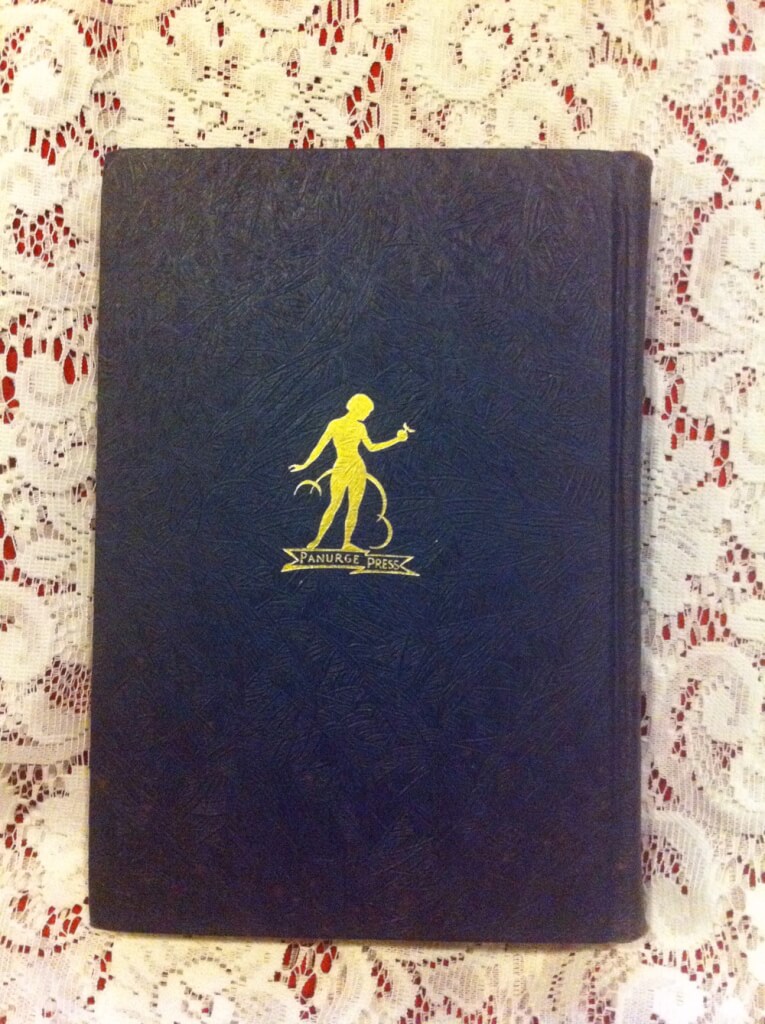
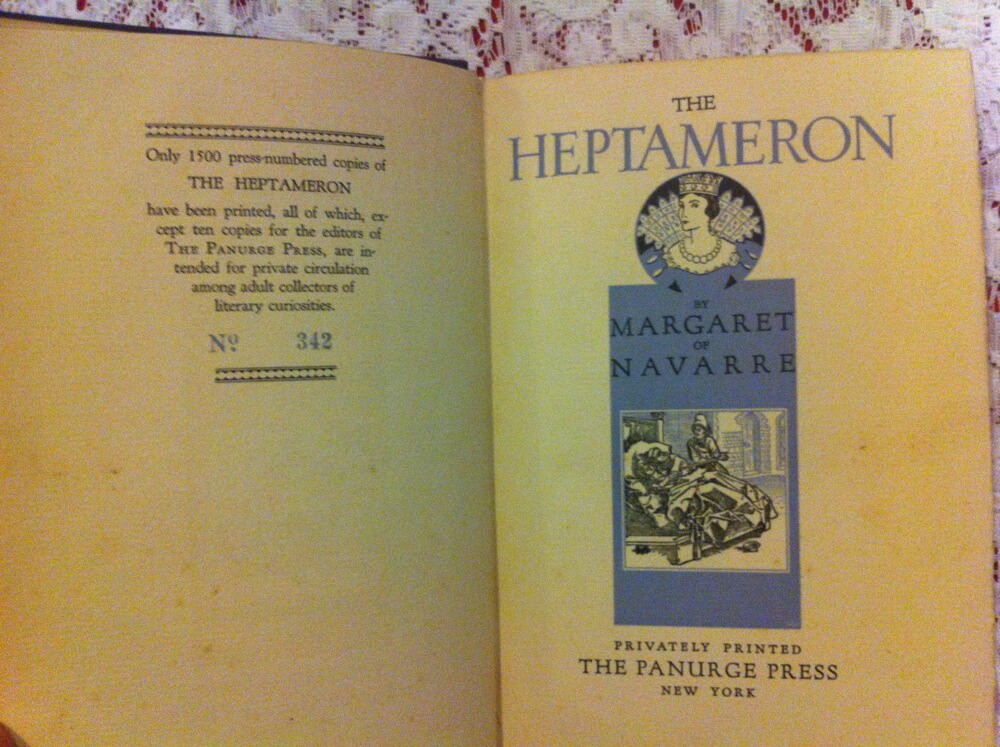 The Heptameron, of Margaret, Queen of Navarre, Margaret of Navarre, Léopold Flameng illus. (Printed by Private Subscription and for private circulation only, np. nd. London, #61/500) 6.25″ X 7.5″, xxix-384pp, three-quarter bound over marbled boards, gilt title & decorations including boarder of leather, 8 etchings by Flameng The Heptameron is a collection of 72 short stories written in French by Marguerite of Navarre (1492-1549), published posthumously in 1558. It has the form of a frame narrative and was inspired by The Decameron of Giovanni Boccaccio. It was originally intended to contain one hundred stories covering ten days just as The Decameron does, but at Marguerite’s death it was only completed as far as the second story of the eighth day. Many of the stories deal with love, lust, infidelity, and other romantic and sexual matters. I do not know publisher or date to this edition, although it is very similar to the 1881 G. Barrie edition (page numbers and the Flemeng plates, and the Edition De Luxe label). Either it is a later pirate of that edition or an alternate printing from that batch.
The Heptameron, of Margaret, Queen of Navarre, Margaret of Navarre, Léopold Flameng illus. (Printed by Private Subscription and for private circulation only, np. nd. London, #61/500) 6.25″ X 7.5″, xxix-384pp, three-quarter bound over marbled boards, gilt title & decorations including boarder of leather, 8 etchings by Flameng The Heptameron is a collection of 72 short stories written in French by Marguerite of Navarre (1492-1549), published posthumously in 1558. It has the form of a frame narrative and was inspired by The Decameron of Giovanni Boccaccio. It was originally intended to contain one hundred stories covering ten days just as The Decameron does, but at Marguerite’s death it was only completed as far as the second story of the eighth day. Many of the stories deal with love, lust, infidelity, and other romantic and sexual matters. I do not know publisher or date to this edition, although it is very similar to the 1881 G. Barrie edition (page numbers and the Flemeng plates, and the Edition De Luxe label). Either it is a later pirate of that edition or an alternate printing from that batch. -
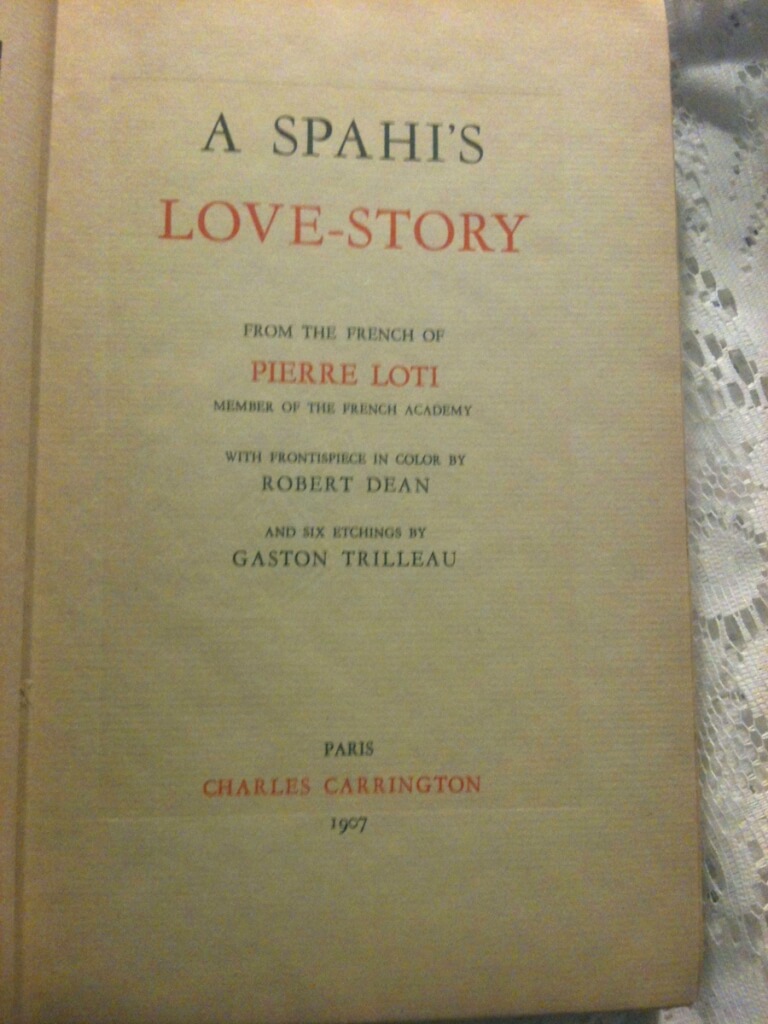
 A Spahi’s Love-Story, Pierre Loti [pseud. Julien Viaud], illus. Robert Dean, illus. Gaston Trilleau (Charles Carrington, Paris, 1907, #17/1000) 9″ x 5.75″, xii+330pp, hardbound, yellow cloth and batik design paper over boards, tipped-in color frontispiece, hand-made paper, deckled edges, good+ condition Julien Viaud (1850-1923) was a French novelist and naval officer. This his third novel (originally titled “Le Roman d’un Spahi”), was originally published in 1881. It recounts the tragic story in the dark middle ages of a Turkish soldier, who fell in love with a woman from a far away culture with a very different background. Color frontispiece by Robert Dean tipped in and six etchings by Gaston Trilleau throughout the book.
A Spahi’s Love-Story, Pierre Loti [pseud. Julien Viaud], illus. Robert Dean, illus. Gaston Trilleau (Charles Carrington, Paris, 1907, #17/1000) 9″ x 5.75″, xii+330pp, hardbound, yellow cloth and batik design paper over boards, tipped-in color frontispiece, hand-made paper, deckled edges, good+ condition Julien Viaud (1850-1923) was a French novelist and naval officer. This his third novel (originally titled “Le Roman d’un Spahi”), was originally published in 1881. It recounts the tragic story in the dark middle ages of a Turkish soldier, who fell in love with a woman from a far away culture with a very different background. Color frontispiece by Robert Dean tipped in and six etchings by Gaston Trilleau throughout the book. -
 La Génération de l' Homme ou Tableau de l' Amour Conjugal, considéré dans l'état du mariage, tome premier, Nicolas Venette (np 1776) 4″x6.75″, 365pp, vol. 1 only (of 2), full mottled calf, 5 raised bands, titles on spine are worn off, marbled boards loose but holding, fair condition for age. Illustrated throughout including a beautifully engraved frontispiece and title page, some illustrations are fold-outs. Nicolas Venette (1633–1698) was a physician, sexologist and French writer. Born in La Rochelle, he studied medicine at Bordeaux where he received his doctorate in 1656. He then went to Paris where he studied under Guy Patin and Pierre Petit, before travelling to Spain, Portugal and Italy. He then returned to La Rochelle, where he became Regius Professor of Anatomy and Surgery in 1668. First published in Amsterdam in 1686 as Tableau de l’amour humain considéré dans l’état du mariage (Table of human love considered in the state of marriage) under the pseudonym Salocini Venetian (anagram of Nicolas Venette), this book, more properly titled Table of conjugal love, or the complete history of the generation of man, is considered to be the first treatise on sexology in West. It proved to be a bestseller and was translated into English, Spanish, German and Dutch. There were 33 editions published sporadically until 1903. This edition was published in 1776 in two-volume. This book is volume 1. Many images are upgraded from previous editions to be fold-outs. The author discusses four sub-topics with respect to sex: anatomy, reproduction, desire, and impotence/infertility. For each topic, he reviews ancient and medieval authors, adding his own observations or those of later authors, and comments where common sense prevails. The resulting composition has an ambiguous mixture of seriousness and light-heartedness bordering upon erotic literature.
La Génération de l' Homme ou Tableau de l' Amour Conjugal, considéré dans l'état du mariage, tome premier, Nicolas Venette (np 1776) 4″x6.75″, 365pp, vol. 1 only (of 2), full mottled calf, 5 raised bands, titles on spine are worn off, marbled boards loose but holding, fair condition for age. Illustrated throughout including a beautifully engraved frontispiece and title page, some illustrations are fold-outs. Nicolas Venette (1633–1698) was a physician, sexologist and French writer. Born in La Rochelle, he studied medicine at Bordeaux where he received his doctorate in 1656. He then went to Paris where he studied under Guy Patin and Pierre Petit, before travelling to Spain, Portugal and Italy. He then returned to La Rochelle, where he became Regius Professor of Anatomy and Surgery in 1668. First published in Amsterdam in 1686 as Tableau de l’amour humain considéré dans l’état du mariage (Table of human love considered in the state of marriage) under the pseudonym Salocini Venetian (anagram of Nicolas Venette), this book, more properly titled Table of conjugal love, or the complete history of the generation of man, is considered to be the first treatise on sexology in West. It proved to be a bestseller and was translated into English, Spanish, German and Dutch. There were 33 editions published sporadically until 1903. This edition was published in 1776 in two-volume. This book is volume 1. Many images are upgraded from previous editions to be fold-outs. The author discusses four sub-topics with respect to sex: anatomy, reproduction, desire, and impotence/infertility. For each topic, he reviews ancient and medieval authors, adding his own observations or those of later authors, and comments where common sense prevails. The resulting composition has an ambiguous mixture of seriousness and light-heartedness bordering upon erotic literature. -
 2 books bound together: L'Onanisme, Dissertation Sur Les Maladies Produites Par La Masturbation, Samuel-Auguste Tissot (chez Marc Chapuis, Lausanne, 1778, 5th edition) Avis Au Peuple, Sur Les Asphyxies ou Morts Apparentes Et Subites: Contenant Les Moyens de les prevenir & d'y remedier, Avec La Description D'Une Nouvelle Boete fumigatoire portative. Publie par order du Gouvernement, Joseph-Jacques de Gardane (chez Rault, Paris, 1774) 4.25” x 6.25”, xiv+272pp + 114pp+2, bound in full calf, gilt title and decorations on spine, ex-libris V. Bertrand of Mareuil-sur-Lay (Vendée) France on front past-down. These two very notable medical books are bound together. Why are American men circumcised? Most people will offer some explanation to do with hygiene. But the real reason is that the Founding Fathers considered the presence of a foreskin an encouragement to masturbation, a vice which recent scientific research had shown threatened the very bedrock of civilisation. Their intellectual guide was one Samuel Auguste Tissot, a Swiss physician of the age of Enlightenment who cited self-pollution as responsible for a horde of ailments including jaundice, haemorrhoids, blindness, acne, insanity, epilepsy, delirium, tuberculosis, memory loss, paleness, pimples and death. Born in 1728 in Grancy, Switzerland, Tissot took up practice in Lausanne and became an expert on syphilis. Wrongly identifying the third-stage sequelae of syphilis as the results of excessive masturbation, he produced a book with two subtitles which became an international best-seller: Onanism: Or, a Treatise Upon the Disorders produced by Masturbation: Or, the Dangerous Effects of Secret and Excessive Venery (1760). In Onanism Tissot abandoned the moral and theological tone of previous commentators, taking the exclusively medical view that the human body had to maintain a delicate balance between nutrition on the one hand and fluid loss on the other. The emission of semen or vaginal fluid through repetitive, addictive non-procreative sex could tip the system into disastrous imbalance, especially since every ounce of the magic sexual excrement was equivalent to 40 ounces of blood. Tissot described a typical sufferer from excessive masturbation, or spermatorrhoea: “I went to his home; what I found was less a living being than a cadaver lying on straw, thin, pale, exuding a loathsome stench…A pale and watery blood often dripped from his nose, he drooled continually; subject to attacks of diarrhea, he defecated in his bed without noticing it; there was constant flow of semen…Thus sunk below the level of the beast, it was difficult to believe that he had once belonged to the human race.” Women could be tempted through a variety of stimuli, including novels, horseback riding, perfumes, corsets, feather beds, prolonged mental effort, pockets, bananas, society, solitude, spanking, rocking chairs and paintings (both oil and watercolor). “The humor they lose being less precious, less perfected than male sperm,” Tissot wrote humorlessly, “its loss does not perhaps weaken them as quickly, but when they indulge excessively, their nervous system being weaker and naturally more inclined to spasm, the troubles are more violent.” Joseph-Jacques de Gardane was a doctor and Royal Censor in Paris. In addition to the treatment of syphilis, he was concerned, as in this work, with the subject of asphyxiation death. In this rare work, translated as “Notice to the people, on asphyxia or related and sudden deaths. Contained here: The means to prevent them & their remedy. With the description of a new Boëte portable fumigator. Published by order of the Government” A medical revolution of the day when asphyxiation, like most maladies, was treated by leeches, Gardane’s approach to curing drowning was a “fumigator” which was a convenient invention for blowing tobacco smoke into the anus. Yes, LITERALLY blowing smoke up one’s ass! There are fold-out engravings with a diagram of the device and demonstration on its proper use.
2 books bound together: L'Onanisme, Dissertation Sur Les Maladies Produites Par La Masturbation, Samuel-Auguste Tissot (chez Marc Chapuis, Lausanne, 1778, 5th edition) Avis Au Peuple, Sur Les Asphyxies ou Morts Apparentes Et Subites: Contenant Les Moyens de les prevenir & d'y remedier, Avec La Description D'Une Nouvelle Boete fumigatoire portative. Publie par order du Gouvernement, Joseph-Jacques de Gardane (chez Rault, Paris, 1774) 4.25” x 6.25”, xiv+272pp + 114pp+2, bound in full calf, gilt title and decorations on spine, ex-libris V. Bertrand of Mareuil-sur-Lay (Vendée) France on front past-down. These two very notable medical books are bound together. Why are American men circumcised? Most people will offer some explanation to do with hygiene. But the real reason is that the Founding Fathers considered the presence of a foreskin an encouragement to masturbation, a vice which recent scientific research had shown threatened the very bedrock of civilisation. Their intellectual guide was one Samuel Auguste Tissot, a Swiss physician of the age of Enlightenment who cited self-pollution as responsible for a horde of ailments including jaundice, haemorrhoids, blindness, acne, insanity, epilepsy, delirium, tuberculosis, memory loss, paleness, pimples and death. Born in 1728 in Grancy, Switzerland, Tissot took up practice in Lausanne and became an expert on syphilis. Wrongly identifying the third-stage sequelae of syphilis as the results of excessive masturbation, he produced a book with two subtitles which became an international best-seller: Onanism: Or, a Treatise Upon the Disorders produced by Masturbation: Or, the Dangerous Effects of Secret and Excessive Venery (1760). In Onanism Tissot abandoned the moral and theological tone of previous commentators, taking the exclusively medical view that the human body had to maintain a delicate balance between nutrition on the one hand and fluid loss on the other. The emission of semen or vaginal fluid through repetitive, addictive non-procreative sex could tip the system into disastrous imbalance, especially since every ounce of the magic sexual excrement was equivalent to 40 ounces of blood. Tissot described a typical sufferer from excessive masturbation, or spermatorrhoea: “I went to his home; what I found was less a living being than a cadaver lying on straw, thin, pale, exuding a loathsome stench…A pale and watery blood often dripped from his nose, he drooled continually; subject to attacks of diarrhea, he defecated in his bed without noticing it; there was constant flow of semen…Thus sunk below the level of the beast, it was difficult to believe that he had once belonged to the human race.” Women could be tempted through a variety of stimuli, including novels, horseback riding, perfumes, corsets, feather beds, prolonged mental effort, pockets, bananas, society, solitude, spanking, rocking chairs and paintings (both oil and watercolor). “The humor they lose being less precious, less perfected than male sperm,” Tissot wrote humorlessly, “its loss does not perhaps weaken them as quickly, but when they indulge excessively, their nervous system being weaker and naturally more inclined to spasm, the troubles are more violent.” Joseph-Jacques de Gardane was a doctor and Royal Censor in Paris. In addition to the treatment of syphilis, he was concerned, as in this work, with the subject of asphyxiation death. In this rare work, translated as “Notice to the people, on asphyxia or related and sudden deaths. Contained here: The means to prevent them & their remedy. With the description of a new Boëte portable fumigator. Published by order of the Government” A medical revolution of the day when asphyxiation, like most maladies, was treated by leeches, Gardane’s approach to curing drowning was a “fumigator” which was a convenient invention for blowing tobacco smoke into the anus. Yes, LITERALLY blowing smoke up one’s ass! There are fold-out engravings with a diagram of the device and demonstration on its proper use. -
 The Life and Adventures of Father Silas | written by himself and now first translated from the original French edition (dated 1742), anonymous [attributed to Jean-Charles Gervaise de Latouche], (np [Charles Hirsch?], London, 1907) 7" X 4.5", 185pp, beautifully bound full red morocco with gilt border on boards, gilt decorations and title on spine, 5 raised bands, deckled edges, illustrations not present, good+ condition, slight internal foxing, a beautiful copy of a rare book. Originally published in French, Histoire de Dom Bougre, Portier des Chartreux is a French novel from 1741. Allegedly the anonymous author was Jean-Charles Gervaise de Latouche. Histoire de Dom Bougre is one of the most celebrated French erotic novels of the 18th century, and one of the most frequently reprinted. The novel was published under a variety of titles in French: Histoire de Dom B... (1741), Histoire de Gouberdom (1772), Mémoires de Saturnin (1787), Le Portier des chartreux (1784) and Histoire de Saturnin (1908). Translations into English have appeared under a similar variety of titles, such as The History of Don [sic] B. (1743), The Life and Adventures of Silas Shovewell (1801) and The History of Father Saturnin alias Don B*** alias Gouberdom – Porter of the Charterhouse at Paris (ca. 1827). The novel tells from the first-person perspective the life story of the monk B... (the acronym stands for Bougre, a French vulgar expression for pederast), whose real name is Saturnin. Saturnin's first sexual intercourse is with his sister Suzon and his mother. Even if it turns out later that in reality there is no blood relationship, the text heralds an incessant series of taboo breaking with this alleged incest. In the further course of numerous humorously designed scenes, Saturnin will experience all varieties of sexual disinhibition, whereby ruthless criticism of church and society is also practiced in constant alternation. Finally, Saturnin meets the syphilis sister in a brothel. He loves her sincerely and spends the night with her, although she warns him about the risk of infection. The two are torn apart the next day; Saturnin falls ill and is forcibly castrated to save his life, Suzon dies. In the end, Saturnin finds refuge in a Carthusian monastery, where, freed from all passions, he can await death, which he neither fears nor longs for. He would like the words: Hic situs est Dom Bougre, fututus, futuit (Here lies Dom Bougre, he fucked, and was fucked), to be inscribed on his grave. Jean-Charles Gervaise de Latouche (1715 - 1782), was a French writer. He was a lawyer at the Parlement de Paris of the Ancien Régime. The authorship of the licentious books Mémoires de Mademoiselle de Bonneval (1738), Histoire de Dom Bougre, Portier des Chartreux (1741), and possibly also Lyndamine, ou, L'optimisme des pays chauds (1778) has been attributed to him. Charles Hirsch was a French bookseller in Victorian London who sold French literature and ran a clandestine trade in expensive pornography. Hirsch's bookshop Librairie Parisienne was at Coventry Street, London. He also published in Paris and translated pornographic works from French to English and vice versa. Hirsch knew Oscar Wilde, and claimed to have sold him various works of erotica, including The Sins of the Cities of the Plain in 1890. Hirsch describes how Wilde brought the manuscript of Teleny to his bookshop in 1890 instructing that it be held until a friend, who would be carrying Wilde's card, came to retrieve it. "A few days later one of the young gentlemen I had seen with [Wilde] came to collect the package. He kept it for a while and then brought it back saying in turn: 'Would you kindly give this to one of our friends who will come to fetch it in the same person's name'". Hirsch recounts three further repetitions of this "identical ceremony" before the package made its way back to Wilde. Hirsch defied the strict instructions not to open the package while it was in his care, and claims that it was written in several different hands, which lends further support to his supposition that it was authored in "round robin" style by a small group of Wilde's intimate associates.
The Life and Adventures of Father Silas | written by himself and now first translated from the original French edition (dated 1742), anonymous [attributed to Jean-Charles Gervaise de Latouche], (np [Charles Hirsch?], London, 1907) 7" X 4.5", 185pp, beautifully bound full red morocco with gilt border on boards, gilt decorations and title on spine, 5 raised bands, deckled edges, illustrations not present, good+ condition, slight internal foxing, a beautiful copy of a rare book. Originally published in French, Histoire de Dom Bougre, Portier des Chartreux is a French novel from 1741. Allegedly the anonymous author was Jean-Charles Gervaise de Latouche. Histoire de Dom Bougre is one of the most celebrated French erotic novels of the 18th century, and one of the most frequently reprinted. The novel was published under a variety of titles in French: Histoire de Dom B... (1741), Histoire de Gouberdom (1772), Mémoires de Saturnin (1787), Le Portier des chartreux (1784) and Histoire de Saturnin (1908). Translations into English have appeared under a similar variety of titles, such as The History of Don [sic] B. (1743), The Life and Adventures of Silas Shovewell (1801) and The History of Father Saturnin alias Don B*** alias Gouberdom – Porter of the Charterhouse at Paris (ca. 1827). The novel tells from the first-person perspective the life story of the monk B... (the acronym stands for Bougre, a French vulgar expression for pederast), whose real name is Saturnin. Saturnin's first sexual intercourse is with his sister Suzon and his mother. Even if it turns out later that in reality there is no blood relationship, the text heralds an incessant series of taboo breaking with this alleged incest. In the further course of numerous humorously designed scenes, Saturnin will experience all varieties of sexual disinhibition, whereby ruthless criticism of church and society is also practiced in constant alternation. Finally, Saturnin meets the syphilis sister in a brothel. He loves her sincerely and spends the night with her, although she warns him about the risk of infection. The two are torn apart the next day; Saturnin falls ill and is forcibly castrated to save his life, Suzon dies. In the end, Saturnin finds refuge in a Carthusian monastery, where, freed from all passions, he can await death, which he neither fears nor longs for. He would like the words: Hic situs est Dom Bougre, fututus, futuit (Here lies Dom Bougre, he fucked, and was fucked), to be inscribed on his grave. Jean-Charles Gervaise de Latouche (1715 - 1782), was a French writer. He was a lawyer at the Parlement de Paris of the Ancien Régime. The authorship of the licentious books Mémoires de Mademoiselle de Bonneval (1738), Histoire de Dom Bougre, Portier des Chartreux (1741), and possibly also Lyndamine, ou, L'optimisme des pays chauds (1778) has been attributed to him. Charles Hirsch was a French bookseller in Victorian London who sold French literature and ran a clandestine trade in expensive pornography. Hirsch's bookshop Librairie Parisienne was at Coventry Street, London. He also published in Paris and translated pornographic works from French to English and vice versa. Hirsch knew Oscar Wilde, and claimed to have sold him various works of erotica, including The Sins of the Cities of the Plain in 1890. Hirsch describes how Wilde brought the manuscript of Teleny to his bookshop in 1890 instructing that it be held until a friend, who would be carrying Wilde's card, came to retrieve it. "A few days later one of the young gentlemen I had seen with [Wilde] came to collect the package. He kept it for a while and then brought it back saying in turn: 'Would you kindly give this to one of our friends who will come to fetch it in the same person's name'". Hirsch recounts three further repetitions of this "identical ceremony" before the package made its way back to Wilde. Hirsch defied the strict instructions not to open the package while it was in his care, and claims that it was written in several different hands, which lends further support to his supposition that it was authored in "round robin" style by a small group of Wilde's intimate associates.






















